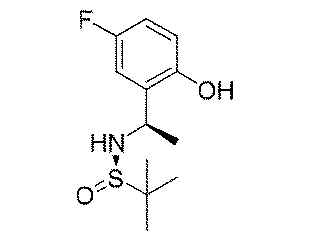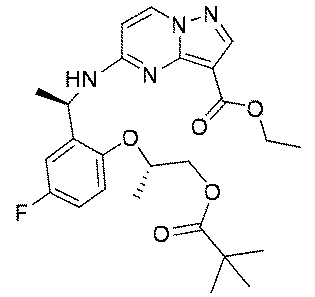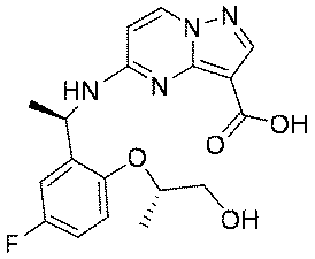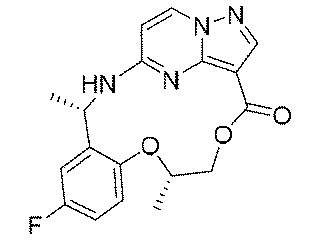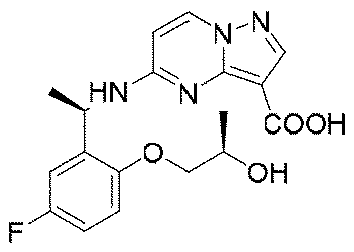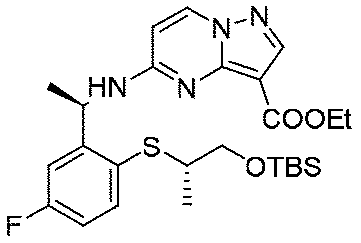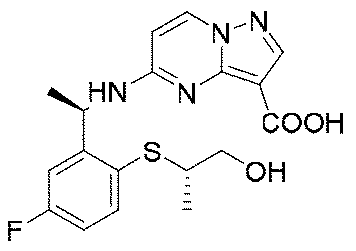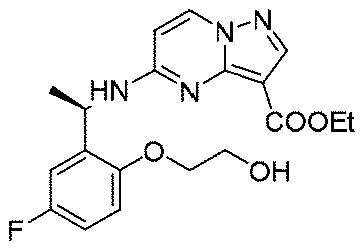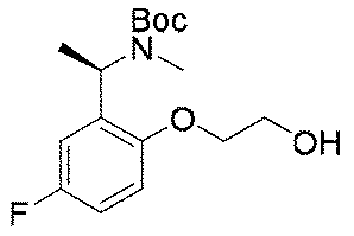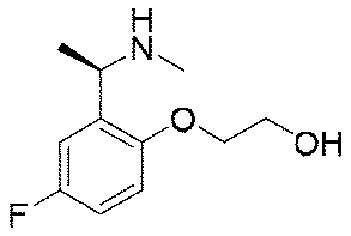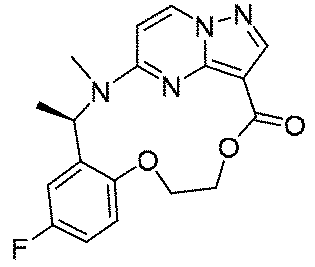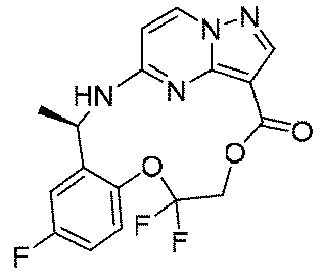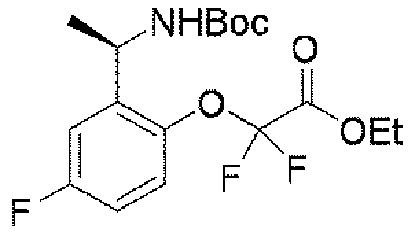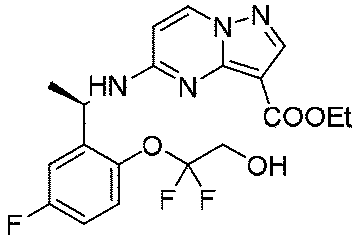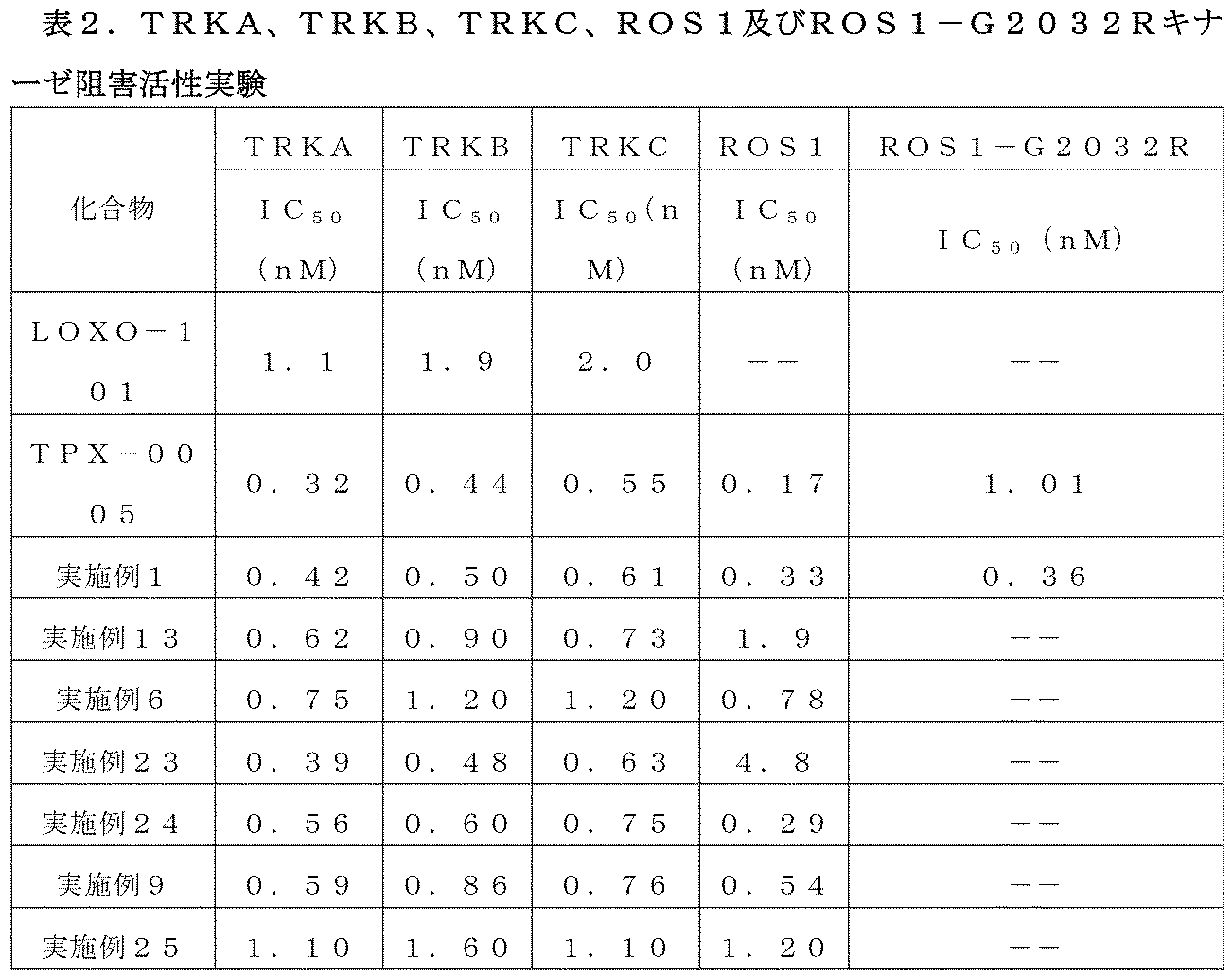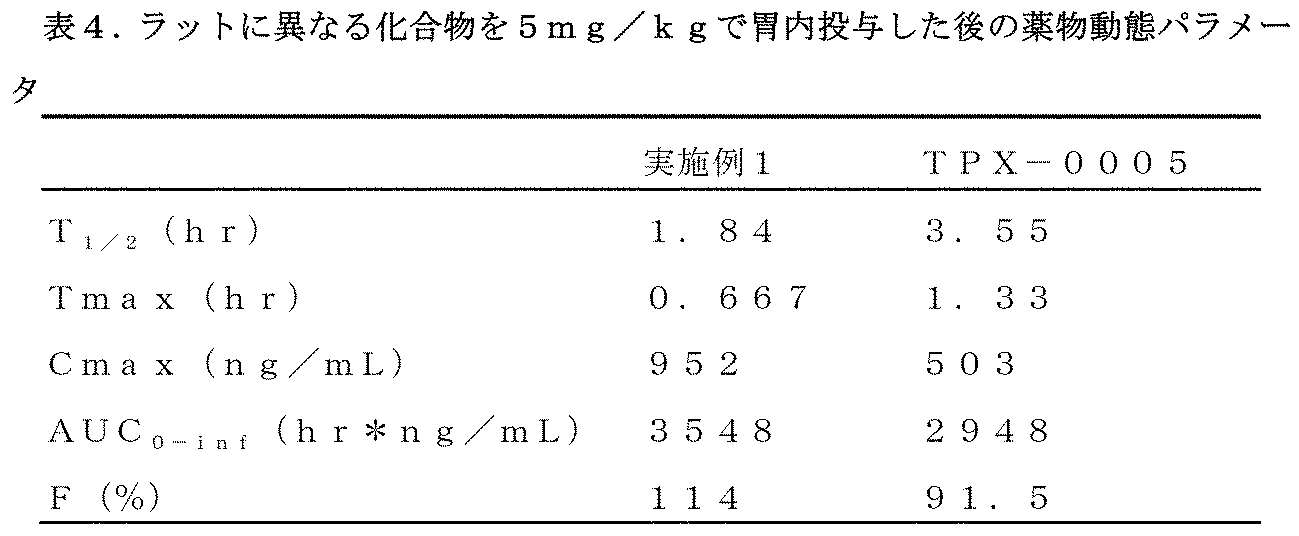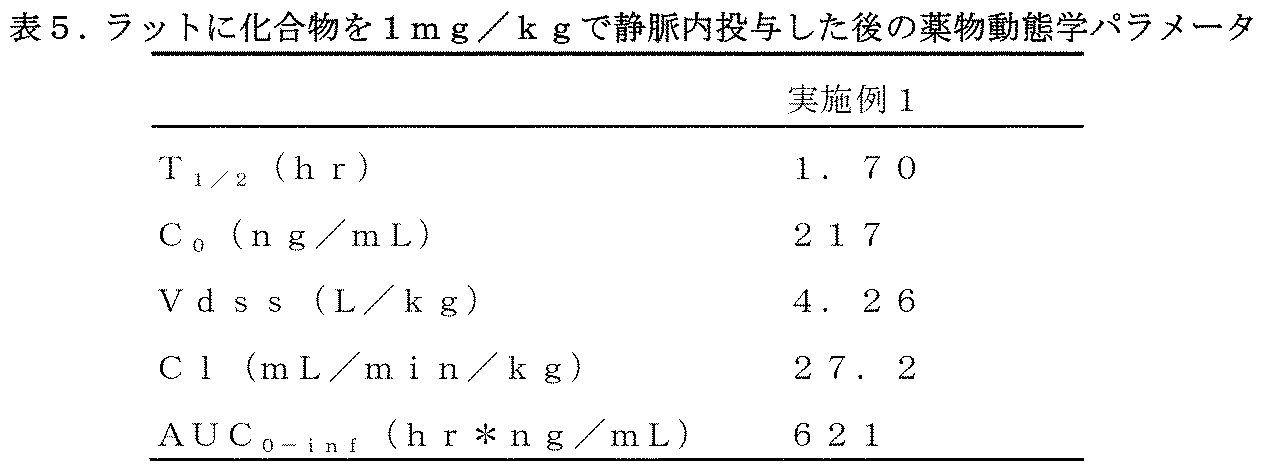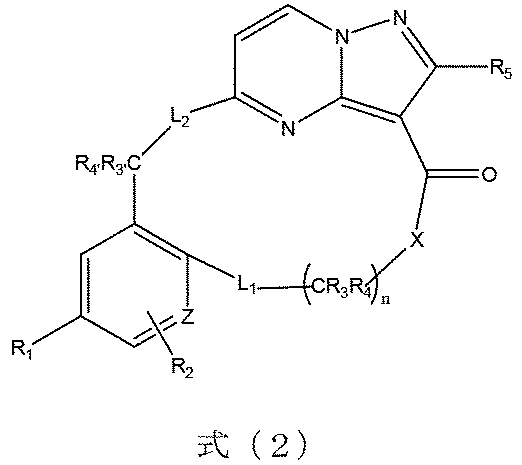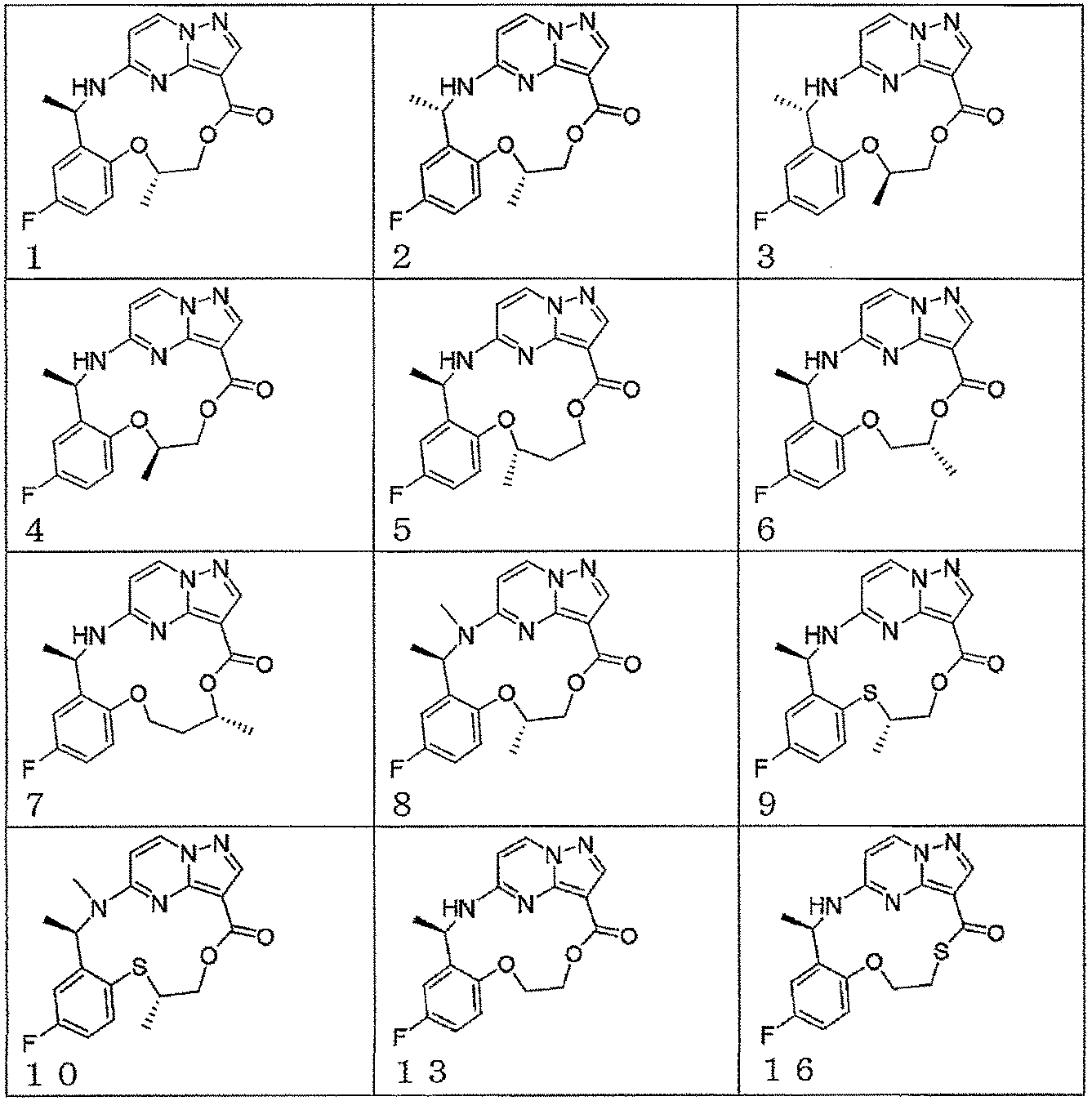JP7128345B2 - Diaryl macrocyclic compound, pharmaceutical composition and use thereof - Google Patents
Diaryl macrocyclic compound, pharmaceutical composition and use thereof Download PDFInfo
- Publication number
- JP7128345B2 JP7128345B2 JP2021508050A JP2021508050A JP7128345B2 JP 7128345 B2 JP7128345 B2 JP 7128345B2 JP 2021508050 A JP2021508050 A JP 2021508050A JP 2021508050 A JP2021508050 A JP 2021508050A JP 7128345 B2 JP7128345 B2 JP 7128345B2
- Authority
- JP
- Japan
- Prior art keywords
- group
- compound
- mmol
- ethyl
- pharmaceutically acceptable
- Prior art date
- Legal status (The legal status is an assumption and is not a legal conclusion. Google has not performed a legal analysis and makes no representation as to the accuracy of the status listed.)
- Active
Links
Images
Classifications
-
- C—CHEMISTRY; METALLURGY
- C07—ORGANIC CHEMISTRY
- C07D—HETEROCYCLIC COMPOUNDS
- C07D487/00—Heterocyclic compounds containing nitrogen atoms as the only ring hetero atoms in the condensed system, not provided for by groups C07D451/00 - C07D477/00
- C07D487/12—Heterocyclic compounds containing nitrogen atoms as the only ring hetero atoms in the condensed system, not provided for by groups C07D451/00 - C07D477/00 in which the condensed system contains three hetero rings
- C07D487/14—Ortho-condensed systems
-
- C—CHEMISTRY; METALLURGY
- C07—ORGANIC CHEMISTRY
- C07D—HETEROCYCLIC COMPOUNDS
- C07D498/00—Heterocyclic compounds containing in the condensed system at least one hetero ring having nitrogen and oxygen atoms as the only ring hetero atoms
- C07D498/12—Heterocyclic compounds containing in the condensed system at least one hetero ring having nitrogen and oxygen atoms as the only ring hetero atoms in which the condensed system contains three hetero rings
- C07D498/16—Peri-condensed systems
-
- A—HUMAN NECESSITIES
- A61—MEDICAL OR VETERINARY SCIENCE; HYGIENE
- A61P—SPECIFIC THERAPEUTIC ACTIVITY OF CHEMICAL COMPOUNDS OR MEDICINAL PREPARATIONS
- A61P35/00—Antineoplastic agents
-
- C—CHEMISTRY; METALLURGY
- C07—ORGANIC CHEMISTRY
- C07D—HETEROCYCLIC COMPOUNDS
- C07D498/00—Heterocyclic compounds containing in the condensed system at least one hetero ring having nitrogen and oxygen atoms as the only ring hetero atoms
- C07D498/22—Heterocyclic compounds containing in the condensed system at least one hetero ring having nitrogen and oxygen atoms as the only ring hetero atoms in which the condensed system contains four or more hetero rings
-
- C—CHEMISTRY; METALLURGY
- C07—ORGANIC CHEMISTRY
- C07D—HETEROCYCLIC COMPOUNDS
- C07D515/00—Heterocyclic compounds containing in the condensed system at least one hetero ring having nitrogen, oxygen, and sulfur atoms as the only ring hetero atoms, not provided for in groups C07D463/00, C07D477/00 or C07D499/00 - C07D507/00
- C07D515/12—Heterocyclic compounds containing in the condensed system at least one hetero ring having nitrogen, oxygen, and sulfur atoms as the only ring hetero atoms, not provided for in groups C07D463/00, C07D477/00 or C07D499/00 - C07D507/00 in which the condensed system contains three hetero rings
- C07D515/14—Ortho-condensed systems
-
- C—CHEMISTRY; METALLURGY
- C07—ORGANIC CHEMISTRY
- C07D—HETEROCYCLIC COMPOUNDS
- C07D515/00—Heterocyclic compounds containing in the condensed system at least one hetero ring having nitrogen, oxygen, and sulfur atoms as the only ring hetero atoms, not provided for in groups C07D463/00, C07D477/00 or C07D499/00 - C07D507/00
- C07D515/12—Heterocyclic compounds containing in the condensed system at least one hetero ring having nitrogen, oxygen, and sulfur atoms as the only ring hetero atoms, not provided for in groups C07D463/00, C07D477/00 or C07D499/00 - C07D507/00 in which the condensed system contains three hetero rings
- C07D515/16—Peri-condensed systems
Description
本発明は、医薬分野に関し、詳しくは、ジアリール大員環化合物、それを含む医薬組成物及びその用途に関する。 TECHNICAL FIELD The present invention relates to the field of medicine, and more particularly to diaryl macrocyclic compounds, pharmaceutical compositions containing the same, and uses thereof.
本願は、2018年04月25日に出願された、出願番号が201810377811.1号である中国発明特許出願に基づき優先権を主張し、その内容全体が本願に本開示の一部として援用される。 This application claims priority from the Chinese invention patent application numbered 201810377811.1 filed on April 25, 2018, the entire content of which is incorporated herein by reference as part of the present disclosure. .
プロテインキナーゼは、細胞の成長、増殖及び生存の重要な調節剤である。癌、疼痛、神経疾患、自己免疫疾患、及び炎症を含む複数種の疾患は、TRK、ROS1、ALK、JAK2、SRC、FAK、FYN、LYN、YES、FGR、FAK、ARK5、AXLなどの受容体型チロシンキナーゼが介在するものである。 Protein kinases are important regulators of cell growth, proliferation and survival. Multiple diseases, including cancer, pain, neurological diseases, autoimmune diseases, and inflammation, are characterized by receptor types such as TRK, ROS1, ALK, JAK2, SRC, FAK, FYN, LYN, YES, FGR, FAK, ARK5, AXL. It is mediated by tyrosine kinases.
神経栄養因子チロシンキナーゼ受容体(NTRK/TRK)は、受容体型チロシンキナーゼファミリーに属する。TRKファミリーは、主にNTRK1/TRKA、NTRK2/TRKB、NTRK3/TRKCという3つのメンバーを含む。TRK融合タンパク質は、腫瘍と密接に関連しており、CD74-NTRK1、MPRIP-NTRK1、QKI-NTRK2、ETV6-NTRK3、BTB1-NTRK3などの複数種の融合タンパク質は、結腸癌、肺癌、頭頸部癌、乳癌、甲状腺癌、神経膠腫などの複数種の腫瘍で発見された。従って、近年、TRK融合タンパク質は、既に抗癌有効なターゲット及び研究のホットスポットとなっており、例えばWO2010048314、WO2010033941などは、いずれも異なる母核を持つTRKキナーゼ阻害剤を開示している。なお、持続投与後に現れるターゲット変異は、腫瘍に薬剤耐性が生じる重要な原因である。最近、臨床においてNTRK1 G595R及びG667Cの変異(Russo Mなど、Cancer Discovery、2016、6(1)、36-44)、NTRK3 G623Rの変異(Drilon A.など、Annals of Oncology 2016、27(5)、920-926)など、NTRK変異の症例が既に見られた。新たなTRKキナーゼ阻害剤を見出すことによって、NTRK変異による腫瘍の薬剤耐性の問題を解決することが期待される。 Neurotrophic factor tyrosine kinase receptor (NTRK/TRK) belongs to the receptor-type tyrosine kinase family. The TRK family mainly includes three members: NTRK1/TRKA, NTRK2/TRKB and NTRK3/TRKC. TRK fusion proteins are closely associated with tumors, and multiple fusion proteins such as CD74-NTRK1, MPRIP-NTRK1, QKI-NTRK2, ETV6-NTRK3, BTB1-NTRK3 are associated with colon, lung, head and neck cancers. It has been found in multiple types of tumors, including breast cancer, thyroid cancer, and glioma. Therefore, in recent years, TRK fusion proteins have already become effective anti-cancer targets and research hotspots. Targeted mutations that appear after continuous administration are important causes of drug resistance in tumors. Recently, NTRK1 G595R and G667C mutations (Russo M et al., Cancer Discovery, 2016, 6(1), 36-44), NTRK3 G623R mutations (Drilon A. et al., Annals of Oncology 2016, 27(5), 920-926) have already seen cases of NTRK mutations. Finding new TRK kinase inhibitors is expected to solve the problem of tumor drug resistance due to NTRK mutations.
ALK(Anaplastic lymphoma kinase)阻害剤は、異常なALK遺伝子を有する肺癌患者に対する治療において大きな成功を遂げたが、腫瘍の薬剤耐性の出現によって、これらの薬物の長期臨床使用が制限される。薬剤耐性のメカニズムは、通常、標的遺伝子の増幅、後天性薬剤耐性変異、バイパス及び下流経路の活性化、上皮間葉転換及び腫瘍の転移などを含む。現在市販されているALK阻害剤には、バイパスの活性化や上皮間葉転換による薬剤耐性を克服できるものはない。多重耐性メカニズムを同時に克服できるALK阻害剤を開発することが強く要望されている。 Anaplastic lymphoma kinase (ALK) inhibitors have achieved great success in treating lung cancer patients with aberrant ALK genes, but the emergence of drug resistance in tumors limits long-term clinical use of these drugs. Mechanisms of drug resistance typically include target gene amplification, acquired drug resistance mutations, bypass and activation of downstream pathways, epithelial-mesenchymal transition and tumor metastasis. None of the currently marketed ALK inhibitors can overcome drug resistance due to bypass activation and epithelial-mesenchymal transition. There is a strong need to develop ALK inhibitors that can simultaneously overcome multiple resistance mechanisms.
ROS1キナーゼは、遺伝子再構成後、例えば膠芽腫、非小細胞肺癌、胆管癌、卵巣癌、胃腺癌、結腸直腸癌、炎症性筋線維芽細胞腫、血管肉腫、類上皮血管内皮腫などの様々な癌において構成型活性融合タンパク質(constitutive active fusion proteins)を産生し、ROS1融合タンパク質を阻害することによって、ROS1陽性の腫瘍を効果的に抑制することができる。FDAは、既にALK陽性の非小細胞肺癌を治療する複数の新薬を承認しているが、ROS1陽性の非小細胞肺癌患者の場合、選択可能な薬は、依然として有限のものであり、現在、ROS1陽性の非小細胞肺癌の治療にはクリゾチニブのみが承認されている。なお、クリゾチニブの臨床使用において、後天性薬剤耐性は既に現れており、薬剤耐性の変異部位は、主にROS1 G2032及びROS1 L2026Mである。野生及び多剤耐性変異に対するROS1阻害剤を開発することが強く要望されている。 After gene rearrangement, ROS1 kinase is used in glioblastoma, non-small cell lung cancer, cholangiocarcinoma, ovarian cancer, gastric adenocarcinoma, colorectal cancer, inflammatory myofibroblastoma, angiosarcoma, epithelioid hemangioendothelioma, and the like. By producing constitutive active fusion proteins and inhibiting ROS1 fusion proteins in various cancers, ROS1-positive tumors can be effectively suppressed. The FDA has already approved several new drugs to treat ALK-positive non-small cell lung cancer, but for patients with ROS1-positive non-small cell lung cancer, the drug options remain limited and currently Only crizotinib is approved for the treatment of ROS1-positive non-small cell lung cancer. In the clinical use of crizotinib, acquired drug resistance has already appeared, and the mutation sites of drug resistance are mainly ROS1 G2032 and ROS1 L2026M. There is a strong need to develop ROS1 inhibitors against wild and multidrug resistant mutants.
EGFR阻害剤は、非小細胞肺癌患者に対する治療において大きな成功を遂げたが、腫瘍の薬剤耐性も現れている。EGFR薬剤耐性の人々では、MET、CDCP1、AXL、SHP2などの複数種のシグナル経路の過剰発現が発見されている。なお、STAT3及びSrc-YAP1シグナル経路もEGFR阻害剤の治療効果に影響を与える一方、JAK2は、下流のSTAT3の発現を調節することができる。JAK2、Src/FAK、AXLに作用する多重阻害剤の開発によって、EGFR阻害剤と併用してバイパス代償性のEGFR耐性を克服することが期待される。 Although EGFR inhibitors have achieved great success in treating patients with non-small cell lung cancer, tumor drug resistance is also emerging. Overexpression of multiple signaling pathways, including MET, CDCP1, AXL, and SHP2, has been found in EGFR drug-resistant people. It should be noted that JAK2 can regulate downstream expression of STAT3, while STAT3 and Src-YAP1 signaling pathways also influence the therapeutic efficacy of EGFR inhibitors. The development of multiple inhibitors acting on JAK2, Src/FAK, and AXL is expected to overcome bypass compensatory EGFR resistance in combination with EGFR inhibitors.
本発明の1つの目的は、優れたチロシンキナーゼ阻害活性を有する新規化合物又はその薬学的に許容される塩、溶媒和物、活性代謝物、多形体、同位体標識物、異性体又はプロドラッグを提供することである。 One object of the present invention is to provide novel compounds or pharmaceutically acceptable salts, solvates, active metabolites, polymorphs, isotope-labeled products, isomers or prodrugs thereof having excellent tyrosine kinase inhibitory activity. to provide.
本発明の他の目的は、医薬組成物を提供することである。 Another object of the present invention is to provide pharmaceutical compositions.
本発明の別の目的は、新規化合物又はその薬学的に許容される塩、溶媒和物、活性代謝物、多形体、同位体標識物、異性体又はプロドラッグの用途を提供することである。 Another object of the present invention is to provide a use of the novel compounds or their pharmaceutically acceptable salts, solvates, active metabolites, polymorphs, isotopic labels, isomers or prodrugs thereof.
本発明は、式(1)で示される化合物又はその薬学的に許容される塩、溶媒和物、活性代謝物、多形体、同位体標識物、異性体又はプロドラッグを提供し、
式(1)において、Xは、-O-、-S-又は-CRaRb-から選ばれ、Ra、Rbは、それぞれ独立して置換若しくは無置換の水素、ハロゲン、C1~8アルキル基、C1~8アルコキシ基、C1~8ハロゲン化アルキル基、C3~8シクロアルキル基、C3~8複素環基、C6~20アリール基、C5~20ヘテロアリール基、ヒドロキシ基、メルカプト基、カルボキシル基、エステル基、アシル基、アミノ基、アミド基、スルホニル基、シアノ基から選ばれるか、又は、CRaRbは共同して3~10員のシクロアルキル基又は少なくとも1つのヘテロ原子を含有する3~10員の複素環基を形成し、L1は、-O-、-S-、-S(=O)-、-S(=O)2-、-NR6-から選ばれるか、又は、単結合であり、L2は、-O-、-S-、-S(=O)-、-S(=O)2-又は-NR6-から選ばれ、R1、R2、R5は、それぞれ独立して置換若しくは無置換の水素、ハロゲン、C1~8アルキル基、C1~8アルコキシ基、C1~8ハロゲン化アルキル基、C3~8シクロアルキル基、C3~8複素環基、C6~20アリール基、C5~20ヘテロアリール基、ヒドロキシ基、メルカプト基、カルボキシル基、エステル基、アシル基、アミノ基、アミド基、スルホニル基又はシアノ基から選ばれ、各C原子上の置換基R3、R4は、それぞれ独立して置換若しくは無置換の水素、ハロゲン、C1~8アルキル基、C1~8アルコキシ基、C1~8ハロゲン化アルキル基、C3~8シクロアルキル基、C3~8複素環基、C6~20アリール基、C5~20ヘテロアリール基、ヒドロキシ基、メルカプト基、カルボキシル基、エステル基、アシル基、アミノ基、アミド基、スルホニル基、シアノ基から選ばれるか、又は、X基と共に3~10員のシクロアルキル基、少なくとも1つのヘテロ原子を含有する3~10員の複素環基又は少なくとも1つのヘテロ原子を含有する5~10員のヘテロアリール基を形成するか、又は、R3、R4は、それぞれ独立して前記C原子と隣接する大員環の環原子とを結合する単結合である。
The present invention provides a compound represented by formula (1) or a pharmaceutically acceptable salt, solvate, active metabolite, polymorph, isotopically labeled product, isomer or prodrug thereof,
In formula (1), X is selected from -O-, -S- or -CR a R b -, and R a and R b are each independently substituted or unsubstituted hydrogen, halogen, C 1- 8 alkyl group, C 1-8 alkoxy group, C 1-8 halogenated alkyl group, C 3-8 cycloalkyl group, C 3-8 heterocyclic group, C 6-20 aryl group, C 5-20 heteroaryl group , a hydroxy group, a mercapto group, a carboxyl group, an ester group, an acyl group, an amino group, an amide group, a sulfonyl group, a cyano group, or CR a R b jointly a 3- to 10-membered cycloalkyl group or form a 3- to 10-membered heterocyclic group containing at least one heteroatom, and L 1 is -O-, -S-, -S(=O)-, -S(=O) 2 -, is selected from -NR 6 - or is a single bond, and L 2 is from -O-, -S-, -S(=O)-, -S(=O) 2 - or -NR 6 - R 1 , R 2 and R 5 are each independently substituted or unsubstituted hydrogen, halogen, C 1-8 alkyl group, C 1-8 alkoxy group, C 1-8 halogenated alkyl group, C 3-8 cycloalkyl group, C 3-8 heterocyclic group, C 6-20 aryl group, C 5-20 heteroaryl group, hydroxy group, mercapto group, carboxyl group, ester group, acyl group, amino group, amide group , a sulfonyl group or a cyano group, and the substituents R 3 and R 4 on each C atom are each independently substituted or unsubstituted hydrogen, halogen, C 1-8 alkyl group, C 1-8 alkoxy group , C 1-8 halogenated alkyl group, C 3-8 cycloalkyl group, C 3-8 heterocyclic group, C 6-20 aryl group, C 5-20 heteroaryl group, hydroxy group, mercapto group, carboxyl group, selected from an ester group, an acyl group, an amino group, an amide group, a sulfonyl group, a cyano group; forming a cyclic group or a 5- to 10-membered heteroaryl group containing at least one heteroatom, or R 3 , R 4 are each independently combined with a macrocyclic ring atom adjacent to said C atom; is a single bond that connects
R3’、R4’は、それぞれ独立して置換若しくは無置換の水素、ハロゲン、C1~8アルキル基、C1~8アルコキシ基、C1~8ハロゲン化アルキル基、C3~8シクロアルキル基、C3~8複素環基、C6~20アリール基、C5~20ヘテロアリール基、ヒドロキシ基、メルカプト基、カルボキシル基、エステル基、アシル基、アミノ基、アミド基、スルホニル基、シアノ基から選ばれるか、又は、結合しているC及L2と共に少なくとも1つのヘテロ原子を含有する3~10員の複素環基又は少なくとも1つのヘテロ原子を含有する5~10員のヘテロアリール基を形成し、R6は、置換若しくは無置換の水素、ハロゲン、C1~8アルキル基、C1~8アルコキシ基、C1~8ハロゲン化アルキル基、C3~8シクロアルキル基、C3~8複素環基、C6~20アリール基、C5~20ヘテロアリール基、ヒドロキシ基、メルカプト基、カルボキシル基、エステル基、アシル基、アミノ基、アミド基、スルホニル基又はシアノ基から選ばれ、Zは、環原子としてC又はヘテロ原子を表し、nは、1~10の整数を表し、前記基の置換基は、ハロゲン、C1~8アルキル基、C1~8ハロゲン化アルキル基、C1~8アルコキシ基、C3~8シクロアルキル基、C3~8複素環基、C6~20アリール基、C5~20ヘテロアリール基、ヒドロキシ基、メルカプト基、カルボキシル基、エステル基、アシル基、アミノ基、アミド基、スルホニル基又はシアノ基から選ばれ、前記ヘテロ原子は、N、O又はSから選ばれる。 R 3′ and R 4′ are each independently substituted or unsubstituted hydrogen, halogen, C 1-8 alkyl group, C 1-8 alkoxy group, C 1-8 halogenated alkyl group, C 3-8 cyclo alkyl group, C 3-8 heterocyclic group, C 6-20 aryl group, C 5-20 heteroaryl group, hydroxy group, mercapto group, carboxyl group, ester group, acyl group, amino group, amide group, sulfonyl group, 3- to 10-membered heterocyclic group containing at least one heteroatom or 5- to 10-membered heteroaryl containing at least one heteroatom selected from a cyano group or, together with attached C and L 2 R 6 is substituted or unsubstituted hydrogen, halogen, C 1-8 alkyl group, C 1-8 alkoxy group, C 1-8 halogenated alkyl group, C 3-8 cycloalkyl group, C selected from 3-8 heterocyclic group, C 6-20 aryl group, C 5-20 heteroaryl group, hydroxy group, mercapto group, carboxyl group, ester group, acyl group, amino group, amide group, sulfonyl group or cyano group; , Z represents a C or heteroatom as a ring atom, n represents an integer of 1 to 10, and the substituents of the above groups are halogen, C 1-8 alkyl group, C 1-8 halogenated alkyl group , C 1-8 alkoxy group, C 3-8 cycloalkyl group, C 3-8 heterocyclic group, C 6-20 aryl group, C 5-20 heteroaryl group, hydroxy group, mercapto group, carboxyl group, ester group , an acyl group, an amino group, an amido group, a sulfonyl group or a cyano group, and said heteroatom is selected from N, O or S.
選択的に、式(1)における不飽和単環は、他の類似した構造で置換されていてもよく、例えば、環において1つ又は複数のO、S、Nなどのヘテロ原子を追加してもよい。例えば、式(1)に示される環原子「Z」は、Nを表すことができる。 Optionally, the unsaturated monocyclic ring in formula (1) may be substituted with other analogous structures, e.g., by adding one or more heteroatoms such as O, S, N, etc. in the ring. good too. For example, the ring atom 'Z' shown in formula (1) can represent N.
選択的に、式(1)における2員のヘテロアリール基
は、他の類似した構造で置換されていてもよく、例えば、N原子の置換位置を変更したり、環において1つ又は複数のN原子を追加又は減少したりしてもよい。好ましくは、
又は
で置換されている。
Optionally, a 2-membered heteroaryl group in formula (1)
may be substituted with other similar structures, such as changing the substitution position of the N atom or adding or subtracting one or more N atoms in the ring. Preferably,
or
is replaced by
上記の式(1)において、Ra、Rb、R1、R2、R3、R4、R3’、R4’、R5、R6及びその選択可能な置換基で表される基は、以下の基を含むが、これらに限定されない。 Represented by R a , R b , R 1 , R 2 , R 3 , R 4 , R 3′ , R 4′ , R 5 , R 6 and optional substituents thereof in the above formula (1) Groups include, but are not limited to, the following groups.
水素は、-Hで表され、二重水素、三重水素などの同位体で置換されていてもよい。 Hydrogen is represented by —H and may be substituted with isotopes such as double hydrogen and tritium.
ハロゲンは、フッ素、塩素、臭素、ヨウ素を含んでもよい。 Halogens may include fluorine, chlorine, bromine and iodine.
C1~8アルキル基は、メチル基、エチル基、n-プロピル基、イソプロピル基、2-メチル-l-プロピル基、2-メチル-2-プロピル基、2-メチル-1-ブチル基、3-メチル-l-ブチル基、2-メチル-3-ブチル基、2,2-ジメチル-1-プロピル基、2-メチル-1-ペンチル基、3-メチル-1-ペンチル基、4-メチル-l-ペンチル基、2-メチル-2-ペンチル基、3-メチル-2-ペンチル基、4-メチル-2-ペンチル基、2,2-ジメチル-l-ブチル基、3,3-ジメチル-1-ブチル基、2-エチル-1-ブチル基、n-ブチル基、イソブチル基、s-ブチル基、t-ブチル基、n-ペンチル基、イソペンチル基、ネオペンチル基、t-ペンチル基、ヘキシル基、ヘプチル基、オクチル基などを含んでもよい。 C 1-8 alkyl group is methyl group, ethyl group, n-propyl group, isopropyl group, 2-methyl-l-propyl group, 2-methyl-2-propyl group, 2-methyl-1-butyl group, 3 -methyl-l-butyl group, 2-methyl-3-butyl group, 2,2-dimethyl-1-propyl group, 2-methyl-1-pentyl group, 3-methyl-1-pentyl group, 4-methyl- l-pentyl group, 2-methyl-2-pentyl group, 3-methyl-2-pentyl group, 4-methyl-2-pentyl group, 2,2-dimethyl-l-butyl group, 3,3-dimethyl-1 -butyl group, 2-ethyl-1-butyl group, n-butyl group, isobutyl group, s-butyl group, t-butyl group, n-pentyl group, isopentyl group, neopentyl group, t-pentyl group, hexyl group, A heptyl group, an octyl group, and the like may be included.
C1~8アルコキシ基は、-OC1~8アルキル基で表され、その中のC1~8アルキル基に含まれる基は、上記と同義である。例えば、C1~8アルコキシ基は、メトキシ基、エトキシ基、n-プロポキシ基、イソプロポキシ基、n-ブトキシ、イソブトキシ基、s-ブトキシ基、t-ブトキシ基などを含んでもよい。 The C 1-8 alkoxy group is represented by an —OC 1-8 alkyl group, and the groups included in the C 1-8 alkyl group are as defined above. For example, a C 1-8 alkoxy group may include methoxy, ethoxy, n-propoxy, isopropoxy, n-butoxy, isobutoxy, s-butoxy, t-butoxy, and the like.
C1~8ハロゲン化アルキル基は、C1~8アルキル基における任意の数の水素原子がハロゲンで置換された基で表され、その中のC1~8アルキル基、ハロゲン基に含まれる基は、上記と同義である。例えば、C1~8ハロゲン化アルキル基は、-CF3などを含んでもよい。 The C 1-8 halogenated alkyl group is a group in which any number of hydrogen atoms in the C 1-8 alkyl group is substituted with halogen, and the group included in the C 1-8 alkyl group and the halogen group has the same meaning as above. For example, a C 1-8 halogenated alkyl group may include -CF 3 and the like.
C3~8シクロアルキル基は、非芳香族の飽和炭素環で表され、単環炭素環(1つの環を有する)及二環炭素環(2つの環を有する)を含み、例えば、C3~8シクロアルキル基は、
などを含んでもよい。
A C 3-8 cycloalkyl group is represented by a non-aromatic saturated carbocycle, including monocyclic carbocycles (having one ring) and bicyclic carbocycles (having two rings), for example C 3 ~8 cycloalkyl groups are
and so on.
C3~8複素環基は、C3~8シクロアルキル基における任意の数の環原子がO、S、N、P、Siなどのヘテロ原子で置換された基で表され、その中のC3~8シクロアルキル基に含まれる基は、上記と同義である。例えば、C3~8複素環基は、オキシラニル(oxiranyl)、チイラン基(Ethylene sulfide)、アジリジニル基(aziridinyl)、アゼチジニル基、オキセタニル基(oxetanyl)、チエタニル基(thietanyl)、テトラヒドロフラニル基、ピロリジニル基、オキサゾリジニル基、テトラヒドロピラゾリル基、ピロリニル基、ジヒドロフラニル基、ジヒドロチエニル基、ピペリジニル基、テトラヒドロピラニル基、テトラヒドロチオピラニル基、モルホリニル基、ピペラジニル基、ジヒドロピリジル基、テトラヒドロピリジル基、ジヒドロピラニル基、テトラヒドロピラニル基、ジヒドロチオピラニル基、アゼパニル基、オキセパニル基、チエパニル基、オキサ-アザビシクロ[2.2.1]ヘプチル基、アザスピロ[3.3]ヘプチル基などを含んでもよい。 A C 3-8 heterocyclic group is represented by a group in which any number of ring atoms in a C 3-8 cycloalkyl group is substituted with a heteroatom such as O, S, N, P, Si, in which C Groups included in the 3-8 cycloalkyl group are as defined above. For example, the C 3-8 heterocyclic group is oxiranyl, ethylene sulfide, aziridinyl, azetidinyl, oxetanyl, thietanyl, tetrahydrofuranyl, pyrrolidinyl , oxazolidinyl group, tetrahydropyrazolyl group, pyrrolinyl group, dihydrofuranyl group, dihydrothienyl group, piperidinyl group, tetrahydropyranyl group, tetrahydrothiopyranyl group, morpholinyl group, piperazinyl group, dihydropyridyl group, tetrahydropyridyl group, dihydropyrani group, tetrahydropyranyl group, dihydrothiopyranyl group, azepanyl group, oxepanyl group, thiepanyl group, oxa-azabicyclo[2.2.1]heptyl group, azaspiro[3.3]heptyl group, and the like.
C6~20アリール基は、単環式アリール基、二環式アリール基又はそれ以上の環のアリール基を含んでもよく、例えば、フェニル基、ビフェニル基、ナフチル基、フェナントリル基、アントリル基、アズレニル基などを含んでもよい。 C 6-20 aryl groups may include monocyclic aryl groups, bicyclic aryl groups or higher ring aryl groups, such as phenyl, biphenyl, naphthyl, phenanthryl, anthryl, azulenyl It may also contain groups and the like.
C5~20ヘテロアリール基は、環原子として任意の数のO、S、N、P、Siなどのヘテロ原子を含有する不飽和基を表すことができる。例えば、C5~20ヘテロアリール基は、ピロリル基、フラニル基、チエニル基、イミダゾリル基、オキサゾリル基、ピラゾリル基、ピリジル基、ピリミジニル基、ピラジニル基、キノリジニル基、イソキノリジニル基、テトラゾリル基、トリアゾイル基、トリアジニル基、ベンゾフラニル基、ベンゾチオフェニル基、インドリル基、イソインドリル基などを含んでもよい。 A C 5-20 heteroaryl group can represent an unsaturated group containing any number of heteroatoms such as O, S, N, P, Si etc. as ring atoms. For example, a C 5-20 heteroaryl group is pyrrolyl, furanyl, thienyl, imidazolyl, oxazolyl, pyrazolyl, pyridyl, pyrimidinyl, pyrazinyl, quinolidinyl, isoquinolidinyl, tetrazolyl, triazolyl, A triazinyl group, a benzofuranyl group, a benzothiophenyl group, an indolyl group, an isoindolyl group, and the like may be included.
ヒドロキシ基は、-OHで表される。メルカプト基は、-SHで表される。カルボキシル基は、-COOHで表される。エステル基は、-COOR’で表され、R’は、式(1)に記載された置換基と同義であってもよく、例えばC1~8アルキル基で置換されているエステル基は、-COOC1~8アルキル基で表され、その中のC1~8アルキル基に含まれる基は、上記と同義である。 A hydroxy group is represented by -OH. A mercapto group is represented by -SH. A carboxyl group is represented by -COOH. The ester group is represented by -COOR', and R' may be synonymous with the substituents described in formula (1). For example, an ester group substituted with a C 1-8 alkyl group is represented by - The group represented by the COOC 1-8 alkyl group and included in the C 1-8 alkyl group therein is the same as defined above.
アシル基は、-COR’で表され、R’は、式(1)に記載された置換基と同義であってもよく、例えばC1~8アルキル基で置換されているアシル基は、-COC1~8アルキル基で表され、その中のC1~8アルキル基に含まれる基は、上記と同義である。 The acyl group is represented by -COR', R' may be synonymous with the substituents described in formula (1), for example, an acyl group substituted with a C 1-8 alkyl group is - The groups represented by the COC 1-8 alkyl group and included in the C 1-8 alkyl group are the same as defined above.
アミノ基は、-NH2、-NHR’又は-N(R’)2で表され、R’は、式(1)に記載された置換基と同義であってもよく、例えばC1~8アルキル基で置換されているアミノ基は、-NHC1~8アルキル基又は-N(C1~8アルキル基)2で表され、その中のC1~8アルキル基に含まれる基は、上記と同義である。 The amino group is represented by -NH 2 , -NHR' or -N(R') 2 , where R' may be synonymous with the substituents described in formula (1), for example C 1-8 An amino group substituted with an alkyl group is represented by —NHC 1-8 alkyl group or —N(C 1-8 alkyl group) 2 , and the groups included in the C 1-8 alkyl group therein are the above- mentioned is synonymous with
アミド基は、-COアミノ基で表され、その中のアミノ基は、上記と同義である。 An amido group is represented by a -CO amino group, in which the amino group is as defined above.
スルホニル基は、-S(O)2R’で表され、R’は、式(1)に記載された置換基と同義であってもよく、例えばC1~8アルキル基で置換されているスルホニル基は、-S(O)2C1~8アルキル基で表され、その中のC1~8アルキル基に含まれる基は、上記と同義である。 The sulfonyl group is represented by —S(O) 2 R′, where R′ may be synonymous with the substituents described in formula (1), for example substituted with a C 1-8 alkyl group. The sulfonyl group is represented by a —S(O) 2 C 1-8 alkyl group, and the groups included in the C 1-8 alkyl group are as defined above.
シアノ基は、-CNで表される。 A cyano group is represented by -CN.
上記の定義において、炭素原子の数が変化する場合、上記の定義は、炭素原子の数のみの変化に応じて変化し、その基の種類の定義に影響を与えない。例えば、「C1~5アルキル基」は、メチル基、エチル基、n-プロピル基、イソプロピル基、n-ブチル基、イソブチル基、s-ブチル基、t-ブチル基、n-ペンチル基、イソペンチル基、ネオペンチル基などの前記「C1~8アルキル基」の定義における炭素原子の数が1~5のすべての基を含んでもよい。 In the above definitions, if the number of carbon atoms changes, the above definitions change according to changes in the number of carbon atoms only and do not affect the definition of the group type. For example, "C 1-5 alkyl group" means methyl group, ethyl group, n-propyl group, isopropyl group, n-butyl group, isobutyl group, s-butyl group, t-butyl group, n-pentyl group, isopentyl may include all groups having 1 to 5 carbon atoms in the above definition of "C 1-8 alkyl group" such as group, neopentyl group and the like.
さらに、上記の式(1)において、Ra、Rb、R1、R2、R3、R4、R3’、R4’、R5、R6及びその選択可能な置換基で表される基は、水素、二重水素、フッ素、塩素、臭素、メチル基、エチル基、プロピル基、イソプロピル基、n-ブチル基、s-ブチル基、t-ブチル基、メトキシ基、エトキシ基、プロポキシ基、イソプロポキシ基、-CN、-CF3、-NH2、-NH(C1~4アルキル基)、-N(C1~4アルキル基)2、-CO2C1~4アルキル基、-CO2H、-NHC(O)C1~4アルキル基、-SO2C1~4アルキル基、-C(O)NH2、-C(O)NH(C1~4アルキル基)、-C(O)N(C1~4アルキル基)2、シクロプロピル基、シクロブチル基、シクロペンチル基、シクロヘキシル基、ピロリジニル基、ピラゾリル基、ピペリジニル基、ピリジル基、ピペラジニル基、トリアジニル基、フラニル基、チオフラニル基、モルホリニル基、チオモルホリニル基、フェニル基、ナフチル基、ビフェニル基、ターフェニル基などを含むが、これらに限定されない。 Furthermore, in formula (1) above, R a , R b , R 1 , R 2 , R 3 , R 4 , R 3′ , R 4′ , R 5 , R 6 and optional substituents thereof The groups are hydrogen, dihydrogen, fluorine, chlorine, bromine, methyl group, ethyl group, propyl group, isopropyl group, n-butyl group, s-butyl group, t-butyl group, methoxy group, ethoxy group, propoxy group, isopropoxy group, -CN, -CF 3 , -NH 2 , -NH(C 1-4 alkyl group), -N(C 1-4 alkyl group) 2 , -CO 2 C 1-4 alkyl group , —CO 2 H, —NHC(O)C 1-4 alkyl group, —SO 2 C 1-4 alkyl group, —C(O)NH 2 , —C(O)NH(C 1-4 alkyl group) , —C(O)N(C 1-4 alkyl group) 2 , cyclopropyl group, cyclobutyl group, cyclopentyl group, cyclohexyl group, pyrrolidinyl group, pyrazolyl group, piperidinyl group, pyridyl group, piperazinyl group, triazinyl group, furanyl group , thiofuranyl, morpholinyl, thiomorpholinyl, phenyl, naphthyl, biphenyl, terphenyl and the like.
本発明の一実施形態によれば、前記化合物は、式(2)に示すようなものであり、
式(2)において、R1は、フッ素又は臭素から選ばれる。
According to one embodiment of the present invention, said compound is as shown in formula (2),
In formula (2), R 1 is selected from fluorine or bromine.
本発明の一実施形態によれば、式(1)又は式(2)におけるR2は、水素、フッ素又は臭素から選ばれる。 According to one embodiment of the invention, R 2 in formula (1) or formula (2) is selected from hydrogen, fluorine or bromine.
本発明の一実施形態によれば、式(1)又は式(2)におけるL1は、-O-、-S-から選ばれるか、又は、単結合である。本明細書における単結合とは、L1基がないことを意味し、即ち、X基から最も遠い-(CR3R4)-におけるCは、芳香族環単位に直接に結合されている。 According to one embodiment of the present invention, L 1 in formula (1) or formula (2) is selected from -O-, -S- or is a single bond. A single bond here means that there is no L 1 group, ie the C in —(CR 3 R 4 )— furthest from the X group is directly attached to the aromatic ring unit.
本発明の一実施形態によれば、式(1)又は式(2)におけるL2は、-NR6-から選ばれる。 According to one embodiment of the present invention, L 2 in formula (1) or formula (2) is selected from -NR 6 -.
本発明の一実施形態によれば、式(1)又は式(2)におけるnは、2、3、4、5又は6の整数を表す。 According to one embodiment of the invention, n in formula (1) or formula (2) represents an integer of 2, 3, 4, 5 or 6.
本発明の一実施形態によれば、式(1)又は式(2)において、C原子上の置換基R3、R4がそれぞれ独立してX基と共にシクロアルキル基、複素環基又はヘテロアリール基を形成することは、X基と隣接する-(CR3R4)-基においてR3又はR4が結合するC及びX基と共に形成することである。 According to one embodiment of the present invention, in formula (1) or formula (2), the substituents R 3 , R 4 on the C atom are each independently together with the X group a cycloalkyl group, a heterocyclic group or a heteroaryl group Forming a group is forming with the C and X groups to which R 3 or R 4 is attached at the —(CR 3 R 4 )— group adjacent to the X group.
本発明の一実施形態によれば、式(1)又は式(2)において、R3、R4がそれぞれ独立して前記C原子と隣接する大員環の環原子とを結合する単結合である場合、隣接する大員環の環原子は、それに隣接する他の-(CR3R4)-基における環原子Cであってもよく、それに隣接するX基における環原子であってもよい。好ましい実施形態において、X基に近接する-(CR3R4)-基におけるR3、R4は、それぞれ独立して前記C原子と前記X基とを結合する単結合であってもよく、即ち、R3及び/又はR4は、C原子とX中心原子(即ち-CRaRb-におけるC)とを結合する単結合である。例えば、R3、R4のうちの1つが単結合である場合、X基は、隣接する-(CR3R4)-基と二重結合を形成し、R3、R4のうちの2つが単結合である場合、X基は、隣接する-(CR3R4)-基と三重結合を形成する。 According to one embodiment of the present invention, in formula (1) or (2), R 3 and R 4 are each independently a single bond connecting the C atom and the adjacent macrocyclic ring atom. In some cases, the adjacent macrocyclic ring atom may be the ring atom C in the other —(CR 3 R 4 )— group adjacent to it, or the ring atom in the X group adjacent thereto. . In a preferred embodiment, R 3 and R 4 in the —(CR 3 R 4 )— group adjacent to the X group may each independently be a single bond connecting the C atom and the X group, That is, R 3 and/or R 4 is a single bond connecting the C atom and the X central atom (ie C in —CR a R b —). For example, when one of R 3 , R 4 is a single bond, the X group forms a double bond with the adjacent —(CR 3 R 4 )— group and two of R 3 , R 4 When one is a single bond, the X group forms a triple bond with the adjacent -(CR 3 R 4 )- group.
同様に、大員環における隣接する2つの-(CR3R4)-基の間、C、C原子の間には、置換若しくは無置換の二重結合又は三重結合が形成されてもよい。 Likewise, a substituted or unsubstituted double bond or triple bond may be formed between two adjacent —(CR 3 R 4 )— groups in the macrocycle, between C, C atoms.
本発明の一実施形態によれば、式(1)又は式(2)において、各C原子上の置換基R3、R4は、それぞれ独立して置換若しくは無置換の水素、ハロゲン、C1~5アルキル基、C1~5アルコキシ基、C1~5ハロゲン化アルキル基、C3~6シクロアルキル基から選ばれるか、又は、R3、R4は、それぞれ独立して前記C原子と隣接する大員環の環原子とを結合する単結合である。 According to one embodiment of the present invention, in formula (1) or formula (2), the substituents R 3 , R 4 on each C atom are each independently substituted or unsubstituted hydrogen, halogen, C 1 ∼5 alkyl group, C 1-5 alkoxy group, C 1-5 halogenated alkyl group, C 3-6 cycloalkyl group, or R 3 , R 4 are each independently said C atom It is a single bond connecting ring atoms of adjacent macrocycles.
本発明の一実施形態によれば、式(1)又は式(2)において、R3’、R4’は、それぞれ独立して置換若しくは無置換の水素、ハロゲン、C1~5アルキル基、C1~5アルコキシ基、C1~5ハロゲン化アルキル基、C3~6シクロアルキル基から選ばれか、又は、結合されるC及L2と共に少なくとも1つのヘテロ原子を含有する4~8員の複素環基を形成する。好ましくは、ここで複素環基は、ピロリジニル基又はピペリジニル基であってもよく、その中のNがL2に由来する。 According to one embodiment of the present invention, in formula (1) or formula (2), R 3′ and R 4′ are each independently substituted or unsubstituted hydrogen, halogen, C 1-5 alkyl group, 4-8 membered selected from C 1-5 alkoxy group, C 1-5 halogenated alkyl group, C 3-6 cycloalkyl group, or containing at least one heteroatom with C and L 2 to which it is attached; to form a heterocyclic group of Preferably, the heterocyclic group here may be a pyrrolidinyl group or a piperidinyl group, in which N is derived from L2.
本発明の一実施形態によれば、式(1)又は式(2)において、-CR3R4-基又は-CR3’R4’-基における大員環原子C又は置換基におけるCは、異なる基に応じて1つ又は複数のキラル中心を生成し、本発明は、すべての光学異性体及ラセミ体を含む。 According to one embodiment of the present invention, in formula (1) or formula (2), the macrocyclic atom C in the —CR 3 R 4 — or —CR 3′ R 4′ — group or C in the substituent is , may produce one or more chiral centers depending on the different groups and the invention includes all optical isomers and racemates.
本発明の一実施形態によれば、式(1)又は式(2)において、R5は、置換若しくは無置換の水素、ハロゲン、C1~5アルキル基、C1~5アルコキシ基、C1~5ハロゲン化アルキル基、C3~6シクロアルキル基、ヒドロキシ基、メルカプト基、カルボキシル基、アミノ基又はシアノ基から選ばれる。 According to one embodiment of the present invention, in formula (1) or (2), R 5 is substituted or unsubstituted hydrogen, halogen, C 1-5 alkyl group, C 1-5 alkoxy group, C 1 ~ 5 halogenated alkyl group, C3-6 cycloalkyl group, hydroxy group, mercapto group, carboxyl group, amino group or cyano group.
本発明の一実施形態によれば、式(1)又は式(2)において、R6は、置換若しくは無置換の水素、ハロゲン、C1~5アルキル基、C1~5アルコキシ基、C1~5ハロゲン化アルキル基又はC3~6シクロアルキル基から選ばれる。 According to one embodiment of the present invention, in formula (1) or formula (2), R 6 is substituted or unsubstituted hydrogen, halogen, C 1-5 alkyl group, C 1-5 alkoxy group, C 1 ~ 5 halogenated alkyl groups or C3-6 cycloalkyl groups.
本発明の一実施形態によれば、上記の実施形態における選択可能な置換基は、フッ素、臭素、-CN、-OH、-CF3、-NH2、-NH(C1~4アルキル基)、-N(C1~4アルキル基)2、-CO2C1~4アルキル基、-CO2H、-NHC(O)C1~4アルキル基、-SO2C1~4アルキル基、-C(O)NH2、-C(O)NH(C1~4アルキル基)、-C(O)N(C1~4アルキル基)2、C1~5アルキル基、C3~6シクロアルキル基、C3~6複素環基、C6~10アリール基又はC5~10ヘテロアリール基から選ばれる。 According to one embodiment of the present invention, optional substituents in the above embodiment are fluorine, bromine, -CN, -OH, -CF 3 , -NH 2 , -NH (C 1-4 alkyl group) , —N(C 1-4 alkyl group) 2 , —CO 2 C 1-4 alkyl group, —CO 2 H, —NHC(O)C 1-4 alkyl group, —SO 2 C 1-4 alkyl group, —C(O)NH 2 , —C(O)NH(C 1-4 alkyl group), —C(O)N(C 1-4 alkyl group) 2 , C 1-5 alkyl group, C 3-6 is selected from a cycloalkyl group, a C 3-6 heterocyclic group, a C 6-10 aryl group or a C 5-10 heteroaryl group ;
本発明の一実施形態によれば、前記化合物は、以下の構造から選ばれる。
According to one embodiment of the invention, said compound is selected from the following structures:
本発明は、以上の技術案のいずれかに記載の化合物又はその薬学的に許容される塩、溶媒和物、活性代謝物、多形体、同位体標識物、異性体又はプロドラッグ、及び薬学的に許容される担体を含む医薬組成物をさらに提供する。 The present invention provides a compound or a pharmaceutically acceptable salt, solvate, active metabolite, polymorph, isotopically labeled product, isomer or prodrug thereof according to any of the above technical proposals, and a pharmaceutical Further provided is a pharmaceutical composition comprising a carrier acceptable for
前記医薬組成物は、経口剤形、非経口投与剤形、外用剤形及び直腸投与剤形を含むが、これらに限定されない。例えば、前記医薬組成物は、経口錠剤、カプセル、丸剤、粉剤、徐放性製剤、溶液及び懸濁液、非経口注射用の滅菌溶液、懸濁液若しくは乳液、外用の軟膏剤、クリーム、ゲル剤など、又は直腸投与に用いられる坐剤であってもよい。 Said pharmaceutical compositions include, but are not limited to oral dosage forms, parenteral dosage forms, topical dosage forms and rectal dosage forms. For example, the pharmaceutical compositions include oral tablets, capsules, pills, powders, sustained release formulations, solutions and suspensions, sterile solutions, suspensions or emulsions for parenteral injection, ointments for external application, creams, It may be a gel or the like, or a suppository for rectal administration.
前記医薬組成物は、前記化合物又はその薬学的に許容される塩、溶媒和物、活性代謝物、多形体、同位体標識物、異性体又はプロドラッグと併用する他の活性成分又は薬物をさらに含んでもよい。 Said pharmaceutical composition may further contain other active ingredients or drugs used in combination with said compound or a pharmaceutically acceptable salt, solvate, active metabolite, polymorph, isotopically labeled product, isomer or prodrug thereof. may contain.
本発明は、チロシンキナーゼが介在する疾患を治療するための薬物の調製における、上記の化合物又はその薬学的に許容される塩、溶媒和物、活性代謝物、多形体、同位体標識物、異性体又はプロドラッグ、及び上記の医薬組成物の使用をさらに提供する。 The present invention provides the above compounds or their pharmaceutically acceptable salts, solvates, active metabolites, polymorphs, isotope-labeled products, isomers in the preparation of drugs for treating diseases mediated by tyrosine kinases. Further provided are compounds or prodrugs, and uses of the above pharmaceutical compositions.
さらに、前記チロシンキナーゼは、ALK、ROS1、TRKA、TRKB、TRKC、JAK2、SRC、FYN、LYN、YES、FGR、FAK、AXL、ARK5から選ばれる1種又は複数種である。 Furthermore, the tyrosine kinase is one or more selected from ALK, ROS1, TRKA, TRKB, TRKC, JAK2, SRC, FYN, LYN, YES, FGR, FAK, AXL, and ARK5.
さらに、前記チロシンキナーゼが介在する疾患は、癌、疼痛、神経疾患、自己免疫疾患及び炎症を含む。 Further, diseases mediated by said tyrosine kinases include cancer, pain, neurological diseases, autoimmune diseases and inflammation.
さらに、前記チロシンキナーゼが介在する癌は、肺癌、結腸直腸癌、乳癌、卵巣癌、甲状腺癌、前立腺癌、肝細胞癌、腎細胞癌、胃と食道癌、胆管癌、神経膠腫、膠芽腫、頭頸部癌、炎症性筋線維芽細胞腫、血管肉腫、類上皮血管内皮腫、未分化大細胞型リンパ腫などを含んでもよい。 Furthermore, cancers mediated by said tyrosine kinase include lung cancer, colorectal cancer, breast cancer, ovarian cancer, thyroid cancer, prostate cancer, hepatocellular carcinoma, renal cell carcinoma, gastric and esophageal cancer, cholangiocarcinoma, glioma, glioblastoma. cancer, head and neck cancer, inflammatory myofibroblastoma, angiosarcoma, epithelioid hemangioendothelioma, anaplastic large cell lymphoma, and the like.
さらに、前記チロシンキナーゼが介在する疼痛は、癌性疼痛、化学療法による疼痛、神経疼痛、損傷による疼痛又は他の由来の疼痛を含む、いずれかの由来又は病因による疼痛であってもよい。 Further, the tyrosine kinase-mediated pain may be of any origin or etiology, including cancer pain, chemotherapy pain, neuropathic pain, injury pain or pain of other origin.
さらに、前記チロシンキナーゼが介在する自己免疫疾患は、関節リウマチ、シェーグレン症候群(Sjogren syndrome)、I型糖尿病、全身性エリテマトーデスなどを含む。 Further, autoimmune diseases mediated by said tyrosine kinase include rheumatoid arthritis, Sjogren's syndrome, type I diabetes, systemic lupus erythematosus, and the like.
さらに、前記チロシンキナーゼが介在する神経疾患は、アルツハイマー症(Alzheimer’s Disease)、パーキンソン病(Parkinson’s Disease)、筋萎縮性側索硬化症、ハンチントン病(Huntington’s disease)などを含む。 Furthermore, neurological diseases mediated by the tyrosine kinase include Alzheimer's disease, Parkinson's disease, amyotrophic lateral sclerosis, Huntington's disease, and the like.
さらに、前記チロシンキナーゼが介在する炎症疾患は、動脈硬化症、アレルギー、感染又は損傷による炎症などを含む。 Furthermore, the tyrosine kinase-mediated inflammatory diseases include arteriosclerosis, allergy, inflammation due to infection or injury, and the like.
本発明によって提供されるジアリール大員環化合物及びその医薬組成物は、顕著なチロシンキナーゼ阻害活性を有し、腫瘍の薬剤耐性を克服でき、血液脳関門を突破でき、優れた薬物動態学的性質及び極めてよい経口バイオアベイラビリティをさらに有し、比較的少ない投与量で施用でき、これにより、患者の治療コスト及び可能な毒性副作用を低減でき、このため、大きな適用の潜在力を有する。 The diaryl macrocyclic compounds and pharmaceutical compositions thereof provided by the present invention have remarkable tyrosine kinase inhibitory activity, can overcome tumor drug resistance, can penetrate the blood-brain barrier, and have excellent pharmacokinetic properties. And furthermore, it has a very good oral bioavailability and can be applied in a relatively small dosage, which can reduce the patient's treatment cost and possible toxic side effects, and thus has great application potential.
詳細
別途定義されない限り、本発明の全ての技術及び科学用語は、請求項の主題が属する分野の当業者に一般的に理解されるものと同じ意味を有する。特別な説明がない限り、本明細書に引用されるすべての特許、特許出願、公開資料は、何れもその全体を参照によって本明細書に組み込まれている。本明細書において商品名が現れる場合、対応する商品又はその活性成分を意味する。
Unless defined otherwise, all technical and scientific terms used herein have the same meaning as commonly understood by one of ordinary skill in the art to which the claimed subject matter belongs. All patents, patent applications, and publications cited herein are hereby incorporated by reference in their entirety unless otherwise indicated. When a trade name appears herein, it means the corresponding trade product or its active ingredient.
なお、上記の簡単な説明及び以下の詳細な説明は例示的なものであり、解釈に用いられるものに過ぎず、本発明の主題を限定するものではない。本願では、特に明記されていない限り、本明細書及び添付する特許請求の範囲に記載の単数形式は、言及されたものの複数の形式も含む。なお、特別な説明がない限り、使用される「又は」、「或いは」は、「及び/又は」を意味する。また、使用される用語「含む」及びその他の形態、例えば「含む」、「有する」及び「含有する」は、いずれも非限定的な説明である。 It should be noted that the above brief description and the following detailed description are exemplary and are used for interpretation only and do not limit the subject matter of the present invention. In this application, unless stated otherwise, the singular forms used in this specification and the appended claims include the plural forms of reference. In addition, unless otherwise specified, the terms "or" and "or" mean "and/or." Also, any use of the term "including" and other forms such as "including", "having" and "containing" are non-limiting descriptions.
標準化学用語の定義は参考文献(Carey and Sundberg、Advanced Organic Chemistry 4th Ed,Vol A(2000)and B(2001)、Plenum Press、New Yorkを含む)に記載されている。特別な説明がない限り、質量分析法、NMR、HPLC、蛋白質化学、生化学、組換えDNA技術、薬理学的方法といったこの分野の技術範囲内にある常法が使用される。別途定義されない限り、本明細書において分析化学、有機合成化学、医薬及び医薬化学などの化学に関連する命名及び実験室の操作と技術は当業者に知られている。標準的な技術は、化学合成、化学分析、医薬品の調製、製剤、送達、及び患者に対する治療において使用されることができる。標準的な技術は、組換えDNA、オリゴヌクレオチドの合成、組織培養及び形質変換(例えば電気穿孔法(エレクトロポレーション)、リポソームトランスフェクション)において使用されることができる。例えば、メーカより提供された説明書付きのキットを使用するか、又は当分野における公知の方法、又は本発明に記載の方法により反応及び精製技術を実施することができる。一般的に、前記技術及びステップは、当該技術分野においてよく知られている従来の方法、及び種々の一般的な文献又はより具体的な文献に記載された従来の方法により実施されることができ、これらの文献は、本発明において引用及び議論されている。 Definitions of standard chemical terms can be found in references, including Carey and Sundberg , Advanced Organic Chemistry 4th Ed, Vol A (2000) and B (2001), Plenum Press, New York. Unless otherwise indicated, conventional methods within the skill in the art such as mass spectroscopy, NMR, HPLC, protein chemistry, biochemistry, recombinant DNA techniques, pharmacological methods are used. Unless otherwise defined herein, the nomenclature and laboratory practices and techniques associated with chemistry, such as analytical chemistry, synthetic organic chemistry, pharmaceutical and medicinal chemistry, are known to those skilled in the art. Standard techniques can be used in chemical syntheses, chemical analyses, pharmaceutical preparation, formulation, delivery, and treatment to patients. Standard techniques can be used for recombinant DNA, oligonucleotide synthesis, tissue culture and transformation (eg, electroporation, liposome transfection). For example, reactions and purification techniques can be performed using kits with instructions provided by the manufacturer or by methods known in the art or described herein. In general, the techniques and steps can be performed by conventional methods well known in the art and described in various general or more specific literature. , these documents are cited and discussed in the present invention.
置換基が左から右に書かれた通常の化学式で明記される場合、構造式を右から左に書く場合に得られる化学的に等価な置換基もそれらの置換基に含まれ、例えば-CH2O-は-OCH2-に相当する。 Where substituents are specified in a conventional left-to-right chemical formula, those substituents also include chemically equivalent substituents obtained when the structural formula is written right-to-left, such as —CH 2 O- corresponds to -OCH 2 -.
用語「置換」は、特定の原子の原子価状態が正常で置換後の化合物が安定である場合、特定の原子上の任意の1つ又は複数の水素原子が置換基で置換されていることを意味する。置換基がオキソ(即ち=O)である場合、2つの水素原子が置換されていることを意味し、芳香族基ではオキソ基で置換されることはない。 The term "substituted" refers to the replacement of any one or more hydrogen atoms on a particular atom with a substituent, provided that the valence state of the particular atom is normal and the compound after substitution is stable. means. When a substituent is oxo (ie, =O), it means that two hydrogen atoms are replaced, and in aromatic groups, no oxo groups are substituted.
化合物の組成又は構造において任意の変数(例えばR)は1回以上現れる場合、いずれにおいてその変数の定義は独立している。このため、例えば、基が0~2個のRで置換されている場合、前記基は、多くとも2個のRで置換されていてもよく、且つ、いずれの場合においても、Rは独立した選択肢がある。なお、置換基及び/又はその変形体の組み合わせは、このような組み合わせが安定な化合物を形成する場合にのみ許容される。 When any variable (eg, R) occurs more than once in the composition or structure of a compound, the definition of that variable is independent in both cases. Thus, for example, if a group is substituted with 0-2 R, said group may be substituted with at most 2 R, and in each case R is independently You have a choice. It is noted that combinations of substituents and/or variations thereof are permissible only if such combinations result in the formation of stable compounds.
本明細書に使用されるCm~nは、この部分においてm~n個の炭素原子を有することを意味する。例えば、前記「C1~8」基は、この部分において1~8個の炭素原子を有し、即ち、基が1つの炭素原子、2つの炭素原子、3つの炭素原子…8つの炭素原子を含むことを意味する。このため、例えば、「C1~8アルキル基」は、1~8個の炭素原子を有するアルキル基を意味し、即ち、前記アルキル基は、メチル基、エチル基、プロピル基、イソプロピル基、n-ブチル基、イソブチル基、s-ブチル基、t-ブチル基、オクチル基などから選ばれる。本明細書における数字の範囲は、例えば「1~8」は、所定の範囲内の各整数を意味し、例えば「1~8個の炭素原子」は、前記基が1つの炭素原子、2つの炭素原子、3つの炭素原子、4つの炭素原子、5つの炭素原子、6つの炭素原子、7つの炭素原子又は8つの炭素原子を有してもよいことを意味する。 As used herein, Cm- n means having m to n carbon atoms in the moiety. For example, the "C 1-8 " group has from 1 to 8 carbon atoms in this moiety, i.e., the group has 1 carbon atom, 2 carbon atoms, 3 carbon atoms... 8 carbon atoms. means to contain Thus, for example, a “C 1-8 alkyl group” means an alkyl group having 1 to 8 carbon atoms, ie, said alkyl group includes methyl, ethyl, propyl, isopropyl, n -butyl group, isobutyl group, s-butyl group, t-butyl group, octyl group and the like. Numerical ranges herein, such as "1-8" means each integer within the given range, eg "1-8 carbon atoms" means that the group has one carbon atom, two It means that it may have carbon atoms, 3 carbon atoms, 4 carbon atoms, 5 carbon atoms, 6 carbon atoms, 7 carbon atoms or 8 carbon atoms.
用語「員」は、環を構成する骨格原子の数を意味する。例えば、ピリジンが六員環であり、ピロールが五員環である。 The term "membership" refers to the number of skeletal atoms that make up the ring. For example, pyridine is a six-membered ring and pyrrole is a five-membered ring.
用語「薬学的に許容される」は、それらの化合物、材料、組成物及び/又は剤形について、信頼できる医学的判断の範囲内において、人や動物の組織と接触して使用するのに適しているが、過度の毒性、刺激性、過敏性反応又はその他の問題又は合併症がなく、合理的な利益/リスク比に見合ったものである。 The term “pharmaceutically acceptable” means that those compounds, materials, compositions and/or dosage forms are suitable for use in contact with human or animal tissue within the scope of sound medical judgment. are commensurate with a reasonable benefit/risk ratio without undue toxicity, irritation, hypersensitivity reactions or other problems or complications.
用語「医薬組成物」は、薬学的に許容される化学成分又は試薬を少なくとも1つ混合した、任意の生物活性化合物を意味し、前記薬学的に許容される化学成分又は試薬は「担体」であり、化合物を細胞又は組織に導入することに寄与し、安定化剤、希釈剤、懸濁剤、増粘剤及び/又は賦形剤を含むが、これらに限定されない。 The term "pharmaceutical composition" means any biologically active compound in admixture with at least one pharmaceutically acceptable chemical ingredient or reagent, said pharmaceutically acceptable chemical ingredient or reagent being a "carrier". There are, but are not limited to, stabilizers, diluents, suspending agents, thickeners and/or excipients that contribute to the introduction of a compound into cells or tissues.
用語「薬学的に許容される塩」は、所定の化合物の遊離酸及び遊離塩基の生物学的効果を保持し、且つ生物学又は他の点で悪影響がない塩を意味する。特別な説明がない限り、本発明における塩として、金属塩、アンモニウム塩、有機塩基と形成した塩、無機酸と形成した塩、有機酸と形成した塩、塩基性又は酸性アミノ酸と形成した塩などが挙げられる。金属塩の非限定的な例は、例えばナトリウム塩、カリウム塩などのアルカリ金属の塩、例えばカルシウム塩、マグネシウム塩、バリウム塩などのアルカリ土類金属の塩、アルミニウム塩などを含むが、これらに限定されない。有機塩基と形成した塩の非限定的な例は、トリメチルアミン、トリエチルアミン、ピリジン、メチルピリジン、2,6-ジメチルピリジン、エタノールアミノ、ジエタノールアミン、トリエタノールアミン、シクロヘキシルアミン、ジシクロヘキシルアミンなどと形成した塩を含むが、これらに限定されない。無機酸と形成した塩の非限定的な例は、塩酸、臭化水素酸、硝酸、硫酸、リン酸などと形成した塩を含むが、これらに限定されない。有機酸と形成した塩の非限定的な例は、蟻酸、酢酸、トリフルオロ酢酸、フマル酸、シュウ酸、リンゴ酸、マレイン酸、酒石酸、クエン酸、コハク酸、メタンスルホン酸、ベンゼンスルホン酸、p-トルエンスルホン酸などと形成した塩を含むが、これらに限定されない。塩基性アミノ酸と形成した塩の非限定的な例は、アルギニン、リジン、オルニチンなどと形成した塩を含むが、これらに限定されない。酸性アミノ酸と形成した塩の非限定的な例は、アスパラギン酸、グルタミン酸などと形成した塩を含むが、これらに限定されない。 The term "pharmaceutically acceptable salt" refers to salts that retain the biological effectiveness of the free acids and free bases of a given compound, and which do not adversely affect the biology or otherwise. Unless otherwise specified, salts in the present invention include metal salts, ammonium salts, salts formed with organic bases, salts formed with inorganic acids, salts formed with organic acids, salts formed with basic or acidic amino acids, and the like. is mentioned. Non-limiting examples of metal salts include, but are not limited to, alkali metal salts such as sodium salts, potassium salts, alkaline earth metal salts such as calcium salts, magnesium salts, barium salts, aluminum salts, and the like. Not limited. Non-limiting examples of salts formed with organic bases include salts formed with trimethylamine, triethylamine, pyridine, methylpyridine, 2,6-dimethylpyridine, ethanolamino, diethanolamine, triethanolamine, cyclohexylamine, dicyclohexylamine, and the like. Including but not limited to. Non-limiting examples of salts formed with inorganic acids include, but are not limited to, salts formed with hydrochloric acid, hydrobromic acid, nitric acid, sulfuric acid, phosphoric acid, and the like. Non-limiting examples of salts formed with organic acids include formic acid, acetic acid, trifluoroacetic acid, fumaric acid, oxalic acid, malic acid, maleic acid, tartaric acid, citric acid, succinic acid, methanesulfonic acid, benzenesulfonic acid, Including, but not limited to, salts formed with p-toluenesulfonic acid and the like. Non-limiting examples of salts formed with basic amino acids include, but are not limited to, salts formed with arginine, lysine, ornithine, and the like. Non-limiting examples of salts formed with acidic amino acids include, but are not limited to, salts formed with aspartic acid, glutamic acid, and the like.
薬学的に許容される塩は、酸根又は塩基性基を含む親化合物から通常の化学的方法によって合成されることができる。通常の場合、このような塩の調製方法は、水又は有機溶媒又は両者の混合物において、遊離酸又はアルカリの形態のこれらの化合物と化学量論的に適切なアルカリ又は酸とを反応させて調製する。一般的に、エーテル、酢酸エチル、エタノール、イソプロパノール又はアセトニトリルなどの非水媒体が好ましい。 Pharmaceutically acceptable salts can be synthesized from a parent compound that contains an acid or basic group by conventional chemical methods. Usually, the method of preparing such salts is by reacting the free acid or alkali form of these compounds with a stoichiometrically suitable alkali or acid in water or an organic solvent or a mixture of both. do. Generally, non-aqueous media such as ether, ethyl acetate, ethanol, isopropanol or acetonitrile are preferred.
用語「溶媒和物」は、本発明における1つの化合物と1つ又は複数の溶媒分子とから形成される物理的な集合体を意味し、この物理的な集合体は、様々な程度のイオン及び例えば水素結合などの共有結合を含む。この溶媒和物が分離可能であることが確認されており、例えば、結晶の格子に1つ又は複数の溶媒分子が混在している場合、「溶媒和物」は溶媒相と分離可能な溶媒和物の2つの部分を含む。対応する溶媒和物には、エタノール溶媒和物、メタノール溶媒和物などを含む多くの例がある。「水和物」は、水(H2O)分子を溶媒とする溶媒和物を意味する。本発明における1つ又は複数の化合物は、いずれも任意に溶媒和物として調製することができる。溶媒和物の調製はよく知られており、例えば、M.Cairaなど,J.PharmaceuticalSci.,93(3),601-611(2004)に抗真菌薬であるフルコナゾールの溶媒和物の調製、即ち酢酸エチルと水を用いた調製が記載されている。E.C.vanTonderなど,AAPS PharmSciTech.,5(1),article 12(2004)及びA.L.Binghamなど,Chem.Commun.,603-604(2001)にも、溶媒和物や水和物の類似した調製方法が記載されている。典型的且つ非限定的な調製過程は、常温より高い温度で本発明の化合物を必要量の理想溶媒(有機溶媒、水又はそれらの混合溶媒)に溶解し、降温し、放置し晶析させ、その後、標準的な方法で結晶を分離及び抽出する。I.R.分光分析技術によって、結晶において溶媒和物(水和物)を形成する溶媒(水)の存在を確認することができる。 The term "solvate" means a physical aggregate formed from a compound in the present invention and one or more solvent molecules, which physical aggregate contains varying degrees of ionic and Including covalent bonds such as, for example, hydrogen bonds. If the solvate is found to be separable, e.g., if one or more solvent molecules are mixed in the lattice of the crystal, then the "solvate" is a solvate that is separable from the solvent phase. Contain two parts of an object. Corresponding solvates have many examples, including ethanol solvates, methanol solvates, and the like. "Hydrate" means a solvate with water ( H2O ) molecules as the solvent. Any one or more compounds in the present invention can optionally be prepared as a solvate. The preparation of solvates is well known and can be found, for example, in M. et al. Caira et al., J. Am. Pharmaceutical Sci. , 93(3), 601-611 (2004) describe the preparation of a solvate of the antifungal agent fluconazole, ie, with ethyl acetate and water. E. C. AAPS PharmSciTech. , 5(1), article 12 (2004) and A.M. L. Bingham et al., Chem. Commun. , 603-604 (2001) also describes analogous preparation of solvates and hydrates. A typical and non-limiting preparation process is to dissolve the compound of the present invention in a required amount of an ideal solvent (organic solvent, water, or a mixture thereof) at a temperature above room temperature, cool down, allow to stand to crystallize, The crystals are then separated and extracted by standard methods. I. R. Spectroscopic techniques can confirm the presence of solvents (water) that form solvates (hydrates) in crystals.
用語「活性代謝物」は、化合物の代謝の時に形成される当該化合物の活性誘導体を意味する。 The term "active metabolite" means an active derivative of a compound that is formed during metabolism of that compound.
用語「多形体」は、異なる結晶格子の形態で存在する本発明の化合物を意味する。 The term "polymorph" means compounds of the present invention that exist in different crystal lattice forms.
用語「同位体標識物」は、同位体標識を有する本発明の化合物を意味する。例えば本発明の化合物における同位体は、H、C、N、O、P、F、Sなどの元素の様々な同位体、例えば2H、3H、13C、14C、15N、18O、17O、31P、32P、35S、18F及び36Sを含んでもよい。 The term "isotopically labeled" means a compound of the invention bearing an isotopic label. For example, isotopes in the compounds of the invention include various isotopes of elements such as H , C , N , O , P , F, S, e.g. , 17 O, 31 P, 32 P, 35 S, 18 F and 36 S.
用語「薬学的に許容されるプロドラッグ」又は「プロドラッグ」は、本発明の化合物の任意の薬学的に許容される塩、エステル、エステルの塩又は他の誘導体を意味し、受容体に投与された後に本発明の化合物又は薬学的活性を有するその代謝物又は残基を直接又は間接的に提供することができる。特に好ましい誘導体又はプロドラッグは、患者に投与される場合に本願の化合物のバイオアベイラビリティを向上させるか(例えば、経口化合物をより容易に血液中に吸収させることができる)、又は親化合物の生物学的器官や作用部位(例えば脳やリンパ系など)への送達を促進することができる化合物である。通常の操作又は体内で親化合物に分解できるような修飾方式により、化合物に存在する官能基を修飾し、プロドラッグを調製することができる。様々なプロドラッグの形態は当分野でよく知られているものである。T.HiguchiとV.StellaのPro-drugs as Novel Delivery Systems(1987)Vol.14 of the A.C.S. Symposium Series,Bioreversible Carriers in Drug Design,(1987)Edward B.Roche,ed.,American Pharmaceutical Association及びPergamon Pressに提示されたプロドラッグに関する議論を参照する。Design of Prodrugs,Bundgaard,A.Ed.,Elseview,1985 and Method in Enzymology,Widder,K.et al.,Ed.;Academic,1985,vol.42,p.309-396;Bundgaard,H.“Design and Application of Prodrugs”in A Textbook of Drug Design and Development,Krosgaard-Larsen and H.Bundgaard,Ed.,1991,第5章、113-191頁;及びBundgaard,H.,Advanced Drug Delivery Review,1992,8,1-38という文献は、引用により本明細書に組み込まれている。 The term "pharmaceutically acceptable prodrug" or "prodrug" means any pharmaceutically acceptable salt, ester, salt of an ester or other derivative of a compound of the invention which is administered to a receptor. A compound of the invention or a metabolite or residue thereof having pharmacological activity can be provided directly or indirectly after being subjected to Particularly preferred derivatives or prodrugs either enhance the bioavailability of the compounds of the present application when administered to a patient (e.g., oral compounds may be more readily absorbed into the blood), or enhance the biological properties of the parent compound. It is a compound that can enhance delivery to a target organ or site of action (eg, brain, lymphatic system, etc.). Functional groups present in the compounds can be modified to prepare prodrugs by routine manipulations or by modifications such that they can be broken down into the parent compound in the body. Various prodrug forms are well known in the art. T. Higuchi and V. Stella, Pro-drugs as Novel Delivery Systems (1987) Vol. 14 of the A.I. C. S. Symposium Series, Bioreversible Carriers in Drug Design, (1987) Edward B.; Roche, ed. , the American Pharmaceutical Association and the discussion on prodrugs presented in the Pergamon Press. Design of Prodrugs, Bundgaard, A.M. Ed. , Elseview, 1985 and Methods in Enzymology, Widder, K.; et al. , Ed. Academic, 1985, vol. 42, p. 309-396; Bundgaard, H.; "Design and Application of Prodrugs" in A Textbook of Drug Design and Development, Krosgaard-Larsen and H. Bundgaard, Ed. , 1991, Chapter 5, pp. 113-191; , Advanced Drug Delivery Review, 1992, 8, 1-38, which is hereby incorporated by reference.
用語「立体異性体」は、分子内の原子の異なる空間的な配列方式によって生成される異性体を意味する。本発明の化合物は、不斉又はキラル中心及び二重結合などの構造を含むので、光学異性体、幾何異性体、互変異性体、アトロプ異性体などの様々な異性体の形態を含み得る。これらの異性体及びそれらの単一異性体、ラセミ体などは、いずれも本発明の範囲に含まれる。例えば、光学異性体については、キラル分離、キラル合成、キラル試薬又はその他の通常の技術により光学活性な(R)-及び(S)-異性体及びDとL異性体を調製することができる。例えば、適当な光学活性物質(例えばキラルアルコールやモッシャー(Mosher`s)の酸塩化物)と反応してジアステレオマーに変換し、これを分離して対応する単一異性体に変換する(例えば加水分解)ことができる。また、例えば、カラムにより分離することもできる。 The term "stereoisomer" means isomers produced by different spatial arrangements of atoms within a molecule. The compounds of the present invention may contain structures such as asymmetric or chiral centers and double bonds, and thus may encompass various isomeric forms such as optical isomers, geometric isomers, tautomers, atropisomers and the like. All of these isomers and their single isomers, racemates, etc. are included in the scope of the present invention. For optical isomers, for example, optically active (R)- and (S)-isomers and D and L isomers can be prepared by chiral separation, chiral synthesis, chiral reagents or other conventional techniques. For example, conversion to diastereomers by reaction with a suitable optically active substance (e.g. chiral alcohols or Mosher's acid chlorides), which are separated and converted to the corresponding single isomers (e.g. hydrolysis). Alternatively, for example, a column can be used for separation.
本明細書における「医薬組成物」は、薬剤分野でよく知られている方法で調製することができ、局所的又は全身的な治療が必要か否か及び治療される領域に応じて、様々な経路により投与又は施用することができる。局所(例えば、鼻、膣、直腸投与を含む経皮、皮膚、眼、粘膜)、肺(例えば、噴霧器により粉末又はエアロゾル剤を気管内や鼻内に吸入又は吹入させる)、経口又は非経口で投与する。非経口投与には、静脈内、動脈内、皮下、腹腔内又は筋肉内の注射又は注入、又は鞘内や脳室内などの頭蓋内の投与が含まれる。1回高用量で非経口投与するか、又は例えば連続注入ポンプで投与してもよい。本明細書の医薬組成物は、錠剤、丸剤、散剤、トローチ剤、サシェ(sachets)、カシェ(cachets)剤、エリキシル剤、懸濁剤、乳剤、液剤、シロップ、エアロゾル剤(固体又は液体溶媒に溶解);活性化合物を例えば10重量%と高い割合で含有する軟膏剤、軟と硬ゼラチンカプセル、坐剤、滅菌注射溶液及び無菌包装粉末などの形を含むが、これらに限定されない。 The "pharmaceutical composition" herein can be prepared by methods well known in the pharmaceutical arts and can be prepared in various ways depending on whether local or systemic treatment is required and the area to be treated. It can be administered or applied by any route. Topical (e.g., transdermal, dermal, ocular, mucosal, including nasal, vaginal, and rectal administration), pulmonary (e.g., inhaling or inhaling a powder or aerosol into the trachea or intranasally via a nebulizer), oral or parenteral Dosing with Parenteral administration includes intravenous, intraarterial, subcutaneous, intraperitoneal or intramuscular injection or infusion, or intracranial administration such as intrathecal or intracerebroventricular. It may be administered parenterally in a single high dose or, for example, by continuous infusion pump. The pharmaceutical compositions herein include tablets, pills, powders, lozenges, sachets, cachets, elixirs, suspensions, emulsions, solutions, syrups, aerosols (solid or liquid media). soluble in water); ointments, soft and hard gelatin capsules, suppositories, sterile injectable solutions and aseptically packed powders containing the active compound, for example, in proportions as high as 10% by weight.
本明細書の医薬組成物は、単位剤形で調製することができ、各投与量は、約0.1~1000mg、通常約5~1000mg、さらに約100~500mgの活性成分を含んでもよい。用語「単位剤形」は、ヒト患者と他の哺乳動物に適している、物理的に離散した単一投与量単位であり、各単位は、適切な薬物担体と混合された、計算により所望の治療効果を産生できる所定量の活物質を含有する。 The pharmaceutical compositions herein may be prepared in unit dosage form, each dose containing from about 0.1 to 1000 mg, usually from about 5 to 1000 mg, and preferably from about 100 to 500 mg of active ingredient. The term "dosage unit form" means a physically discrete single dosage unit suitable for human patients and other mammals, each unit comprising the calculated desired dose in admixture with a suitable drug carrier. It contains an amount of active material capable of producing a therapeutic effect.
用語「個体」は、疾患、病症又は病状などに罹患している個体を意味し、哺乳動物と非哺乳動物とを含む。哺乳動物の実施例として、哺乳綱のあらゆるメンバーを含むが、これらに限定されなく、ヒト、ヒト以外の霊長類動物(例えばチンパンジー、その他の猿類及びサル)、例えばウシ、ウマ、ヒツジ、ヤギ、ブタなどの家畜、例えばウサギ、イヌ、ネコなどの家庭動物、げっ歯類の動物、例えばラット、マウス、モルモットなどを含む実験動物が挙げられる。 The term "individual" means an individual suffering from a disease, condition, condition, or the like, and includes mammals and non-mammals. Examples of mammals include, but are not limited to, any member of the class Mammalia, including humans, non-human primates (e.g., chimpanzees, other monkeys and monkeys), e.g., cows, horses, sheep, goats. , domestic animals such as pigs, domestic animals such as rabbits, dogs and cats, laboratory animals including rodents such as rats, mice, guinea pigs and the like.
用語「治療」とその他の類似の同義語は、疾患又は病症の症状を寛解、軽減又は改善すること、及び、その他の症状を予防すること、症状に繋がる潜在的な代謝要因を改善又は予防すること、疾患又は病症を抑制すること、例えば、疾患又は病症の発展を阻止すること、疾患又は病症を寛解すること、疾患又は病症を好転させること、疾患又は病症による症状を寛解すること、或いは疾患又は病症の症状を中止することを含み、また、当該用語は予防の目的を含むこともできる。当該用語は治療効果及び/又は予防効果を得ることをさらに含む。前記治療効果は、治療される潜在的な疾患を治癒又は改善することを意味する。なお、潜在的な疾患に関連する1種又は複数種の生理症状に対する治癒又は改善も治療効果であり、例えば、患者は依然として潜在的な疾患の影響を受ける可能性があるものの、患者の状況の改善が見られる。予防効果について、特定の疾患に罹患するリスクがある患者に前記組成物又は化合物を投与し、又は、疾患が未だ診断されていないものの、当該疾患の1つ又は複数の生理症状が現れた患者に前記組成物又は化合物を投与することができる。 The term "treatment" and other similar synonyms include ameliorating, alleviating or ameliorating symptoms of a disease or condition, and preventing other symptoms, ameliorating or preventing underlying metabolic factors leading to symptoms. suppressing a disease or condition, e.g., arresting the development of a disease or condition, ameliorating a disease or condition, ameliorating a disease or condition, ameliorating the symptoms of a disease or condition, or or to stop the symptoms of a disease, and the term can also include prophylactic purposes. The term further includes obtaining a therapeutic and/or prophylactic effect. Said therapeutic effect means curing or ameliorating the underlying disease being treated. Cure or amelioration of one or more physiological symptoms associated with an underlying disease is also a therapeutic effect, e.g., although the patient may still be affected by the underlying disease, improvement is seen. For prophylactic effect, administering the composition or compound to a patient at risk of contracting a particular disease, or to a patient who has not yet been diagnosed with the disease but who exhibits one or more physiological symptoms of that disease. The composition or compound can be administered.
用語「必要な治療効果を得る投与量」又は「治療有効量」は、施用後に治療される疾患又は病症の1つ又は複数の症状をある程度寛解するのに十分な少なくとも1種の薬剤又は化合物の量を意味する。その結果は、兆候、症状又は病因の低減及び/又は寛解であってもよいし、又は生物系の任意のその他の所望変化であってもよい。例えば用量漸増試験の技術を使用して任意の個体の症例に最適な有効量を測定することができる。実際的に投与される化合物、医薬組成物又は薬剤の量は、通常、治療される病症、選択される投与経路、投与される実際の化合物、個々の患者の年齢、体重及び反応、ならびに患者の症状の重症度を含む関連する状況に応じて医師によって決定される。 The term "dosage to achieve the requisite therapeutic effect" or "therapeutically effective amount" refers to the amount of at least one drug or compound sufficient to provide some amelioration of one or more symptoms of the disease or condition being treated after administration. means quantity. The result may be a reduction and/or amelioration of a sign, symptom or etiology, or any other desired change in a biological system. For example, the technique of dose escalation studies can be used to determine the optimal effective dose for any individual case. The amount of compound, pharmaceutical composition or agent actually administered will usually depend on the condition being treated, the route of administration chosen, the actual compound administered, the age, weight and response of the individual patient, and the patient's Determined by a physician according to relevant circumstances, including severity of symptoms.
薬用組成物における本発明の化合物の割合又は濃度は、一定でなくてもよく、投与量、化学特性(例えば疎水性)、投与経路などを含む様々な要因に依存する。本発明の化合物は、非経口投与のために、例えば約0.1~10%w/vの当該化合物を含む緩衝生理水溶液で提供することができる。典型的な投与量の範囲は、約1μg/kg~約1g/kg体重/日である。いくつかの実施形態において、投与量の範囲は、約0.01mg/kg~約100mg/kg体重/日である。投与量は、疾患又は病症の種類及び進行度、具体的な患者の一般的健康状態、選択される化合物の相対的な生物学的効果、賦形剤及びその投与経路などのような変数に依存する可能性がある。 The proportion or concentration of a compound of the invention in a pharmaceutical composition may vary and depends on various factors, including dosage, chemical properties (eg, hydrophobicity), route of administration, and the like. The compounds of the invention can be provided for parenteral administration in a buffered physiological aqueous solution containing, for example, about 0.1-10% w/v of the compound. A typical dosage range is about 1 μg/kg to about 1 g/kg body weight/day. In some embodiments, dosage ranges are from about 0.01 mg/kg to about 100 mg/kg body weight/day. Dosage will depend on variables such as the type and severity of the disease or condition, the general health of the particular patient, the relative biological efficacy of the compound selected, the excipient and its route of administration, and the like. there's a possibility that.
用語「施用」は、化合物又は組成物を生物学的作用が行われる所望サイトまで送達できる方法を意味する。これらの方法は、経口投与、経十二指腸投与、非経口注射(静脈内、皮下、腹腔内、筋肉内、動脈内に注射若しくは注入することを含む)、外用、及び経直腸投与を含むが、これらに限定されない。本明細書に記載の化合物及び方法に使用される施用技術、例えばGoodman及びGilman,The Pharmacological Basis of Therapeutics,currented.;Pergamon;and Remington’s,Pharmaceutical Sciences(current edition),Mack Publishing Co.,Easton,Paに検討されたものは、当業者によく知られている。 The term "application" refers to methods by which a compound or composition can be delivered to the desired site where biological action takes place. These methods include oral administration, transduodenal administration, parenteral injection (including intravenous, subcutaneous, intraperitoneal, intramuscular, intraarterial injection or infusion), topical, and rectal administration. is not limited to Application techniques for use with the compounds and methods described herein, eg, Goodman and Gilman, The Pharmacological Basis of Therapeutics, current. and Remington's, Pharmaceutical Sciences (current edition), Mack Publishing Co.; , Easton, Pa. are well known to those skilled in the art.
用語「IC50」は、このような効果を測定する分析において最大効果を50%阻害する効果が得られることを意味する。 The term " IC50 " means that an effect that inhibits the maximal effect by 50% is obtained in an assay measuring such effect.
以下、本発明の目的、技術案と利点をさらに明確にするために、本発明の例示的な実施例の技術案についてさらに説明する。 In order to make the objects, technical solutions and advantages of the present invention clearer, the technical solutions of the exemplary embodiments of the present invention are further described below.
本発明は、下記の方法により本発明に記載の化合物を調製することができる。以下の方法及び実施例は、これらの方法を説明するためのものである。これらの流れ及び実施例は、任意の方式により本発明を限定するものとして解釈されるべきではない。当業者に知られている標準的な合成技術を使用して本明細書に記載されるような化合物を合成し、又は当該分野で知られている方法と本明細書に記載される方法とを組み合わせて使用することもできる。 The present invention can prepare compounds according to the present invention by the following methods. The methods and examples below are intended to illustrate these methods. These flows and examples should not be construed as limiting the invention in any way. Synthesize compounds as described herein using standard synthetic techniques known to those of skill in the art, or combine methods known in the art with the methods described herein. They can also be used in combination.
本発明の実施例の化学反応は、本発明の化学変化及びそれに必要な試薬及び材料に適した適切な溶媒中で行われる。本発明の化合物を得るために、当業者が既存の実施形態に基づいて合成ステップ又は反応の流れを修正又は選択する必要がある場合がある。 The chemical reactions of the examples of the invention are carried out in a suitable solvent suitable for the chemical transformations of the invention and the reagents and materials required therefor. To obtain the compounds of the present invention, it may be necessary for one skilled in the art to modify or select synthetic steps or reaction sequences based on existing embodiments.
本分野の任意の合成経路計画における重要な考慮事項の1つは、反応性官能基(例えば、本発明におけるアミノ基)のために適切な保護基を選択することである。訓練を受けた当業者にとって、Greene及びWutsの(Protective Groups In Organic Synthesis,Wiley and Sons,1991)はこの方面において権威的である。本発明に引用されている参考文献のすべては、その全体を本発明に組み込まれている。 One of the important considerations in planning any synthetic route in the art is the selection of appropriate protecting groups for reactive functional groups (eg, amino groups in the present invention). For those trained in the art, Greene and Wuts (Protective Groups In Organic Synthesis, Wiley and Sons, 1991) are authoritative in this area. All references cited in this invention are hereby incorporated in their entirety.
本分野で知られている任意の適切な方法に従って本明細書に記載された反応をモニタリングすることができる。例えば、核磁気共鳴スペクトル(例えば1H又は13C)、赤外スペクトル、分光光度測定(例えばUV-可視光)、質量分析法などの広いスペクトル法、又は、例えば高速液体クロマトグラフィー(HPLC)又は薄層クロマトグラフィーなどのクロマトグラフィーにより生成物の形成をモニタリングすることができる。 Reactions described herein can be monitored according to any suitable method known in the art. broad spectral methods such as nuclear magnetic resonance spectroscopy (e.g. 1 H or 13 C), infrared spectroscopy, spectrophotometry (e.g. UV-visible light), mass spectrometry, or e.g. high performance liquid chromatography (HPLC) or Product formation can be monitored by chromatography, such as thin layer chromatography.
実施例1(1 3 E,1 4 E,3R,6S)-4 5 -フルオロ-3,6-ジメチル-5,8-ジオキサ-2-アザ-1(5,3)-ピラゾロ[1,5-α]ピリミジナ-4(1,2)-ベンゼナシクロノナファン-9-オン((1 3 E,1 4 E,3R,6S)-4 5 -fluoro-3,6-dimethyl-5,8-dioxa-2-aza-1(5,3)-pyrazolo[1,5-a]pyrimidina-4(1,2)-benzenacyclononaphan-9-one)
合成経路は、図1に示すようである。
Example 1 (1 3 E, 1 4 E, 3R, 6S)-4 5 -fluoro-3,6-dimethyl-5,8-dioxa-2-aza-1(5,3)-pyrazolo[1,5 -α]pyrimidina-4(1,2)-benzeneacyclononaphane-9-one ((1 3 E,1 4 E,3R,6S)-4 5 -fluoro-3,6-dimethyl-5,8 -dioxa-2-aza-1(5,3)-pyrazolo[1,5-a]pyrimidina-4(1,2)-benzenacyclononaphan-9-one)
The synthetic route is as shown in FIG.
ステップA:(E)-N-(5-フルオロ-2-ヒドロキシベンジリデン)t-ブチルスルフィンアミド
Step A: (E)-N-(5-fluoro-2-hydroxybenzylidene)t-butylsulfinamide
5.8g(41.4mmol、1.0eq)の5-フルオロ-2-ヒドロキシベンズアルデヒド及び5.0g(41.4mmol、1eq)の(R)-t-ブチルスルフィンアミドを100mLのジクロロメタンに加え、磁気攪拌下で21.5g(66.3mmol、1.6eq)の炭酸セシウムを加えて終夜反応させた。反応終了後、吸引濾過し、ジクロロメタンで濾過ケーキを洗い流した。濾液を濃縮して得られた生成物をそのまま次のステップに用いた(8.5g、収率=85%)。 5.8 g (41.4 mmol, 1.0 eq) of 5-fluoro-2-hydroxybenzaldehyde and 5.0 g (41.4 mmol, 1 eq) of (R)-t-butylsulfinamide were added to 100 mL of dichloromethane and magnetically 21.5 g (66.3 mmol, 1.6 eq) of cesium carbonate was added under stirring and allowed to react overnight. After completion of the reaction, suction filtration was performed, and the filter cake was washed away with dichloromethane. The product obtained by concentrating the filtrate was used directly in the next step (8.5 g, yield=85%).
ステップB:N-((R)-1-(5-フルオロ-2-ヒドロキシフェニル)エチル)t-ブチルスルフィンアミド
Step B: N-((R)-1-(5-fluoro-2-hydroxyphenyl)ethyl)t-butylsulfinamide
24g(100mmol、1.0eq)の(E)-N-(5-フルオロ-2-ヒドロキシベンジリデン)t-ブチルスルフィンアミドを300mLのテトラヒドロフランに溶解して-65℃に降温し、N2雰囲気下で臭化メチルマグネシウム100mL(3N、3.0eq)をゆっくりと加え、反応温度を-50℃以下に保った。添加終了後、ゆっくりと室温まで上昇し、終夜反応させた。TLCで反応終了をモニタリングし、氷浴で500mLの水を加えて反応を徐々にクエンチした。500mLの酢酸エチルで抽出し、有機相を水及び飽和食塩水で2回順次洗浄し、有機相を無水硫酸ナトリウムにより乾燥し、蒸発乾固し、残留物をシリカゲルカラムクロマトグラフィーにより精製して生成物を得た(8.5g、収率=33%)。 24 g (100 mmol, 1.0 eq) of (E)-N-(5-fluoro-2-hydroxybenzylidene) t-butylsulfinamide was dissolved in 300 mL of tetrahydrofuran and cooled to −65° C. under N 2 atmosphere. 100 mL (3N, 3.0 eq) of methylmagnesium bromide was added slowly to keep the reaction temperature below -50°C. After the addition was completed, the mixture was slowly warmed to room temperature and reacted overnight. After monitoring the reaction completion by TLC, the reaction was slowly quenched by adding 500 mL of water in an ice bath. Extract with 500 mL of ethyl acetate, wash the organic phase with water and saturated brine twice, dry the organic phase over anhydrous sodium sulfate, evaporate to dryness, and purify the residue by silica gel column chromatography to give (8.5 g, yield = 33%).
1HNMR(400MHz、CDCl3)δ9.02(s,1H),6.79(d,J=4.0Hz,1H),6.65-6.51(m,1H),6.50-6.41(m,1H),5.04(d,J=8.0Hz,1H),4.45-4.30(m,1H),1.53(d,J=8.0Hz,3H),1.29(s,9H). 1 H NMR (400 MHz, CDCl 3 ) δ 9.02 (s, 1H), 6.79 (d, J = 4.0 Hz, 1H), 6.65-6.51 (m, 1H), 6.50-6 .41 (m, 1H), 5.04 (d, J = 8.0Hz, 1H), 4.45-4.30 (m, 1H), 1.53 (d, J = 8.0Hz, 3H) , 1.29(s, 9H).
ステップC:(R)-2-(1-アミノエチル)-4-フルオロフェノール塩酸塩
Step C: (R)-2-(1-aminoethyl)-4-fluorophenol hydrochloride
8.5g(32.8mmol、1.0eq)のN-((R)-1-(5-フルオロ-2-ヒドロキシフェニル)エチル)t-ブチルスルフィンアミドを100mLのジオキサン(4N)溶液に溶解し、室温で3時間反応させた。TLCで反応終了をモニタリングし、溶媒を蒸発乾固し、残留物に100mLの酢酸エチルを加えて叩解し、吸引濾過し、酢酸エチルで洗い流し、固体を収集し、乾燥して目標生成物を得た(5.4g、収率=87%)。 8.5 g (32.8 mmol, 1.0 eq) of N-((R)-1-(5-fluoro-2-hydroxyphenyl)ethyl)t-butylsulfinamide was dissolved in 100 mL of dioxane (4N) solution. was allowed to react for 3 hours at room temperature. Monitor the completion of the reaction by TLC, evaporate the solvent to dryness, add 100 mL of ethyl acetate to the residue and beat, suction filter, rinse with ethyl acetate, collect the solid and dry to obtain the target product. (5.4 g, Yield = 87%).
ステップD:(R)-5-((1-(5-フルオロ-2-ヒドロキシフェニル)エチル)アミノ)ピラゾロ[1,5-a]ピリミジン-3-蟻酸エチル
Step D: Ethyl (R)-5-((1-(5-fluoro-2-hydroxyphenyl)ethyl)amino)pyrazolo[1,5-a]pyrimidine-3-formate
5.3g(27.9mmol、1.0eq)の(R)-2-(1-アミノエチル)-4-フルオロフェノール塩酸塩、6.29g(27.9mmol、1.0eq)の5-クロロピラゾロ[1,5-a]ピリミジン-3-蟻酸エチル、12mL(167mmol、6.0eq)のジイソプロピルエチルアミンを60mLのN,N-ジメチルホルムアミドに溶解し、体系を120℃まで昇温して5時間反応させた。TLCで反応終了をモニタリングし、反応液を濃縮して蒸発乾固し、100mLの水、200mLの酢酸エチルを加えて抽出し、有機相を水及び飽和食塩水で2回順次洗浄し、有機相を無水硫酸ナトリウムにより乾燥し、蒸発乾固し、残留物をシリカゲルカラムクロマトグラフィーにより精製して生成物を得た(2.9g、収率=31%)。 5.3 g (27.9 mmol, 1.0 eq) of (R)-2-(1-aminoethyl)-4-fluorophenol hydrochloride, 6.29 g (27.9 mmol, 1.0 eq) of 5-chloropyrazolo [ Ethyl 1,5-a]pyrimidine-3-formate, 12 mL (167 mmol, 6.0 eq) of diisopropylethylamine were dissolved in 60 mL of N,N-dimethylformamide, and the system was heated to 120° C. to react for 5 hours. rice field. Monitor the completion of the reaction by TLC, concentrate the reaction mixture to dryness, add 100 mL of water and 200 mL of ethyl acetate for extraction, wash the organic phase with water and saturated brine twice successively, and was dried over anhydrous sodium sulfate, evaporated to dryness and the residue was purified by silica gel column chromatography to give the product (2.9 g, yield=31%).
1HNMR(400MHz,CDCl3)δ9.17(brs,1H),8.24(s,1H),8.14(d,J=8.0Hz,1H),6.93-6.90(m,2H),6.83(d,J=8.0Hz,1H),6.13(d,J=8.0Hz,1H),5.81(d,J=8.0Hz,1H),5.64(t,J=8.0Hz,1H),4.42(q,J=8.0Hz,2H),1.61(d,J=8.0Hz,3H),1.41(t,3H). 1 H NMR (400 MHz, CDCl 3 ) δ 9.17 (brs, 1H), 8.24 (s, 1H), 8.14 (d, J = 8.0Hz, 1H), 6.93-6.90 (m , 2H), 6.83 (d, J = 8.0Hz, 1H), 6.13 (d, J = 8.0Hz, 1H), 5.81 (d, J = 8.0Hz, 1H), 5 .64 (t, J = 8.0 Hz, 1 H), 4.42 (q, J = 8.0 Hz, 2 H), 1.61 (d, J = 8.0 Hz, 3 H), 1.41 (t, 3H).
ステップE:(R)-2-ヒドロキシプロピルピバレート((R)-2-hydroxypropyl pivalate)
Step E: (R)-2-hydroxypropyl pivalate
7.6g(100mmol、1.0eq)の(R)-プロパン-1,2-ジオール及び16mL(200mmol、2.0eq)のピリジンを80mLのジクロロメタンに溶解し、氷浴で反応系に12.6g(100mmol、1.0eq)のピバロイルクロリドを徐々に滴下した。滴下終了後、室温まで昇温して終夜反応させた。TLCで反応終了をモニタリングし、反応液を濃縮して蒸発乾固し、100mLの水及び250mLの酢酸エチルを加えて抽出し、有機相を水及び飽和食塩水で2回順次洗浄し、有機相を無水硫酸ナトリウムにより乾燥し、蒸発乾固し、残留物をシリカゲルカラムクロマトグラフィーにより精製して生成物を得た(10.5g、収率=66%)。 Dissolve 7.6 g (100 mmol, 1.0 eq) of (R)-propane-1,2-diol and 16 mL (200 mmol, 2.0 eq) of pyridine in 80 mL of dichloromethane and add 12.6 g of (100 mmol, 1.0 eq) of pivaloyl chloride was slowly added dropwise. After completion of the dropwise addition, the mixture was heated to room temperature and reacted overnight. Monitor the completion of the reaction by TLC, concentrate the reaction mixture to dryness, add 100 mL of water and 250 mL of ethyl acetate for extraction, wash the organic phase with water and saturated brine twice successively, and was dried over anhydrous sodium sulfate, evaporated to dryness and the residue was purified by silica gel column chromatography to give the product (10.5 g, yield=66%).
ステップF:化合物11
Step F:
2.0g(5.8mmol、1.0eq)の(R)-5-((1-(5-フルオロ-2-ヒドロキシフェニル)エチル)アミノ)ピラゾロ[1,5-a]ピリミジン-3-蟻酸エチル、1.39g(8.7mmol、1.5eq)の(R)-2-ヒドロキシプロピルピバレート、3.04g(11.6mmol、2.0eq)のトリフェニルホスフィンを35mLのジクロロメタンに溶解し、氷浴で反応系に2.02g(11.6mmol、2.0eq)のアゾジカルボン酸ジイソプロピルを徐々に滴下した。添加終了後、室温まで昇温して終夜反応させた。TLCで反応終了をモニタリングし、100mLの水及び250mLの酢酸エチルを加えて抽出し、有機相を水及び飽和食塩水で2回順次洗浄し、有機相を無水硫酸ナトリウムにより乾燥し、蒸発乾固し、残留物をシリカゲルカラムクロマトグラフィーにより精製して生成物を得た(2.1g、収率=75%)。 2.0 g (5.8 mmol, 1.0 eq) of (R)-5-((1-(5-fluoro-2-hydroxyphenyl)ethyl)amino)pyrazolo[1,5-a]pyrimidine-3-formic acid Ethyl, 1.39 g (8.7 mmol, 1.5 eq) of (R)-2-hydroxypropyl pivalate, 3.04 g (11.6 mmol, 2.0 eq) of triphenylphosphine are dissolved in 35 mL of dichloromethane, 2.02 g (11.6 mmol, 2.0 eq) of diisopropyl azodicarboxylate was slowly added dropwise to the reaction system in an ice bath. After completion of the addition, the mixture was heated to room temperature and reacted overnight. After monitoring the completion of the reaction by TLC, 100 mL of water and 250 mL of ethyl acetate are added for extraction, the organic phase is washed successively with water and saturated brine twice, the organic phase is dried over anhydrous sodium sulfate and evaporated to dryness. and the residue was purified by silica gel column chromatography to give the product (2.1 g, yield=75%).
1HNMR(400MHz,CDCl3)δ8.25(s,1H),8.16(d,J=8.0Hz,1H),7.10(d,J=8.0Hz,1H),6.90(d,J=8.0Hz,2H),6.08(d,J=8.0Hz,1H),5.24(s,1H),4.74-4.65(m,1H),4.38(q,J=8.0Hz,2H),4.28-4.13(m,3H),1.56(d,J=8.0Hz,3H),1.40(t,J=8.0Hz,3H),1.25(d,J=8.0Hz,3H),1.20(t,9H). 1 H NMR (400 MHz, CDCl3 ) δ 8.25 (s, 1 H), 8.16 (d, J = 8.0 Hz, 1 H), 7.10 (d, J = 8.0 Hz, 1 H), 6.90 (d, J = 8.0 Hz, 2H), 6.08 (d, J = 8.0 Hz, 1H), 5.24 (s, 1H), 4.74-4.65 (m, 1H), 4 .38 (q, J = 8.0Hz, 2H), 4.28-4.13 (m, 3H), 1.56 (d, J = 8.0Hz, 3H), 1.40 (t, J = 8.0 Hz, 3H), 1.25 (d, J=8.0 Hz, 3H), 1.20 (t, 9H).
ステップG:化合物12
Step G:
1.5g(3.1mmol、1.0eq)の化合物11を10mLのメタノールに溶解し、氷浴で3.1mL(10N、10.0eq)の水酸化ナトリウム水溶液を加えた。添加終了後、室温まで昇温して2時間反応させた。TLCで反応終了をモニタリングし、濃縮して溶媒を除去し、1Nの塩酸水溶液を加えてpHを中性に調整し、吸引濾過して固体を収集し、200mLの水で濾過ケーキを洗い流し、乾燥して目標生成物12を得た(0.72g、収率=63%)。
1.5 g (3.1 mmol, 1.0 eq) of
1HNMR(400MHz,DMSO)δ11.50(brs,1H),8.55(d,J=9.2Hz,1H),8.28(d,J=9.2Hz,1H),8.10(s,1H),7.15-6.94(m,3H),6.45(d,J=9.2Hz,1H),5.61(d,J=8.0Hz,1H),4.52-4.35(m,1H),3.68-3.42(m,2H),1.43(d,J=8.0Hz,3H),1.24(d,J=8.0Hz,3H). 1 H NMR (400 MHz, DMSO) δ 11.50 (brs, 1 H), 8.55 (d, J = 9.2 Hz, 1 H), 8.28 (d, J = 9.2 Hz, 1 H), 8.10 ( s, 1 H), 7.15-6.94 (m, 3 H), 6.45 (d, J=9.2 Hz, 1 H), 5.61 (d, J=8.0 Hz, 1 H), 4. 52-4.35 (m, 1H), 3.68-3.42 (m, 2H), 1.43 (d, J = 8.0Hz, 3H), 1.24 (d, J = 8.0Hz , 3H).
ステップH:(13E,14E,3R,6S)-45-フルオロ-3,6-ジメチル-5,8-ジオキサ-2-アザ-1(5,3)-ピラゾロ[1,5-α]ピリミジナ-4(1,2)-ベンゼナシクロノナファン-9-オン((13E,14E,3R,6S)-45-fluoro-3,6-dimethyl-5,8-dioxa-2-aza-1(5,3)-pyrazolo[1, 5 -a]pyrimidina-4(1,2)-benzenacyclononaphan-9-one)
Step H: (1 3 E, 1 4 E, 3R, 6S)-4 5 -fluoro-3,6-dimethyl-5,8-dioxa-2-aza-1(5,3)-pyrazolo[1,5 -α]pyrimidina-4(1,2)-benzeneacyclononaphane-9-one ((1 3 E,1 4 E,3R,6S)-4 5 -fluoro-3,6-dimethyl-5,8 -dioxa-2-aza-1(5,3)-pyrazolo[1,5-a]pyrimidina-4(1,2)-benzenacyclononaphan-9-one)
150mg(0.40mmol、1.0eq)の化合物12、489mg(2.0mmol、5.0eq)の2,4,6-トリクロロベンゾイルクロリド、280mg(2.4mmol、6.0eq)のトリエチルアミンを10mLのテトラヒドロフランに溶解し、室温で30min攪拌反応させた。その後、上記の反応液を488mg(4.0mmol、10.0eq)の4-ジメチルアミノピリジンのトルエン溶液500mLに徐々に滴下し、この反応液を100℃まで昇温して2時間撹拌し、その後、室温まで降温して終夜反応させた。TLCで反応終了をモニタリングし、濃縮して溶媒を除去し、残留物に30mLの水、50mLの酢酸エチルを加えて抽出し、有機相を水及び飽和食塩水で2回順次洗浄し、有機相を無水硫酸ナトリウムにより乾燥し、蒸発乾固し、残留物をシリカゲルカラムクロマトグラフィーにより精製して生成物を得た(23mg、収率=16%)。
150 mg (0.40 mmol, 1.0 eq) of
LC-MS:m/z=357[M+H]+. LC-MS: m/z = 357 [M+H] + .
1HNMR(400MHz,CDCl3)δ8.26-8.20(m,2H),7.01(d,J=8.0Hz,1H),6.87-6.69(m,2H),6.19(d,J=4.0Hz,1H),6.01-5.85(m,1H),5.55(s,1H),4.89(dd,J=8.0,4.0Hz,1H),4.62(s,1H),4.13(t,J=8.0Hz,1H),1.63-1.52(m,6H). 1 H NMR (400 MHz, CDCl 3 ) δ 8.26-8.20 (m, 2H), 7.01 (d, J = 8.0 Hz, 1H), 6.87-6.69 (m, 2H), 6 .19 (d, J=4.0 Hz, 1H), 6.01-5.85 (m, 1H), 5.55 (s, 1H), 4.89 (dd, J=8.0, 4.00). 0 Hz, 1 H), 4.62 (s, 1 H), 4.13 (t, J=8.0 Hz, 1 H), 1.63-1.52 (m, 6 H).
実施例2(1 3 E,1 4 E,3S,6S)-4 5 -フルオロ-3,6-ジメチル-5,8-ジオキサ-2-アザ-1(5,3)-ピラゾロ[1,5-α]ピリミジナ-4(1,2)-ベンゼナシクロノナファン-9-オン((1 3 E,1 4 E,3S,6S)-4 5 -fluoro-3,6-dimethyl-5,8-dioxa-2-aza-1(5,3)-pyrazolo[1,5-a]pyrimidina-4(1,2)-benzenacyclononaphan-9-one)
Example 2 (1 3 E, 1 4 E, 3S, 6S)-4 5 -fluoro-3,6-dimethyl-5,8-dioxa-2-aza-1(5,3)-pyrazolo[1,5 -α]pyrimidina-4(1,2)-benzeneacyclononaphane-9-one ((1 3 E,1 4 E,3S,6S)-4 5 -fluoro-3,6-dimethyl-5,8 -dioxa-2-aza-1(5,3)-pyrazolo[1,5-a]pyrimidina-4(1,2)-benzenacyclononaphan-9-one)
実施例1に記載されたステップを参照して目標化合物(20mg、15%)を調製した。LC-MS:m/z=357[M+H]+. The target compound (20 mg, 15%) was prepared by referring to the steps described in Example 1. LC-MS: m/z = 357 [M+H] + .
実施例3(1Example 3 (1 33 E,1E, 1 44 E,3S,6R)-4E, 3S, 6R)-4 55 -フルオロ-3,6-ジメチル-5,8-ジオキサ-2-アザ-1(5,3)-ピラゾロ[1,5-α]ピリミジナ-4(1,2)-ベンゼナシクロノナファン-9-オン((1-fluoro-3,6-dimethyl-5,8-dioxa-2-aza-1(5,3)-pyrazolo[1,5-α]pyrimidina-4(1,2)-benzenacyclononaphane-9 - on ((1 33 E,1E,1 4Four E,3S,6R)-4E, 3S, 6R)-4 5Five -fluoro-3,6-dimethyl-5,8-dioxa-2-aza-1(5,3)-pyrazolo [1,5-a]pyrimidina-4(1,2)-benzenacyclononaphan-9-one)-fluoro-3,6-dimethyl-5,8-dioxa-2-aza-1(5,3)-pyrazolo[1,5-a]pyrimidina-4(1,2)-benzenacyclononaphan-9-one)
実施例1に記載されたステップを参照して目標化合物を調製した(31mg、22%)。LC-MS:m/z=357[M+H]+. The target compound was prepared by referring to the steps described in Example 1 (31 mg, 22%). LC-MS: m/z = 357 [M+H] + .
実施例4(1 3 E,1 4 E,3R,6R)-4 5 -フルオロ-3,6-ジメチル-5,8-ジオキサ-2-アザ-1(5,3)-ピラゾロ[1,5-α]ピリミジナ-4(1,2)-ベンゼナシクロノナファン-9-オン((1 3 E,1 4 E,3R,6R)-4 5 -fluoro-3,6-dimethyl-5,8-dioxa-2-aza-1(5,3)-pyrazolo[1,5-a]pyrimidina-4(1,2)-benzenacyclononaphan-9-one)
Example 4 (1 3 E, 1 4 E, 3R, 6R)-4 5 -fluoro-3,6-dimethyl-5,8-dioxa-2-aza-1(5,3)-pyrazolo[1,5 -α]pyrimidina-4(1,2)-benzenecyclononaphane-9-one ((1 3 E,1 4 E,3R,6R)-4 5 -fluoro-3,6-dimethyl-5,8 -dioxa-2-aza-1(5,3)-pyrazolo[1,5-a]pyrimidina-4(1,2)-benzenacyclononaphan-9-one)
実施例1に記載されたステップを参照して目標化合物を調製した(35mg、24%)。LC-MS:m/z=357[M+H]+. The target compound was prepared by referring to the steps described in Example 1 (35 mg, 24%). LC-MS: m/z = 357 [M+H] + .
以下の化合物は、実施例1を参照して類似した方法により合成される。
The following compounds are synthesized by analogous methods with reference to Example 1.
実施例6(1 3 E,1 4 E,3R,7R)-4 5 -フルオロ-3,7-ジメチル-5,8-ジオキサ-2-アザ-1(5,3)-ピラゾロ[1,5-α]ピリミジナ-4(1,2)-ベンゼナシクロノナファン-9-オン
ステップA:(R)-2-ヒドロキシプロピル-4-メチルベンゼンスルホン酸
Example 6 (1 3 E, 1 4 E, 3R, 7R)-4 5 -fluoro-3,7-dimethyl-5,8-dioxa-2-aza-1(5,3)-pyrazolo[1,5 -α]pyrimidina-4(1,2)-benzenacyclononaphane-9-one
Step A: (R)-2-hydroxypropyl-4-methylbenzenesulfonic acid
2.08g(27.3mmol、1.0eq)の(R)-1,2-プロピレングリコールのジクロロメタン溶液にトリエチルアミン8.3g(81.9mmol、3.0eq)を加え、その後、4-メチルベンゼンスルホニルクロリド5.2g(27.34mmol、1.0eq)を加え、さらに触媒量のDMAPを加え、室温で終夜反応させ、水を加え、ジクロロメタンで3回抽出し、飽和食塩水で1回洗浄し、無水硫酸ナトリウムで乾燥し、減圧蒸留して濃縮し、シリカゲルカラムクロマトグラフィーにより精製して生成物を得た(2.1g、収率=33%)。 To a solution of 2.08 g (27.3 mmol, 1.0 eq) of (R)-1,2-propylene glycol in dichloromethane was added 8.3 g (81.9 mmol, 3.0 eq) of triethylamine followed by 4-methylbenzenesulfonyl. Add 5.2 g (27.34 mmol, 1.0 eq) of chloride, add a catalytic amount of DMAP, react overnight at room temperature, add water, extract three times with dichloromethane, wash once with saturated brine, It was dried over anhydrous sodium sulfate, concentrated by vacuum distillation, and purified by silica gel column chromatography to give the product (2.1 g, yield=33%).
1HNMR(400MHz,CDCl3)δ7.85(d,J=8.2Hz,2H),7.40(d,J=8.0Hz,2H),4.16-3.98(m,2H),3.92-3.87(m,1H),2.50(s,3H),1.20(d,J=6.4Hz,3H). 1 H NMR (400 MHz, CDCl 3 ) δ 7.85 (d, J = 8.2 Hz, 2H), 7.40 (d, J = 8.0 Hz, 2H), 4.16-3.98 (m, 2H) , 3.92-3.87 (m, 1H), 2.50 (s, 3H), 1.20 (d, J=6.4Hz, 3H).
ステップB:5-(((R)-1-(5-フルオロ-2-((R)-2-ヒドロキシプロポキシ)フェニル)エチル)アミノ)ピラゾロ[1,5-a]ピリミジン-3-カルボン酸エチル
680mg(1.97mmol、1.0eq)の(R)-5-((1-(5-フルオロ-2-ヒドロキシフェニル)エチル)アミノ)ピラゾロ[1,5-a]ピリミジン-3-蟻酸エチルのDMF溶液に炭酸カリウム1.36g(9.85mmol、5.0eq)を加え、その後、500mg(2.17mmol、1.1eq)の(R)-2-ヒドロキシプロピル-4-メチルベンゼンスルホン酸を加え、添加終了後、オイルバスで80℃に加熱して4時間反応させ、室温まで冷却し、水を加え、酢酸エチルで3回抽出し、有機相を合わせ、水で3回洗浄し、無水硫酸ナトリウムで乾燥し、減圧蒸留して濃縮し、シリカゲルカラムクロマトグラフィーにより精製して生成物を得た(278mg、収率=35%)。
Step B: 5-(((R)-1-(5-fluoro-2-((R)-2-hydroxypropoxy)phenyl)ethyl)amino)pyrazolo[1,5-a]pyrimidine-3-carboxylic acid ethyl
680 mg (1.97 mmol, 1.0 eq) of (R)-5-((1-(5-fluoro-2-hydroxyphenyl)ethyl)amino)pyrazolo[1,5-a]pyrimidine-3-formate 1.36 g (9.85 mmol, 5.0 eq) of potassium carbonate was added to the DMF solution, followed by 500 mg (2.17 mmol, 1.1 eq) of (R)-2-hydroxypropyl-4-methylbenzenesulfonic acid. After the addition was completed, the mixture was heated to 80°C in an oil bath and reacted for 4 hours, cooled to room temperature, added with water, extracted three times with ethyl acetate, the organic phases were combined, washed with water three times, and sulfuric anhydride was added. Dried over sodium, concentrated by vacuum distillation and purified by silica gel column chromatography to give the product (278 mg, yield=35%).
LC-MS:m/z=403[M+H]+. LC-MS: m/z = 403 [M+H] + .
ステップC:5-(((R)-1-(5-フルオロ-2-((R)-2-ヒドロキシプロポキシ)フェニル)エチル)アミノ)ピラゾロ[1,5-a]ピリミジン-3-カルボン酸
Step C: 5-(((R)-1-(5-fluoro-2-((R)-2-hydroxypropoxy)phenyl)ethyl)amino)pyrazolo[1,5-a]pyrimidine-3-carboxylic acid
実験操作について、実施例13におけるステップCを参照する。 See Step C in Example 13 for experimental procedures.
LC-MS:m/z=375[M+H]+. LC-MS: m/z = 375 [M+H] + .
ステップD:(13E,14E,3R,7R)-45-フルオロ-3,7-ジメチル-5,8-ジオキサ-2-アザ-1(5,3)-ピラゾロ[1,5-α]ピリミジナ-4(1,2)-ベンゼナシクロノナファン-9-オン
Step D: (1 3 E,1 4 E,3R,7R)-4 5 -fluoro-3,7-dimethyl-5,8-dioxa-2-aza-1(5,3)-pyrazolo[1,5 -α]pyrimidina-4(1,2)-benzenacyclononaphane-9-one
実験操作について、実施例13におけるステップDを参照する。 See Step D in Example 13 for experimental procedures.
1HNMR(400MHz,CDCl3)δ8.24(s,1H),8.18(d,J=7.2Hz,1H),7.01(d,J=9.0Hz,1H),6.88-6.86(m,1H),6.79(s,1H),6.17-6.15(m,2H),5.62(s,1H),5.52(s,1H),4.37(d,J=10.4Hz,1H),4.08(d,J=10.0Hz,1H),1.71(d,J=6.4Hz,3H),1.57(d,J=7.0Hz,3H).LC-MS:m/z=357[M+H]+. 1 H NMR (400 MHz, CDCl3 ) δ 8.24 (s, 1 H), 8.18 (d, J = 7.2 Hz, 1 H), 7.01 (d, J = 9.0 Hz, 1 H), 6.88 -6.86 (m, 1H), 6.79 (s, 1H), 6.17-6.15 (m, 2H), 5.62 (s, 1H), 5.52 (s, 1H), 4.37 (d, J = 10.4Hz, 1H), 4.08 (d, J = 10.0Hz, 1H), 1.71 (d, J = 6.4Hz, 3H), 1.57 (d , J=7.0 Hz, 3H). LC-MS: m/z = 357 [M+H] + .
実施例9(1 3 E,1 4 E,3R,6S)-4 5 -フルオロ-3,6-ジメチル-8-オキサ-5-チア-2-アザ-1(5,3)-ピラゾロ[1,5-α]ピリミジナ-4(1,2)-ベンゼナシクロノナファン-9-オン
Example 9 (1 3 E, 1 4 E, 3R, 6S)-4 5 -fluoro-3,6-dimethyl-8-oxa-5-thia-2-aza-1(5,3)-pyrazolo[1 ,5-α]pyrimidina-4(1,2)-benzenacyclononaphan-9-one
ステップA:(R)-5-((1-(5-フルオロ-2-(((トリフルオロメチル)スルホニル)オキシ)フェニル)エチル)アミノ)ピラゾロ[1,5-a]ピリミジン-3-カルボン酸エチル
Step A: (R)-5-((1-(5-fluoro-2-(((trifluoromethyl)sulfonyl)oxy)phenyl)ethyl)amino)pyrazolo[1,5-a]pyrimidine-3-carvone Ethyl acid
氷浴で0.71g(2.06mmol、1.0eq)の(R)-5-((1-(5-フルオロ-2-ヒドロキシフェニル)エチル)アミノ)ピラゾロ[1,5-a]ピリミジン-3-蟻酸エチルのジクロロメタン溶液にピリジン489mg(3.18mmol、3.0eq)を加え、その後、トリフルオロメタンスルホン酸無水物872mg(3.09mmol、1.5eq)を加え、室温で攪拌し続けて2時間反応させ、水を加え、ジクロロメタンで3回抽出し、飽和食塩水で1回洗浄し、無水硫酸ナトリウムで乾燥し、減圧蒸留して濃縮し、シリカゲルカラムクロマトグラフィーにより精製して生成物を得た(785mg、収率=80%)。 0.71 g (2.06 mmol, 1.0 eq) of (R)-5-((1-(5-fluoro-2-hydroxyphenyl)ethyl)amino)pyrazolo[1,5-a]pyrimidine- in an ice bath To a solution of ethyl 3-formate in dichloromethane was added 489 mg (3.18 mmol, 3.0 eq) of pyridine followed by 872 mg (3.09 mmol, 1.5 eq) of trifluoromethanesulfonic anhydride and continued stirring at room temperature for 2 Add water, extract three times with dichloromethane, wash once with saturated brine, dry over anhydrous sodium sulfate, concentrate under reduced pressure, and purify with silica gel column chromatography to obtain the product. (785 mg, Yield=80%).
LC-MS:m/z=477[M+H]+. LC-MS: m/z = 477 [M+H] + .
ステップB:(R)-1-((t-ブチルジメチルシリル)オキシ)プロパン-2-イル4-メチルベンゼンスルホン酸
実験操作は、実施例6における的ステップAを参照する。
Step B: (R)-1-((t-butyldimethylsilyl)oxy)propan-2-yl 4-methylbenzenesulfonic acid
Experimental procedures refer to Step A in Example 6.
ステップC:(S)-S-(1-((t-ブチルジメチルシリル)オキシ)プロパン-2-イル)エタンチオール
Step C: (S)-S-(1-((t-butyldimethylsilyl)oxy)propan-2-yl)ethanethiol
2.0g(5.8mmol、1.0eq)の(S)-S-(1-((t-ブチルジメチルシリル)オキシ)プロパン-2-イル)エタンチオールのDMF溶液にチオ酢酸カリウム796mg(6.96mmol、1.2eq)を加え、添加終了後、オイルバスで60℃に加熱して攪拌し続けて4時間反応させ、室温まで冷却し、水を加え、酢酸エチルで3回抽出し、さらに水で3回洗浄し、無水硫酸ナトリウムで乾燥し、減圧蒸留して濃縮し、シリカゲルカラムクロマトグラフィーにより精製して生成物を得た(1.0g、収率=69%)。 796 mg of potassium thioacetate (6 .96 mmol, 1.2 eq) was added, and after the addition was completed, the mixture was heated to 60° C. in an oil bath and stirred continuously for 4 hours to react, cooled to room temperature, added with water, extracted three times with ethyl acetate, and further It was washed with water three times, dried over anhydrous sodium sulfate, concentrated by vacuum distillation, and purified by silica gel column chromatography to give the product (1.0 g, yield=69%).
ステップD:(S)-1-((t-ブチルジメチルシリル)オキシ)プロパン-2-チオール
Step D: (S)-1-((t-butyldimethylsilyl)oxy)propane-2-thiol
氷浴で1.0g(4.02mmol、1.0eq)の(S)-S-(1-((t-ブチルジメチルシリル)オキシ)プロパン-2-イル)エタンチオールのメタノール/水(5:1)溶液に水酸化ナトリウム241mg(6.03mmol、1.5eq)を加え、攪拌し続けて0.5時間反応させ、減圧蒸留してメタノールを除去し、ジクロロメタンで3回抽出し、飽和食塩水で1回洗浄し、無水硫酸ナトリウムで乾燥し、減圧蒸留して濃縮し、シリカゲルカラムクロマトグラフィーにより精製して生成物を得た(700mg、収率=84%)。 1.0 g (4.02 mmol, 1.0 eq) of (S)-S-(1-((t-butyldimethylsilyl)oxy)propan-2-yl)ethanethiol in methanol/water (5:5) in an ice bath. 1) Add 241 mg (6.03 mmol, 1.5 eq) of sodium hydroxide to the solution, continue to stir and react for 0.5 hours, distill under reduced pressure to remove methanol, extract three times with dichloromethane, and use saturated brine; , dried over anhydrous sodium sulfate, concentrated by vacuum distillation, and purified by silica gel column chromatography to give the product (700 mg, yield=84%).
ステップE:5-(((R)-1-(2-(((S)-1-((t-ブチルジメチルシリル)オキシ)プロパン-2-イル)チオ)-5-フルオロフェニル)エチル)アミノ)ピラゾロ[1,5-a]ピリミジン-3-蟻酸エチル
Step E: 5-(((R)-1-(2-(((S)-1-((t-butyldimethylsilyl)oxy)propan-2-yl)thio)-5-fluorophenyl)ethyl) Amino)pyrazolo[1,5-a]pyrimidine-3-ethyl formate
646mg(1.35mmol、1.0eq)の(R)-5-((1-(5-フルオロ-2-(((トリフルオロメチル)スルホニル)オキシ)フェニル)エチル)アミノ)ピラゾロ[1,5-a]ピリミジン-3-カルボン酸エチルのジオキサン溶液に700mg(3.39mmol、2.5eq)の(S)-1-((t-ブチルジメチルシリル)オキシ)プロパン-2-チオール、156mg(0.27mmol、0.2eq)のキサントホス(Xantphos)、1.3mL(8.1mmol、6.0eq)のDIEA及び124mg(0.135mmol、0.1eq)のPd2(dba)3を加え、N2で3回置換し、オイルバスで120℃に加熱して終夜反応させ、室温まで冷却し、水を加え、酢酸エチルで3回抽出し、飽和食塩水で1回洗浄し、無水硫酸ナトリウムで乾燥し、減圧蒸留して濃縮し、シリカゲルカラムクロマトグラフィーにより精製して生成物を得た(390mg、収率=54%)。 646 mg (1.35 mmol, 1.0 eq) of (R)-5-((1-(5-fluoro-2-(((trifluoromethyl)sulfonyl)oxy)phenyl)ethyl)amino)pyrazolo[1,5 -a]-1-((t-butyldimethylsilyl)oxy)propane-2-thiol, 156 mg (0 .27 mmol, 0.2 eq) of Xantphos, 1.3 mL (8.1 mmol, 6.0 eq) of DIEA and 124 mg (0.135 mmol, 0.1 eq) of Pd2(dba) 3 are added and N2 3 times, heated to 120°C in an oil bath to react overnight, cooled to room temperature, added water, extracted 3 times with ethyl acetate, washed once with saturated brine, dried over anhydrous sodium sulfate. was concentrated by vacuum distillation and purified by silica gel column chromatography to give the product (390 mg, yield=54%).
LC-MS:m/z=533[M+H]+. LC-MS: m/z = 533 [M+H] + .
ステップF:5-(((R)-1-(5-フルオロ-2-(((S)-1-ヒドロキシプロパン-2-イル)チオ)フェニル)エチル)アミノ)ピラゾロ[1,5-a]ピリミジン-3-カルボン酸エチル
Step F: 5-(((R)-1-(5-fluoro-2-(((S)-1-hydroxypropan-2-yl)thio)phenyl)ethyl)amino)pyrazolo[1,5-a ] Ethyl pyrimidine-3-carboxylate
実験操作について、実施例13におけるステップBを参照する。 See Step B in Example 13 for experimental procedures.
LC-MS:m/z=419[M+H]+. LC-MS: m/z = 419 [M+H] + .
ステップG:5-(((R)-1-(5-フルオロ-2-(((S)-1-ヒドロキシプロパン-2-イル)チオ)フェニル)エチル)アミノ)ピラゾロ[1,5-a]ピリミジン-3-カルボン酸
Step G: 5-(((R)-1-(5-fluoro-2-(((S)-1-hydroxypropan-2-yl)thio)phenyl)ethyl)amino)pyrazolo[1,5-a ] pyrimidine-3-carboxylic acid
実験操作について、実施例13におけるステップCを参照する。 See Step C in Example 13 for experimental procedures.
LC-MS:m/z=391[M+H]+. LC-MS: m/z = 391 [M+H] + .
ステップH:(13E,14E,3R,6S)-45-フルオロ-3,6-ジメチル-8-オキサ-5-チア-2-アザ-1(5,3)-ピラゾロ[1,5-α]ピリミジナ-4(1,2)-ベンゼナシクロノナファン-9-オン
Step H: (1 3 E, 1 4 E, 3R, 6S)-4 5 -fluoro-3,6-dimethyl-8-oxa-5-thia-2-aza-1(5,3)-pyrazolo[1 ,5-α]pyrimidina-4(1,2)-benzenacyclononaphan-9-one
実験操作について、実施例13におけるステップDを参照する。 See Step D in Example 13 for experimental procedures.
1HNMR(400MHz,CDCl3)δ8.36-8.24(m,2H),7.49-7.47(m,1H),7.13-6.94(m,2H),6.28(d,J=7.6Hz,1H),6.12-6.01(m,1H),5.66(s,1H),5.03(dd,J=11.6,3.8Hz,1H),3.87(t,J=11.2Hz,1H),3.50-3.49(m,1H),1.74(d,J=7.2Hz,3H),1.50(d,J=7.0Hz,3H). 1 H NMR (400 MHz, CDCl 3 ) δ 8.36-8.24 (m, 2H), 7.49-7.47 (m, 1H), 7.13-6.94 (m, 2H), 6.28 (d, J = 7.6Hz, 1H), 6.12-6.01 (m, 1H), 5.66 (s, 1H), 5.03 (dd, J = 11.6, 3.8Hz, 1H), 3.87 (t, J = 11.2Hz, 1H), 3.50-3.49 (m, 1H), 1.74 (d, J = 7.2Hz, 3H), 1.50 ( d, J=7.0 Hz, 3H).
LC-MS:m/z=373[M+H]+. LC-MS: m/z = 373 [M+H] + .
実施例13(R,1 3 E,1 4 E)-4 5 -フルオロ-3-メチル-5,8-ジオキサ-2-アザ-1(5,3)-ピラゾロ[1,5-α]ピリミジナ-4(1,2)-ベンゼナシクロノナファン-9-オン
Example 13 (R, 13E,14E ) -45-Fluoro- 3 -methyl-5,8-dioxa-2-aza-1(5,3)-pyrazolo[1,5- α ] pyrimidina -4(1,2)-Benzenacyclononaphane-9-one
ステップA:(R)-5-((1-(2-(2-((t-ブチルジメチルシリル)オキシ)エトキシ)-5-フルオロフェニル)エチル)アミノ)ピラゾロ[1,5-a]ピリミジン-3-カルボン酸エチル
Step A: (R)-5-((1-(2-(2-((t-butyldimethylsilyl)oxy)ethoxy)-5-fluorophenyl)ethyl)amino)pyrazolo[1,5-a]pyrimidine -ethyl 3-carboxylate
600mg(1.74mmol、1.0eq)の(R)-5-((1-(5-フルオロ-2-ヒドロキシフェニル)エチル)アミノ)ピラゾロ[1,5-a]ピリミジン-3-蟻酸エチル、614mg(2.48mmol、2.0eq)の(R)-2-ヒドロキシプロピルピバレート及び911mg(3.48mmol、2.0eq)のトリフェニルホスフィンを35mLのジクロロメタンに溶解し、氷浴で反応系に703mg(3.48mmol、2.0eq)のアゾジカルボン酸ジイソプロピルを徐々に滴下した。添加終了後、室温まで昇温して終夜反応させた。TLCで反応終了をモニタリングし、減圧蒸留して濃縮した残留物をシリカゲルカラムクロマトグラフィーにより精製して生成物を得た(719mg、収率=82%)。 600 mg (1.74 mmol, 1.0 eq) of (R)-5-((1-(5-fluoro-2-hydroxyphenyl)ethyl)amino)pyrazolo[1,5-a]pyrimidine-3-formate, 614 mg (2.48 mmol, 2.0 eq) of (R)-2-hydroxypropyl pivalate and 911 mg (3.48 mmol, 2.0 eq) of triphenylphosphine were dissolved in 35 mL of dichloromethane and added to the reaction system in an ice bath. 703 mg (3.48 mmol, 2.0 eq) of diisopropylazodicarboxylate was slowly added dropwise. After completion of the addition, the mixture was heated to room temperature and reacted overnight. The completion of the reaction was monitored by TLC, and the residue concentrated under reduced pressure was purified by silica gel column chromatography to obtain the product (719 mg, yield=82%).
LC-MS:m/z=503[M+H]+ LC-MS: m/z = 503 [M+H] +
ステップB:(R)-5-((1-(5-フルオロ-2-(2-ヒドロキシエトキシ)フェニル)エチル)アミノ)ピラゾロ[1,5-a]ピリミジン-3-カルボン酸エチル
Step B: Ethyl (R)-5-((1-(5-fluoro-2-(2-hydroxyethoxy)phenyl)ethyl)amino)pyrazolo[1,5-a]pyrimidine-3-carboxylate
氷浴で719mg(1.43mmol、1.0eq)の(R)-5-((1-(2-(2-((t-ブチルジメチルシリル)オキシ)エトキシ)-5-フルオロフェニル)エチル)アミノ)ピラゾロ[1,5-a]ピリミジン-3-カルボン酸エチルのテトラヒドロフラン溶液にフッ化テトラブチルアンモニウム・三水和物900mg(2.86mmol、2.0eq)を加えた。添加終了後、室温まで昇温して1.5時間反応を続け、水を加え、酢酸エチルで3回抽出し、有機相を合わせ、飽和食塩水で1回洗浄し、無水硫酸ナトリウムで乾燥し、減圧蒸留して濃縮し、シリカゲルカラムクロマトグラフィーにより精製して生成物を得た(519mg、収率=93%)。 719 mg (1.43 mmol, 1.0 eq) of (R)-5-((1-(2-(2-((t-butyldimethylsilyl)oxy)ethoxy)-5-fluorophenyl)ethyl) in an ice bath To a solution of ethyl amino)pyrazolo[1,5-a]pyrimidine-3-carboxylate in tetrahydrofuran was added 900 mg (2.86 mmol, 2.0 eq) of tetrabutylammonium fluoride trihydrate. After completion of the addition, the temperature was raised to room temperature and the reaction was continued for 1.5 hours, water was added, extraction was performed three times with ethyl acetate, the organic phases were combined, washed once with saturated brine and dried over anhydrous sodium sulfate. was concentrated by vacuum distillation and purified by silica gel column chromatography to give the product (519 mg, yield=93%).
LC-MS:m/z=389[M+H]+. LC-MS: m/z = 389 [M+H] + .
ステップC:(R)-5-((1-(5-フルオロ-2-(2-ヒドロキシエトキシ)フェニル)エチル)アミノ)ピラゾロ[1,5-a]ピリミジン-3-カルボン酸
Step C: (R)-5-((1-(5-fluoro-2-(2-hydroxyethoxy)phenyl)ethyl)amino)pyrazolo[1,5-a]pyrimidine-3-carboxylic acid
519mg(1.34mmol、1.0eq)の(R)-5-((1-(5-フルオロ-2-(2-ヒドロキシエトキシ)フェニル)エチル)アミノ)ピラゾロ[1,5-a]ピリミジン-3-カルボン酸エチルのメタノール/水(5:1)溶液に水酸化ナトリウム1.6g(40.2mmol、40.0eq)を加えた。添加終了後、オイルバスで80℃に加熱して5時間反応を続けた。室温まで冷却し、減圧蒸留して溶媒を除去して残渣を得て、1N塩酸溶液でpHを5に調整し、酢酸エチルで2回抽出し、有機相を合わせ、無水硫酸ナトリウムで乾燥し、減圧蒸留して濃縮して生成物を得た(482mg、収率=100%)。 519 mg (1.34 mmol, 1.0 eq) of (R)-5-((1-(5-fluoro-2-(2-hydroxyethoxy)phenyl)ethyl)amino)pyrazolo[1,5-a]pyrimidine- To a methanol/water (5:1) solution of ethyl 3-carboxylate was added 1.6 g (40.2 mmol, 40.0 eq) of sodium hydroxide. After the addition was completed, the mixture was heated to 80° C. in an oil bath and the reaction was continued for 5 hours. Cool to room temperature, remove solvent by vacuum distillation to obtain residue, adjust pH to 5 with 1N hydrochloric acid solution, extract twice with ethyl acetate, combine organic phases, dry over anhydrous sodium sulfate, Vacuum distillation and concentration gave the product (482 mg, yield=100%).
LC-MS:m/z=361[M+H]+. LC-MS: m/z = 361 [M+H] + .
ステップD:(R,13E,14E)-45-フルオロ-3-メチル-5,8-ジオキサ-2-アザ-1(5,3)-ピラゾロ[1,5-α]ピリミジナ-4(1,2)-ベンゼナシクロノナファン-9-オン
Step D: (R,13E,14E)-45-fluoro- 3 -methyl- 5,8 -dioxa-2-aza-1(5,3) -pyrazolo [1,5-α]pyrimidina -4(1,2)-Benzenacyclononaphane-9-one
150mg(0.42mmol、1.0eq)の(R)-5-((1-(5-フルオロ-2-(2-ヒドロキシエトキシ)フェニル)エチル)アミノ)ピラゾロ[1,5-a]ピリミジン-3-カルボン酸のジクロロメタン溶液に1-エチル-(3-ジメチルアミノプロピル)カルボジイミド塩酸塩(0.84mmol、2.0eq)を加え、その後、4-ジメチルアミノピリジン(5mg、0.1eq)を加え、オイルバスで加熱しながら、5時間還流反応させ、室温まで冷却し、水を加え、ジクロロメタンで3回抽出し、飽和食塩水で1回洗浄し、無水硫酸ナトリウムで乾燥し、減圧蒸留して濃縮し、シリカゲルカラムクロマトグラフィーにより精製して生成物を得た(60mg、収率=42%)。 150 mg (0.42 mmol, 1.0 eq) of (R)-5-((1-(5-fluoro-2-(2-hydroxyethoxy)phenyl)ethyl)amino)pyrazolo[1,5-a]pyrimidine- 1-Ethyl-(3-dimethylaminopropyl)carbodiimide hydrochloride (0.84 mmol, 2.0 eq) was added to a solution of 3-carboxylic acid in dichloromethane followed by 4-dimethylaminopyridine (5 mg, 0.1 eq). , under reflux for 5 hours while heating in an oil bath, cooled to room temperature, added with water, extracted three times with dichloromethane, washed once with saturated brine, dried over anhydrous sodium sulfate, and distilled under reduced pressure. Concentrated and purified by silica gel column chromatography to give the product (60 mg, yield=42%).
1HNMR(400MHz,CDCl3)δ8.26(s,1H),8.20(d,J=7.4Hz,1H),7.04(dd,J=9.0,2.6Hz,1H),6.95-6.78(m,2H),6.21(d,J=7.4Hz,1H),6.14-6.01(m,1H),5.85(d,J=5.9Hz,1H),5.06(d,J=11.8Hz,1H),4.62-4.59(m,1H),4.49-4.45(m,1H),4.39-4.19(m,2H),1.56(d,J=7.0Hz,3H).LC-MS:m/z=343[M+H]+. 1 H NMR (400 MHz, CDCl3 ) δ 8.26 (s, 1 H), 8.20 (d, J = 7.4 Hz, 1 H), 7.04 (dd, J = 9.0, 2.6 Hz, 1 H) , 6.95-6.78 (m, 2H), 6.21 (d, J = 7.4Hz, 1H), 6.14-6.01 (m, 1H), 5.85 (d, J = 5.9 Hz, 1 H), 5.06 (d, J = 11.8 Hz, 1 H), 4.62-4.59 (m, 1 H), 4.49-4.45 (m, 1 H), 4. 39-4.19 (m, 2H), 1.56 (d, J=7.0Hz, 3H). LC-MS: m/z = 343 [M+H] + .
実施例23(R,1 3 E,1 4 E)-4 5 -フルオロ-2,3-ジメチル-5,8-ジオキサ-2-アザ-1(5,3)-ピラゾロ[1,5-α]ピリミジナ-4(1,2)-ベンゼナシクロノナファン-9-オン
Example 23 (R,1 3 E,1 4 E)-4 5 -fluoro-2,3-dimethyl-5,8-dioxa-2-aza-1(5,3)-pyrazolo[1,5-α ] Pyrimidina-4(1,2)-Benzenacyclononaphane-9-one
ステップA:(R)-1-(5-フルオロ-2-ヒドロキシフェニル)エチル)カルバミン酸t-ブチル
Step A: t-butyl (R)-1-(5-fluoro-2-hydroxyphenyl)ethyl)carbamate
3.7g(19.3mmol、1.0eq)の(R)-2-(1-アミノエチル)-4-フルオロフェノール塩酸塩のジクロロメタン溶液にトリエチルアミン5.4mL(38.6mmol、2.0eq)を加え、その後、ジ-t-ブチルジカーボネート4.6g(21.2mmol、1.1eq)を滴下し,滴下終了後、室温で2時間反応を続け、減圧蒸留して濃縮し、残渣を得て、シリカゲルカラムクロマトグラフィーにより精製して生成物を得た(4.9g、収率=100%)。
LC-MS:m/z=256[M+H]+.
To a dichloromethane solution of 3.7 g (19.3 mmol, 1.0 eq) of (R)-2-(1-aminoethyl)-4-fluorophenol hydrochloride was added 5.4 mL (38.6 mmol, 2.0 eq) of triethylamine. After that, 4.6 g (21.2 mmol, 1.1 eq) of di-t-butyl dicarbonate was added dropwise, and after the completion of the dropwise addition, the reaction was continued at room temperature for 2 hours and concentrated by distillation under reduced pressure to obtain a residue. , purified by silica gel column chromatography to give the product (4.9 g, yield=100%).
LC-MS: m/z = 256 [M+H] + .
ステップB:(R)-1-(2-(2-((t-ブチルジメチルシリル)オキシ)エトキシ)-5-フルオロフェニル)エチル)カルバミン酸t-ブチル
Step B: t-butyl (R)-1-(2-(2-((t-butyldimethylsilyl)oxy)ethoxy)-5-fluorophenyl)ethyl)carbamate
600mg(2.35mmol、1.0eq)のDMF溶液に炭酸カリウム1.3g(9.4mmol、4.0eq)を加え、その後、1.1g(4.7mmol、2.0eq)の(2-ブロモエトキシ)-t-ブチルジメチルシランを加え、オイルバスで80℃に加熱して4時間反応を続け、室温まで冷却し、水を加え、酢酸エチルで3回抽出し、有機相を合わせ、水で3回洗浄し、無水硫酸ナトリウムで乾燥し、減圧蒸留して濃縮し、シリカゲルカラムクロマトグラフィーにより精製して生成物を得た(670mg、収率=69%)。 To a DMF solution of 600 mg (2.35 mmol, 1.0 eq) was added 1.3 g (9.4 mmol, 4.0 eq) of potassium carbonate followed by 1.1 g (4.7 mmol, 2.0 eq) of (2-bromo Ethoxy)-t-butyldimethylsilane was added, heated to 80° C. in an oil bath, the reaction was continued for 4 hours, cooled to room temperature, water was added, and the mixture was extracted with ethyl acetate three times. It was washed three times, dried over anhydrous sodium sulfate, concentrated by vacuum distillation, and purified by silica gel column chromatography to give the product (670 mg, yield=69%).
LC-MS:m/z=414[M+H]+. LC-MS: m/z = 414 [M+H] + .
ステップC:(R)-(1-(2-(2-((t-ブチルジメチルシリル)オキシ)エトキシ)-5-フルオロフェニル)エチル)(メチル)カルバミン酸t-ブチル
Step C: t-butyl (R)-(1-(2-(2-((t-butyldimethylsilyl)oxy)ethoxy)-5-fluorophenyl)ethyl)(methyl)carbamate
氷浴で670mg(1.62mmol、1.0eq)の(R)-1-(2-(2-((t-ブチルジメチルシリル)オキシ)エトキシ)-5-フルオロフェニル)エチル)カルバミン酸t-ブチルのDMF溶液に水素化ナトリウム194mg(4.86mmol、3.0eq)を加え、添加終了後、当該温度で攪拌し続けて15分間反応させ、その後、CH3I460mg(3.24mmol、2.0eq)を滴下し、滴下終了後、2時間反応を続け、水を加え、酢酸エチルで3回抽出し、有機相を合わせ、水で3回洗浄し、無水硫酸ナトリウムで乾燥し、減圧蒸留して濃縮し、シリカゲルカラムクロマトグラフィーにより精製して生成物を得た(692mg、収率=100%)。 670 mg (1.62 mmol, 1.0 eq) of (R)-1-(2-(2-((t-butyldimethylsilyl)oxy)ethoxy)-5-fluorophenyl)ethyl)carbamic acid t- 194 mg (4.86 mmol, 3.0 eq) of sodium hydride was added to the DMF solution of butyl, and after the addition was completed, the reaction was continued for 15 minutes with stirring at the same temperature, and then 460 mg (3.24 mmol, 2.0 eq) of CH 3 I was added. ) was added dropwise, and after completion of the dropwise addition, the reaction was continued for 2 hours, water was added, extraction was performed with ethyl acetate three times, the organic phases were combined, washed with water three times, dried over anhydrous sodium sulfate, and distilled under reduced pressure. Concentrated and purified by silica gel column chromatography to give the product (692 mg, yield=100%).
LC-MS:m/z=428[M+H]+. LC-MS: m/z = 428 [M+H] + .
ステップD:(R)-1-(5-フルオロ-2-(2-ヒドロキシエトキシ)フェニル)エチル)(メチル)カルバミン酸t-ブチル
Step D: t-butyl (R)-1-(5-fluoro-2-(2-hydroxyethoxy)phenyl)ethyl)(methyl)carbamate
実験操作について、実施例13におけるステップBを参照する。 See Step B in Example 13 for experimental procedures.
1HNMR(400MHz,CDCl3)δ7.12-6.94(m,2H),6.84-6.80(mHz,1H),5.92(bRs,1H),4.63(bRs,1H),4.15-4.13(m,1H),3.92-3.88(m,3H),2.55(s,3H),1.53(s,9H),1.46(d,J=7.0Hz,3H).LC-MS:m/z=314[M+H]+. 1 H NMR (400 MHz, CDCl 3 ) δ 7.12-6.94 (m, 2H), 6.84-6.80 (mHz, 1H), 5.92 (bRs, 1H), 4.63 (bRs, 1H) ), 4.15-4.13 (m, 1H), 3.92-3.88 (m, 3H), 2.55 (s, 3H), 1.53 (s, 9H), 1.46 ( d, J=7.0 Hz, 3H). LC-MS: m/z = 314 [M+H] + .
ステップE:(R)-2-(4-フルオロ-2-(1-(メチルアミノ)エチル)フェノキシ)エタン-1-オール
Step E: (R)-2-(4-fluoro-2-(1-(methylamino)ethyl)phenoxy)ethan-1-ol
実験操作について、実施例24におけるステップCを参照する。 See Step C in Example 24 for experimental procedures.
LC-MS:m/z=214[M+H]+. LC-MS: m/z = 214 [M+H] + .
ステップF:(R)-5-((1-(5-フルオロ-2-(2-ヒドロキシエトキシ)フェニル)エチル)(メチル)アミノ)ピラゾロ[1,5-a]ピリミジン-3-カルボン酸エチル Step F: Ethyl (R)-5-((1-(5-fluoro-2-(2-hydroxyethoxy)phenyl)ethyl)(methyl)amino)pyrazolo[1,5-a]pyrimidine-3-carboxylate
実験操作について、実施例1におけるステップDを参照する。 See step D in Example 1 for experimental procedures.
LC-MS:m/z=403[M+H]+. LC-MS: m/z = 403 [M+H] + .
ステップG:(R)-5-((1-(5-フルオロ-2-(2-ヒドロキシエトキシ)フェニル)エチル)(メチル)アミノ)ピラゾロ[1,5-a]ピリミジン-3-カルボン酸
Step G: (R)-5-((1-(5-fluoro-2-(2-hydroxyethoxy)phenyl)ethyl)(methyl)amino)pyrazolo[1,5-a]pyrimidine-3-carboxylic acid
実験操作について、実施例13におけるステップCを参照する。 See Step C in Example 13 for experimental procedures.
LC-MS:m/z=375[M+H]+. LC-MS: m/z = 375 [M+H] + .
ステップH:(R,13E,14E)-45-フルオロ-2,3-ジメチル-5,8-ジオキサ-2-アザ-1(5,3)-ピラゾロ[1,5-α]ピリミジナ-4(1,2)-ベンゼナシクロノナファン-9-オン
Step H: (R,1 3 E,1 4 E)-4 5 -fluoro-2,3-dimethyl-5,8-dioxa-2-aza-1(5,3)-pyrazolo[1,5-α ] Pyrimidina-4(1,2)-Benzenacyclononaphane-9-one
実験操作について、実施例13におけるステップDを参照する。 See Step D in Example 13 for experimental procedures.
1HNMR(400MHz,CDCl3)δ8.39-8.25(m,2H),7.01-6.69(m,4H),6.42(d,J=7.8Hz,1H),5.0-5.07(m,1H),4.58-5.56(m,1H),4.44-4.42(m,1H),4.17-4.15(m,1H),3.43(s,3H),1.62(d,J=7.4Hz,3H).LC-MS:m/z=357[M+H]+. 1 H NMR (400 MHz, CDCl 3 ) δ 8.39-8.25 (m, 2H), 7.01-6.69 (m, 4H), 6.42 (d, J=7.8Hz, 1H), 5 .0-5.07 (m, 1H), 4.58-5.56 (m, 1H), 4.44-4.42 (m, 1H), 4.17-4.15 (m, 1H) , 3.43(s, 3H), 1.62(d, J=7.4Hz, 3H). LC-MS: m/z = 357 [M+H] + .
実施例24(R,1 3 E,1 4 E)-4 5 ,6,6-トリフルオロ-3-メチル-5,8-ジオキサ-2-アザ-1(5,3)-ピラゾロ[1,5-α]ピリミジナ-4(1,2)-ベンゼナシクロノナファン-9-オン
Example 24 (R,1 3 E,1 4 E)-4 5 ,6,6-trifluoro-3-methyl-5,8-dioxa-2-aza-1(5,3)-pyrazolo[1, 5-α]pyrimidina-4(1,2)-benzeneacyclononaphan-9-one
ステップA:(R)-2-(2-(1-((t-ブトキシカルボニル)アミノ)エチル)-4-フルオロフェノキシ)-2,2-ジフルオロ酢酸エチル
Step A: Ethyl (R)-2-(2-(1-((t-butoxycarbonyl)amino)ethyl)-4-fluorophenoxy)-2,2-difluoroacetate
700mg(2.75mmol、1.0eq)のN,N-ジメチルホルムアミド溶液にブロモジフルオロ酢酸エチル1.4g(6.86mmol、2.5eq)を加え、その後、DBU1.06g(6.86mmol、2.5eq)を加え、オイルバスで70℃に加熱して4時間反応させ、室温まで冷却し、水を加え、酢酸エチルで3回抽出し、飽和食塩水で1回洗浄し、無水硫酸ナトリウムで乾燥し、減圧蒸留して濃縮し、シリカゲルカラムクロマトグラフィーにより精製して生成物を得た(720mg、収率=69%)。 To a solution of 700 mg (2.75 mmol, 1.0 eq) of N,N-dimethylformamide was added 1.4 g (6.86 mmol, 2.5 eq) of ethyl bromodifluoroacetate, followed by 1.06 g of DBU (6.86 mmol, 2.5 eq). 5 eq), heated to 70° C. in an oil bath to react for 4 hours, cooled to room temperature, added water, extracted three times with ethyl acetate, washed once with saturated brine, and dried over anhydrous sodium sulfate. was concentrated by vacuum distillation and purified by silica gel column chromatography to give the product (720 mg, yield=69%).
1HNMR(400MHz,CDCl3)δ7.33-7.23(m,1H),7.10-7.07(m,1H),6.97-5.93(m,1H),5.19(s,1H),4.98(s,1H),4.45(q,J=7.0Hz,2H),1.49-1.39(m,15H). 1 H NMR (400 MHz, CDCl 3 ) δ 7.33-7.23 (m, 1H), 7.10-7.07 (m, 1H), 6.97-5.93 (m, 1H), 5.19 (s, 1H), 4.98 (s, 1H), 4.45 (q, J=7.0Hz, 2H), 1.49-1.39 (m, 15H).
ステップB:(R)-1-(2-(1,1-ジフルオロ-2-ヒドロキシエトキシ)-5-フルオロフェニル)エチル)カルバミン酸t-ブチル
Step B: t-butyl (R)-1-(2-(1,1-difluoro-2-hydroxyethoxy)-5-fluorophenyl)ethyl)carbamate
氷浴で720mg(1.9mmol、1.0eq)の(R)-2-(2-(1-((t-ブトキシカルボニル)アミノ)エチル)-4-フルオロフェノキシ)-2,2-ジフルオロ酢酸エチルのテトラヒドロフラン溶液に水素化アルミニウムリチウム160mg(4.2mmol、2.2eq)を加え、添加終了後、当該温度で2時間反応を続け、水を加えて反応をクエンチし、酢酸エチルで3回抽出し、飽和食塩水で1回洗浄し、無水硫酸ナトリウムで乾燥し、減圧蒸留して濃縮し、シリカゲルカラムクロマトグラフィーにより精製して生成物を得た(450mg、収率=71%)。 720 mg (1.9 mmol, 1.0 eq) of (R)-2-(2-(1-((t-butoxycarbonyl)amino)ethyl)-4-fluorophenoxy)-2,2-difluoroacetic acid in an ice bath 160 mg (4.2 mmol, 2.2 eq) of lithium aluminum hydride was added to a solution of ethyl in tetrahydrofuran, and after the addition was completed, the reaction was continued at that temperature for 2 hours, water was added to quench the reaction, and ethyl acetate was extracted three times. The extract was washed once with saturated brine, dried over anhydrous sodium sulfate, concentrated by vacuum distillation, and purified by silica gel column chromatography to give the product (450 mg, yield=71%).
1HNMR(400MHz,CDCl3)δ7.36-7.33(m,1H),7.14-6.94(m,2H),5.27(s,1H),4.87(bRs,2H),4.05-3.97(m,2H),1.51-1.41(m,12H). 1 H NMR (400 MHz, CDCl 3 ) δ 7.36-7.33 (m, 1H), 7.14-6.94 (m, 2H), 5.27 (s, 1H), 4.87 (bRs, 2H ), 4.05-3.97 (m, 2H), 1.51-1.41 (m, 12H).
ステップC:(R)-2-(2-(1-アミノエチル)-4-フルオロフェノキシ)-2,2-ジフルオロメチル-1-アルコール
Step C: (R)-2-(2-(1-aminoethyl)-4-fluorophenoxy)-2,2-difluoromethyl-1-alcohol
450mg(1.34mmol、1eq)のジクロロメタン溶液にトリフルオロ酢酸4mLを加え、添加終了後、室温で攪拌し続けて3時間反応させ、減圧蒸留して濃縮し、残渣を得て、飽和炭酸水素ナトリウム溶液を加えて塩基性に調整し、酢酸エチルで3回抽出し、無水硫酸ナトリウムで乾燥し、減圧濃縮して生成物を得た(315mg、収率=100%)。 4 mL of trifluoroacetic acid was added to a solution of 450 mg (1.34 mmol, 1 eq) of dichloromethane, and after the addition was completed, the reaction was continued with stirring at room temperature for 3 hours. The solution was added to make it basic, extracted with ethyl acetate three times, dried over anhydrous sodium sulfate and concentrated under reduced pressure to give the product (315 mg, yield=100%).
LC-MS:m/z=236[M+H]+. LC-MS: m/z = 236 [M+H] + .
ステップD:(R)-5-((1-(2-(1,1-ジフルオロ-2-ヒドロキシエトキシ)-5-フルオロフェニル)エチル)アミノ)ピラゾロ[1,5-a]ピリミジン-3-カルボン酸エチル
Step D: (R)-5-((1-(2-(1,1-difluoro-2-hydroxyethoxy)-5-fluorophenyl)ethyl)amino)pyrazolo[1,5-a]pyrimidine-3- ethyl carboxylate
実験操作について、実施例1におけるステップDを参照する。 See step D in Example 1 for experimental procedures.
LC-MS:m/z=425[M+H]+. LC-MS: m/z = 425 [M+H] + .
ステップE:(R)-5-((1-(2-(1,1-ジフルオロ-2-ヒドロキシエトキシ)-5-フルオロフェニル)エチル)アミノ)ピラゾロ[1,5-a]ピリミジン-3-カルボン酸
Step E: (R)-5-((1-(2-(1,1-difluoro-2-hydroxyethoxy)-5-fluorophenyl)ethyl)amino)pyrazolo[1,5-a]pyrimidine-3- carboxylic acid
実験操作について、実施例13におけるステップCを参照する。 See Step C in Example 13 for experimental procedures.
LC-MS:m/z=397[M+H]+. LC-MS: m/z = 397 [M+H] + .
ステップF:(R,13E,14E)-45,6,6-トリフルオロ-3-メチル-5,8-ジオキサ-2-アザ-1(5,3)-ピラゾロ[1,5-α]ピリミジナ-4(1,2)-ベンゼナシクロノナファン-9-オン
Step F: (R,1 3 E,1 4 E)-4 5 ,6,6-trifluoro-3-methyl-5,8-dioxa-2-aza-1(5,3)-pyrazolo[1, 5-α]pyrimidina-4(1,2)-benzeneacyclononaphan-9-one
実験操作について、実施例13におけるステップDを参照する。 See Step D in Example 13 for experimental procedures.
1HNMR(400MHz,CDCl3)δ8.27-8.25(m,2H),7.23(s,1H),7.08(dd,J=8.8,3.0Hz,1H),6.94-6.90(m,1H),6.26(d,J=7.5Hz,1H),5.85(bRs,1H),5.57(bRs,1H),5.01-4.93(m,1H),4.82-4.77(m,1H),1.58(d,J=7.0Hz,3H).LC-MS:m/z=379[M+H]+. 1 H NMR (400 MHz, CDCl 3 ) δ 8.27-8.25 (m, 2H), 7.23 (s, 1H), 7.08 (dd, J=8.8, 3.0Hz, 1H), 6 .94-6.90 (m, 1H), 6.26 (d, J=7.5Hz, 1H), 5.85 (bRs, 1H), 5.57 (bRs, 1H), 5.01-4 .93 (m, 1H), 4.82-4.77 (m, 1H), 1.58 (d, J=7.0Hz, 3H). LC-MS: m/z = 379 [M+H] + .
実施例25(R,1 3 E,1 4 E)-4 5 -フルオロ-3-メチル-8-オキサ-5-チア-2-アザ-1(5,3)-ピラゾロ[1,5-α]ピリミジナ-4(1,2)-ベンゼナシクロノナファン-9-オン
Example 25 (R, 13E,14E)-45-Fluoro- 3 -methyl-8-oxa-5-thia-2-aza-1(5,3)-pyrazolo [ 1,5 - α ] Pyrimidina-4(1,2)-Benzenacyclononaphane-9-one
実施例9の合成を参照する。 See the synthesis in Example 9.
1HNMR(400MHz,CDCl3)δ8.33-8.20(m,2H),7.44-7.42(m,1H),7.06-7.04(m,1H),6.96-6.94(m,1H),6.25(d,J=7.4Hz,1H),6.17-5.98(m,1H),5.64(s,1H),5.02-5.00(m,1H),4.21-4.06(m,1H),3.78-3.76(m,1H),3.33-3.18(m,1H),1.49(d,J=7.0Hz,3H).LC-MS:m/z=359[M+H]+. 1 H NMR (400 MHz, CDCl 3 ) δ 8.33-8.20 (m, 2H), 7.44-7.42 (m, 1H), 7.06-7.04 (m, 1H), 6.96 −6.94 (m, 1H), 6.25 (d, J=7.4Hz, 1H), 6.17-5.98 (m, 1H), 5.64 (s, 1H), 5.02 -5.00 (m, 1H), 4.21-4.06 (m, 1H), 3.78-3.76 (m, 1H), 3.33-3.18 (m, 1H), 1 .49 (d, J=7.0 Hz, 3H). LC-MS: m/z = 359 [M+H] + .
効果の評価
1.化合物のTRKA、TRKB、TRKC及びROS1に対する酵素阻害活性(IC50)の検出
移動度シフト検出技術(Mobility shift assay)によりTRKA、TRKB、TRKC及びROS1キナーゼに対して化合物の阻害活性の選別を行う。この選別プラットフォームは、マイクロ流体チップ技術に基づくMSAを中核とし、キャピラリー電気泳動の基本理念をマイクロ流体環境に適用する。実験用基質は、蛍光標識付きのポリペプチドであり、反応系における酵素の触媒作用によって生成物に変換し、それに応じてその電荷も変化した。MSAは、基質と生成物の電荷の違いによって両者を分離して、それぞれ検出を行う。
Evaluation of effect 1. Detection of Enzyme Inhibitory Activity (IC 50 ) of Compounds Against TRKA, TRKB, TRKC and ROS1 Screening of compounds for inhibitory activity against TRKA, TRKB, TRKC and ROS1 kinases is performed by a mobility shift assay. This sorting platform has MSA based on microfluidic chip technology at its core and applies the fundamental principles of capillary electrophoresis to the microfluidic environment. The experimental substrate was a fluorescently labeled polypeptide that was catalyzed by an enzyme in the reaction system and converted to a product that changed its charge accordingly. MSA separates the substrate and the product based on the charge difference and detects each.
操作方法は、以下のように簡単に説明する。化合物粉末を100%DMSO(Sigma、Cat.D8418-1L)に十分に溶解し、10mMのストック溶液を調製した。化合物の初期実験濃度を100nMとし、3倍段階希釈して、10つの濃度を設定し、複数のウェルにて検出した。TRKA、TRKB及びTRKCキナーゼターゲットの場合、LOXO-101(Selleckchem、Cat.S7960)を陽性対照化合物とし、ROS1ターゲットの場合、スタウロスポリン(Selleckchem、Cat.S1421)を陽性対照化合物とした。段階希釈された化合物及び終濃度が2.5nM/2.55nM/2.5nM/0.3nMのTRKA/TRKB/TRKC/ROS1キナーゼ(Carna、Cat.08-186/08-187/08-197/08-163)をOptiplate-384Fウェルプレート(PerkinElmer、Cat.6007270)に均一に混合した後、室温で10分間インキュベートした。その後、終濃度が47.8μM/71.2μM/44.4μM/26.7μMのATP及び3μMのキナーゼ基質22(GLBiochem、Cat.112393)を加え、均一に混合した後、それぞれ室温で30分間/40分間/20分間/20分間反応させた。停止液を加えて酵素反応を停止させた後、Caliper EZ ReaderIIで転化率を読み取った。 The operation method is briefly explained as follows. Compound powders were thoroughly dissolved in 100% DMSO (Sigma, Cat. D8418-1L) to prepare 10 mM stock solutions. The initial experimental concentration of compound was 100 nM, serially diluted 3-fold to set 10 concentrations and detected in multiple wells. For TRKA, TRKB and TRKC kinase targets, LOXO-101 (Selleckchem, Cat. S7960) served as the positive control compound, and for ROS1 targets, staurosporine (Selleckchem, Cat. S1421) served as the positive control compound. Serially diluted compounds and TRKA/TRKB/TRKC/ROS1 kinase (Carna, Cat. 08-186/08-187/08-197/ 08-163) was mixed evenly in an Optiplate-384F-well plate (PerkinElmer, Cat. 6007270) and incubated for 10 minutes at room temperature. After that, ATP at a final concentration of 47.8 μM/71.2 μM/44.4 μM/26.7 μM and 3 μM kinase substrate 22 (GLBiochem, Cat. 112393) were added and mixed uniformly, followed by each at room temperature for 30 minutes/ Reacted for 40 minutes/20 minutes/20 minutes. After stopping the enzymatic reaction by adding a stop solution, the conversion was read with a Caliper EZ Reader II.
データ解析:
Data analysis:
転化率%_サンプル:サンプルの転化率;転化率%_最小:陰性対照ウェルの平均値、酵素活性なしのウェルの転化率の示度を表す。転化率%_最大:陽性対照ウェルの平均比、化合物による阻害なしのウェルの転化率の示度を表す。 Conversion %_Sample: Conversion of sample; Conversion %_Minimum: Mean value of negative control wells, representing conversion readings of wells without enzyme activity. Conversion %_Max: Represents the mean ratio of positive control wells, an indication of the conversion of wells without compound inhibition.
濃度のlog値をX軸とし、阻害百分率をY軸とし、解析ソフトGraphPad Prism5で量・反応曲線(dose response curve)をフィッティングすることにより、各化合物の酵素活性阻害の強さを示すIC50値を得た。 The log value of the concentration is on the X axis, the inhibition percentage is on the Y axis, and the IC50 value indicating the strength of enzyme activity inhibition of each compound is calculated by fitting a dose response curve with analysis software GraphPad Prism 5. Obtained.
2.化合物のROS1-G2032Rに対する酵素阻害活性(IC50)の検出
Lance Ultra(Perkin Elmer、CR97-100)の原理を利用してROS1-G2032Rキナーゼ活性検出プラットフォームを構築し、化合物活性の測定を行った。
2. Detection of ROS1-G2032R enzyme inhibitory activity (IC 50 ) of compounds A ROS1-G2032R kinase activity detection platform was constructed using the principle of Lance Ultra (Perkin Elmer, CR97-100) to measure compound activity.
化合物粉末を100%DMSO(Sigma、Cat.D8418)に溶解し、10mMのストック溶液を調製した。化合物の初期実験濃度を1000nMとし、3倍段階希釈して、11つの濃度を設定し、複数のウェルにて検出した。TPX-0005(WuXi AppTec.)を陽性対照化合物とした。段階希釈された化合物と終濃度が0.016nMのROS1-G2032Rキナーゼ(Abcam、Cat.ab206012)、50nMのLANCE Ultra ULight-polyGT peptide(PerkinElmer、Cat.TRF0100-M)及び2.6μMのATP(Sigma、Cat.A7699)をOptiplate-384Fウェルプレート(PerkinElmer、Cat.6007299)に均一に混合した後、室温で60分間インキュベートした。40mMのEDTAを5μl加えて5分間反応を停止させ、その後、終濃度が2nMのユーロピウム-抗ホスホチロシン(Europium-anti-phosphotyrosine)(PT66)(PerkinElmer、Cat.AD0069)を加え、十分に混合して室温で60分間反応させた。EnVisionTM(PerkinElmer、#2014)によりLANCEシグナルを取得した(励起光320nm、発射光665nm)。化合物のIC50値は、XLFIT5(IDBS公司)のソフトによって計算された。 Compound powders were dissolved in 100% DMSO (Sigma, Cat. D8418) to prepare 10 mM stock solutions. The initial experimental concentration of compound was 1000 nM, serially diluted 3-fold to set 11 concentrations and detected in multiple wells. TPX-0005 (WuXi AppTec.) served as a positive control compound. Serially diluted compounds with final concentrations of 0.016 nM ROS1-G2032R kinase (Abcam, Cat. ab206012), 50 nM LANCE Ultra ULight-polyGT peptide (PerkinElmer, Cat. TRF0100-M) and 2.6 μM ATP (Sigma , Cat. A7699) was uniformly mixed in an Optiplate-384F-well plate (PerkinElmer, Cat. 6007299) and incubated for 60 minutes at room temperature. Add 5 μl of 40 mM EDTA to stop the reaction for 5 minutes, then add Europium-anti-phosphotyrosine (PT66) (PerkinElmer, Cat. AD0069) to a final concentration of 2 nM and mix well. The reaction was allowed to proceed for 60 minutes at room temperature. LANCE signals were acquired with an EnVision ™ (PerkinElmer, #2014) (320 nm excitation, 665 nm emission). IC50 values of compounds were calculated by XLFIT5 (IDBS Co.) software.
3.化合物のTRKA及びALK-L1196Mに対する酵素阻害活性(IC50)の検出
CisbioのHTRF(Cisbio、Cat.08-529)の原理に基づくTRKA及びALK-L1196Mキナーゼ活性検出プラットフォームにより化合物活性の測定を行った。化合物粉末を100%DMSO(Sigma、Cat.D8418)に溶解し、10mMのストック溶液を調製した。それぞれ化合物の初期実験濃度を100nM及び10000nMとし、3倍段階希釈して、11つの濃度を設定し、複数のウェルにて検出した。RXDX-101(WuXi AppTec.)及びCrizotinib(WuXi AppTec.)を陽性対照化合物とした。
3. Detection of Enzyme Inhibitory Activity (IC 50 ) of Compounds Against TRKA and ALK-L1196M Compound activity was measured by TRKA and ALK-L1196M kinase activity detection platform based on Cisbio's HTRF (Cisbio, Cat. 08-529) principle. . Compound powders were dissolved in 100% DMSO (Sigma, Cat. D8418) to prepare 10 mM stock solutions. Initial experimental concentrations of compounds were 100 nM and 10000 nM, respectively, and 3-fold serial dilutions were performed to set 11 concentrations and detected in multiple wells. RXDX-101 (WuXi AppTec.) and Crizotinib (WuXi AppTec.) served as positive control compounds.
段階希釈された化合物、終濃度が0.5nMのTRKA(Carna、Cat.08-186)/ALK-L1196Mキナーゼ(Carna、Cat.08-529)、0.3μM/1μMのTK基質-ビオチン及び90μM/30μMのATP(Sigma、Cat.A7699)をOptiplate-384Fウェルプレート(PerkinElmer、Cat.6007299)に均一に混合した後、室温で90分間/120分間インキュベートした。終濃度が0.67nMのEu標識TK-抗体及び50nMのストレプトアビジン標識XL-665を加え、十分に混合して室温で60分間反応させた。Envision(PerkinElmer、#2014)において蛍光値(励起光320nm、発射光665nm)を読み取った。化合物のIC50値は、XLFIT5(IDBS公司)ソフトによって計算された。 Serially diluted compounds, TRKA (Carna, Cat. 08-186)/ALK-L1196M kinase (Carna, Cat. 08-529) at a final concentration of 0.5 nM, TK substrate-biotin at 0.3 μM/1 μM and 90 μM /30 μM ATP (Sigma, Cat. A7699) was evenly mixed in an Optiplate-384 F-well plate (PerkinElmer, Cat. 6007299) and then incubated for 90 min/120 min at room temperature. Eu-labeled TK-antibody at a final concentration of 0.67 nM and streptavidin-labeled XL-665 at 50 nM were added, mixed well and allowed to react at room temperature for 60 minutes. Fluorescence values (320 nm excitation, 665 nm emission) were read in an Envision (PerkinElmer, #2014). IC50 values of compounds were calculated by XLFIT5 (IDBS Corporation) software.
4.化合物のTRK融合及びその変異安定細胞株の増殖に対する阻害作用(IC50)の検出
6つの細胞株の成長に対する化合物の阻害作用を検出するために、それぞれLOXO-101(Selleckchem、Cat.S7960)及びTPX-0005(Selleckchem、Cat.S8583)を対照化合物として使用した。この実験に使用された細胞株は、Ba/F3 LMNA-NTRK1-WT、Ba/F3 LMNA-NTRK1-G595R、Ba/F3 ETV6-NTRK2-WT、Ba/F3 ETV6-NTRK2-G639R、Ba/F3ETV6-NTRK2-G639R及びBa/F3 ETV6-NTRK3-G623Rであった。6つの細胞株における最高試験薬物濃度は、それぞれ1μM、1μM、10μM、100μM、1μM及び10μMの9つの濃度であり、3.16倍希釈した。
4. Detection of inhibitory effects (IC 50 ) of compounds on growth of TRK fusion and its mutant stable cell lines LOXO-101 (Selleckchem, Cat. S7960) and LOXO-101 (Selleckchem, Cat. TPX-0005 (Selleckchem, Cat. S8583) was used as a control compound. The cell lines used in this experiment were Ba/F3 LMNA-NTRK1-WT, Ba/F3 LMNA-NTRK1-G595R, Ba/F3 ETV6-NTRK2-WT, Ba/F3 ETV6-NTRK2-G639R, Ba/F3ETV6- NTRK2-G639R and Ba/F3 ETV6-NTRK3-G623R. The highest tested drug concentrations in the six cell lines were 9 concentrations of 1 μM, 1 μM, 10 μM, 100 μM, 1 μM and 10 μM, respectively, diluted 3.16-fold.
実験方法は、以下のように簡単に説明した。対数増殖期の細胞を収穫し、細胞生存率が90%以上であることを確保した。3000細胞/ウェルで96-ウェル細胞培養プレート(Corning(登録商標),Cat#3603)に敷き、37℃、5%CO2、湿度95%で細胞を終夜培養した。細胞が接種された96ウェルプレートの各ウェルに薬物溶液を加え、薬物濃度につき3ウェルずつ設定し、引き続き72時間培養した後、CellTiter-Glo(登録商標)キット(Promega、Cat#G7572)で検出を行った。先ず、CTG試薬を解凍して細胞プレートを室温に平衡化した。各ウェルに同体積のCTG溶液を加えて、シェーカーで5分間振盪して細胞を溶解させた。ルミネセンスシグナルを安定させるように、室温で細胞プレートを20分間放置した。SpectraMaxマルチラベルマイクロプレート検出器(MD、2104-0010A)によりルミネセンス値を読み取った。その後、GraphPad Prism5.0ソフトを使用してデータを分析し、非線形S曲線回帰によりデータをフィッティングして投与量-効果曲線を得ることにより、IC50値を計算した。 The experimental method was briefly described as follows. Cells in exponential growth phase were harvested to ensure cell viability >90%. Cells were plated at 3000 cells/well in 96-well cell culture plates (Corning®, Cat#3603) and cultured overnight at 37° C., 5% CO 2 , 95% humidity. Drug solution was added to each well of a 96-well plate seeded with cells, set to 3 wells per drug concentration, followed by incubation for 72 hours prior to detection with the CellTiter-Glo® Kit (Promega, Cat#G7572). did First, the CTG reagent was thawed and the cell plate was equilibrated to room temperature. An equal volume of CTG solution was added to each well and shaken on a shaker for 5 minutes to lyse the cells. Cell plates were left at room temperature for 20 minutes to allow the luminescence signal to stabilize. Luminescence values were read on a SpectraMax multilabel microplate detector (MD, 2104-0010A). Data were then analyzed using GraphPad Prism 5.0 software and IC 50 values were calculated by fitting the data by non-linear S-curve regression to obtain dose-effect curves.
細胞の生存率(%)=(Lum被験薬物-Lum培養液対照)/(Lum細胞対照-Lum培養液対照)×100% Cell viability (%) = (Lum test drug - Lum medium control ) / (Lum cell control - Lum medium control ) x 100%
*マークは、同じバッチの実験結果を表す;#マークは、同じバッチの実験結果を表す。
The * marks represent experimental results from the same batch; the # marks represent experimental results from the same batch.
5.細胞レベルでの化合物の相乗効果
インキュベーター(37℃、5%CO2)においてH1975細胞(L858R及びT790M二重変異)を1640培地+10%FBS(ウシ胎児血清)及び1%P/S(ペニシリン/ストレプトマイシン)で培養した。化合物の検出において、H1975細胞を各ウェルあたり3000個/195μLの濃度で96ウェルプレート(Corning)に敷き、化合物を10mMから、3倍段階希釈して11つの濃度を設定し、各濃度につき4μLを96μLの1640培地に加えて25×化合物に希釈し、その後、5μLを195μLの細胞培養液(DMSO終濃度は0.1%、v/v)に加え、72時間処理後、35μLのCellTiter-Blue(登録商標)(Promegaから購入)を加え、説明書の操作フローに従ってFlex Station3(Molecular Device)で蛍光シグナルを測定し、GraphPad Prism5.0により化合物の細胞増殖に対する阻害を示すIC50値を計算した。ChouとTalalayによる組み合わせ指数により薬物併用効果を計算し、組み合わせ指数(CoI)値として、0.9≦CI≦1.1が相加作用を示し、0.8≦CI<0.9が低度の相乗作用を示し、0.6≦CI<0.8が中等度の相乗作用を示し、0.4≦CI<0.6が高度の相乗作用を示し、0.2≦CI<0.4が強い相乗作用を示す。
5. Synergy of compounds at the cellular level H1975 cells (L858R and T790M double mutant) were incubated with 1640 medium + 10% FBS (fetal bovine serum) and 1% P/S in an incubator (37°C, 5% CO2 ). (penicillin/streptomycin). For compound detection, H1975 cells were plated on a 96-well plate (Corning) at a concentration of 3000 cells/195 μL per well, and compounds were serially diluted 3-fold from 10 mM to set 11 concentrations, and 4 μL was added to each concentration. Add to 96 μL of 1640 medium and dilute to 25× compound, then add 5 μL to 195 μL of cell culture medium (DMSO final concentration is 0.1%, v/v) and after 72 h treatment, add 35 μL of CellTiter-Blue. (registered trademark) (purchased from Promega) was added, fluorescence signals were measured with Flex Station 3 (Molecular Device) according to the operating flow of the manual, and IC50 values indicating inhibition of cell proliferation by compounds were calculated with GraphPad Prism 5.0. The combination index (CoI) value of 0.9≤CI≤1.1 indicates an additive effect and 0.8≤CI<0.9 indicates a low degree of additive effect. 0.6≤CI<0.8 indicates moderate synergy, 0.4≤CI<0.6 indicates high synergy, 0.2≤CI<0.4 shows strong synergy.
実験結果から、実施例の化合物をAZD9291と併用する場合、EGFR二重変異細胞H1975(L858RとT790M二重変異)に対して中等度から高度の相乗作用(実施例1、CI=0.53-0.67)を奏し、実施例の化合物とEGFR阻害剤との併用によりEGFR耐性を克服できることが示された。 Experimental results show moderate to high synergy (Example 1, CI=0.53- 0.67).
6.薬物動態学実験
雄SDラットを3匹ずつ群分けてそれぞれ実施例1の化合物(5mg/kg)及びTPX-0005(5mg/kg)を胃内に単回経口投与し、実施例1の化合物(1mg/kg)を静脈内注射した。実験前に動物を終夜絶食させ、投与前10時間から投与後4時間までの間は絶食とした。経口投与群は、投与から0.25、0.5、1、2、4、8及び24時間後に採血し、静脈内注射群は、注射から0.083、0.25、0.5、1、2、4、8及び24時間後に採血した。小動物用麻酔器によりイソフルランで麻酔した後、眼底静脈叢から全血0.3mLを採取し、ヘパリン抗凝固管に入れ、サンプルを4℃、4000rpmで5min遠心し、血漿を遠心チューブに移して、分析まで-80℃で保存した。血漿サンプルをタンパク質沈殿法で抽出し、LC/MS/MSで抽出液を分析した。薬物動態学の実験結果を表2、表3に示す。
6. Pharmacokinetics experiment The compound of Example 1 (5 mg/kg) and TPX-0005 (5 mg/kg) were orally administered to each group of 3 male SD rats by intragastrically. Compound 1 (1 mg/kg) was injected intravenously. Animals were fasted overnight prior to experimentation and fasted from 10 hours pre-dose to 4 hours post-dose. The oral administration group was bled at 0.25, 0.5, 1, 2, 4, 8 and 24 hours after administration, and the intravenous injection group was at 0.083, 0.25, 0.5, 1 after injection. , 2, 4, 8 and 24 hours later. After anesthesia with isoflurane using an anesthesia machine for small animals, 0.3 mL of whole blood was collected from the fundus venous plexus, placed in a heparin anticoagulant tube, the sample was centrifuged at 4°C and 4000 rpm for 5 minutes, and the plasma was transferred to a centrifugation tube. Stored at -80°C until analysis. Plasma samples were extracted by protein precipitation and extracts were analyzed by LC/MS/MS. Results of pharmacokinetic experiments are shown in Tables 2 and 3.
以上の結果から、本発明の実施例1の化合物は、従来の化合物TPX-0005よりも経口薬物動態学的性能が優れており、且つ、実施例1の経口バイオアベイラビリティが100%に達したことが分かる。同様の方法で本発明の他の実施例の化合物を実験したところ、得られた薬物動態学的性能もTPX-0005より優れていた。 From the above results, the compound of Example 1 of the present invention had better oral pharmacokinetic performance than the conventional compound TPX-0005, and the oral bioavailability of Example 1 reached 100%. I understand. When the compounds of other examples of the present invention were tested in a similar manner, the obtained pharmacokinetic performance was also superior to that of TPX-0005.
7.血液脳分布実験
雄SDラットを12匹ずつ群分けてそれぞれ実施例の化合物(10mg/kg)を胃内に単回経口投与した。実験前に動物を終夜絶食させ、投与前10時間から投与後4時間までの間は絶食とした。各ラット群は、投与から0.5、1、4及び12時間後に致死させて血と脳組織を採取し、サンプルを処理した後、4℃、4000rpmで5min遠心し、血漿を遠心チューブに移して、分析まで-80℃で保存した。血漿サンプルをタンパク質沈殿法で抽出し、LC/MS/MSで抽出液を分析した。
7. Blood-brain distribution experiment Male SD rats were divided into groups of 12, and the compound of the example (10 mg/kg) was administered orally into the stomach once. Animals were fasted overnight prior to experimentation and fasted from 10 hours pre-dose to 4 hours post-dose. Each group of rats was sacrificed 0.5, 1, 4 and 12 hours after administration, and blood and brain tissue were collected. After processing the samples, they were centrifuged at 4000 rpm at 4°C for 5 minutes, and the plasma was transferred to a centrifuge tube. and stored at -80°C until analysis. Plasma samples were extracted by protein precipitation and extracts were analyzed by LC/MS/MS.
本発明を説明するために、本発明の好ましい実施形態を開示したが、当業者は、特許請求の範囲により限定される本発明の構想及び範囲から逸脱することなく、本発明に対して様々な修正、追加及び置換を行うことができることを理解すべきである。 Although preferred embodiments of the invention have been disclosed for purposes of illustrating the invention, those skilled in the art may make various modifications to the invention without departing from the spirit and scope of the invention as defined by the claims. It should be understood that modifications, additions and substitutions can be made.
Claims (7)
(式(1)において、
Xは、-O-及び-S-から選ばれ、
L 1は、-O-及び-S-から選ばれ、
L2は、-NR6-であり、
R1、R2、R5は、それぞれ独立して、水素、ハロゲン及びアミノ基から選ばれ、
各C原子上の置換基R3、R4は、それぞれ独立して、水素、ハロゲン及びC1~8アルキル基から選ばれ、
R3’、R4’は、それぞれ独立して、水素及びC 1~8アルキル基から選ばれ、
R6は、水素及びC1~8アルキル基から選ばれ、
Zは、環原子としてCを表し、
nは、1~3の整数を表す。) A compound represented by the following formula (1), or a pharmaceutically acceptable salt, solvate, isotope-labeled product or stereoisomer thereof.
(In formula (1),
X is selected from -O- and -S- ,
L 1 is selected from -O- and -S- ,
L 2 is -NR 6 - ,
R 1 , R 2 , R 5 are each independently selected from hydrogen, halogen and amino groups ;
the substituents R 3 , R 4 on each C atom are each independently selected from hydrogen, halogen and C 1-8 alkyl groups ,
R 3′ , R 4′ are each independently selected from hydrogen and C 1-8 alkyl groups ,
R 6 is selected from hydrogen and C 1-8 alkyl groups ;
Z represents C as a ring atom,
n represents an integer of 1-3 . )
(式(2)において、R1は、フッ素又は臭素から選ばれ、及び/又は、
R2は、水素、フッ素又は臭素から選ばれる。) 2. The compound according to claim 1, or a pharmaceutically acceptable salt, solvate, isotope-labeled product or stereoisomer thereof, wherein the compound is represented by the following formula (2).
(in formula (2), R 1 is selected from fluorine or bromine, and/or
R2 is selected from hydrogen, fluorine or bromine. )
請求項1又は2に記載の化合物、又はその薬学的に許容される塩、溶媒和物、同位体標識物若しくは立体異性体。 Said compounds are selected from the following structures
3. A compound according to claim 1 or 2 , or a pharmaceutically acceptable salt, solvate, isotopically labeled product or stereoisomer thereof.
請求項5又は6に記載の使用。
The tyrosine kinase is selected from the group consisting of ALK, ROS1, TRKA, TRKB, TRKC, JAK2, SRC, FYN, LYN, YES, FGR, FAK, AXL, and ARK5. is one or more species
Use according to claim 5 or 6 .
Priority Applications (1)
| Application Number | Priority Date | Filing Date | Title |
|---|---|---|---|
| JP2022100260A JP2022126780A (en) | 2018-04-25 | 2022-06-22 | Diaryl macrocyclic compound, pharmaceutical composition, and use thereof |
Applications Claiming Priority (3)
| Application Number | Priority Date | Filing Date | Title |
|---|---|---|---|
| CN201810377811 | 2018-04-25 | ||
| CN201810377811.1 | 2018-04-25 | ||
| PCT/CN2019/083644 WO2019206069A1 (en) | 2018-04-25 | 2019-04-22 | Diaryl macrocyclic compound and pharmaceutical composition, and use thereof |
Related Child Applications (1)
| Application Number | Title | Priority Date | Filing Date |
|---|---|---|---|
| JP2022100260A Division JP2022126780A (en) | 2018-04-25 | 2022-06-22 | Diaryl macrocyclic compound, pharmaceutical composition, and use thereof |
Publications (2)
| Publication Number | Publication Date |
|---|---|
| JP2021519828A JP2021519828A (en) | 2021-08-12 |
| JP7128345B2 true JP7128345B2 (en) | 2022-08-30 |
Family
ID=68294851
Family Applications (2)
| Application Number | Title | Priority Date | Filing Date |
|---|---|---|---|
| JP2021508050A Active JP7128345B2 (en) | 2018-04-25 | 2019-04-22 | Diaryl macrocyclic compound, pharmaceutical composition and use thereof |
| JP2022100260A Pending JP2022126780A (en) | 2018-04-25 | 2022-06-22 | Diaryl macrocyclic compound, pharmaceutical composition, and use thereof |
Family Applications After (1)
| Application Number | Title | Priority Date | Filing Date |
|---|---|---|---|
| JP2022100260A Pending JP2022126780A (en) | 2018-04-25 | 2022-06-22 | Diaryl macrocyclic compound, pharmaceutical composition, and use thereof |
Country Status (5)
| Country | Link |
|---|---|
| US (1) | US20220162218A1 (en) |
| EP (1) | EP3786167A4 (en) |
| JP (2) | JP7128345B2 (en) |
| CN (1) | CN111902417B (en) |
| WO (1) | WO2019206069A1 (en) |
Families Citing this family (6)
| Publication number | Priority date | Publication date | Assignee | Title |
|---|---|---|---|---|
| EP4063365A4 (en) | 2019-11-18 | 2023-01-11 | Guangzhou Joyo Pharmatech Co., Ltd | Compound as highly selective ros1 inhibitor and use thereof |
| CN112824417A (en) * | 2019-11-21 | 2021-05-21 | 上海天慈国际药业有限公司 | Preparation method of Laolatinib |
| CN113004305B (en) * | 2019-12-19 | 2024-04-09 | 赛诺哈勃药业(成都)有限公司 | Macrocyclic compounds, their preparation and use |
| CN113121568A (en) * | 2019-12-31 | 2021-07-16 | 成都倍特药业股份有限公司 | Salt of macrocyclic compound and preparation method thereof |
| CN113754682B (en) * | 2020-06-04 | 2023-01-06 | 赛诺哈勃药业(成都)有限公司 | Compound having macrocyclic structure and use thereof |
| CN116829562A (en) * | 2021-02-10 | 2023-09-29 | 深圳国顺康医药科技有限公司 | Macrocyclic compound, pharmaceutical composition and application thereof |
Citations (3)
| Publication number | Priority date | Publication date | Assignee | Title |
|---|---|---|---|---|
| JP2013530142A (en) | 2010-05-20 | 2013-07-25 | アレイ バイオファーマ、インコーポレイテッド | Macrocyclic compounds as TRK kinase inhibitors |
| JP2017503867A (en) | 2014-01-24 | 2017-02-02 | ティーピー・セラピューティクス・インコーポレイテッドTp Therapeutics,Inc. | Diaryl macrocycles as modulators of protein kinases |
| JP2021519297A (en) | 2018-03-28 | 2021-08-10 | フォチョン・ファーマシューティカルズ・リミテッドFochon Pharmaceuticals, Ltd. | Macrocycle as a TRK kinase inhibitor |
Family Cites Families (2)
| Publication number | Priority date | Publication date | Assignee | Title |
|---|---|---|---|---|
| EP2350075B1 (en) | 2008-09-22 | 2014-03-05 | Array Biopharma, Inc. | Substituted imidazo[1,2b]pyridazine compounds as trk kinase inhibitors |
| PT2350071E (en) | 2008-10-22 | 2014-04-11 | Array Biopharma Inc | Substituted pyrazolo[1,5-a]pyrimidine compounds as trk kinase inhibitors |
-
2019
- 2019-04-22 EP EP19791600.0A patent/EP3786167A4/en active Pending
- 2019-04-22 CN CN201980020599.6A patent/CN111902417B/en active Active
- 2019-04-22 JP JP2021508050A patent/JP7128345B2/en active Active
- 2019-04-22 WO PCT/CN2019/083644 patent/WO2019206069A1/en unknown
- 2019-04-22 US US17/049,734 patent/US20220162218A1/en active Pending
-
2022
- 2022-06-22 JP JP2022100260A patent/JP2022126780A/en active Pending
Patent Citations (3)
| Publication number | Priority date | Publication date | Assignee | Title |
|---|---|---|---|---|
| JP2013530142A (en) | 2010-05-20 | 2013-07-25 | アレイ バイオファーマ、インコーポレイテッド | Macrocyclic compounds as TRK kinase inhibitors |
| JP2017503867A (en) | 2014-01-24 | 2017-02-02 | ティーピー・セラピューティクス・インコーポレイテッドTp Therapeutics,Inc. | Diaryl macrocycles as modulators of protein kinases |
| JP2021519297A (en) | 2018-03-28 | 2021-08-10 | フォチョン・ファーマシューティカルズ・リミテッドFochon Pharmaceuticals, Ltd. | Macrocycle as a TRK kinase inhibitor |
Also Published As
| Publication number | Publication date |
|---|---|
| JP2022126780A (en) | 2022-08-30 |
| JP2021519828A (en) | 2021-08-12 |
| WO2019206069A1 (en) | 2019-10-31 |
| EP3786167A4 (en) | 2021-06-09 |
| US20220162218A1 (en) | 2022-05-26 |
| CN111902417B (en) | 2023-07-28 |
| CN111902417A (en) | 2020-11-06 |
| EP3786167A1 (en) | 2021-03-03 |
Similar Documents
| Publication | Publication Date | Title |
|---|---|---|
| JP7128345B2 (en) | Diaryl macrocyclic compound, pharmaceutical composition and use thereof | |
| JP5820921B2 (en) | 1,2-disubstituted heterocyclic compounds | |
| CN113651814A (en) | KRAS mutein inhibitors | |
| KR20210143803A (en) | Novel small molecule inhibitors of TEAD transcription factors | |
| KR20160138289A (en) | Anti-fibrotic pyridinones | |
| JP6726640B2 (en) | Compounds and methods for the prevention and treatment of tumor metastasis and tumor formation | |
| JP6986032B2 (en) | Crystals of pyrrolopyrimidine compounds as JAK inhibitors | |
| JP6407955B2 (en) | Coumarin derivatives and methods of use in treating hyperproliferative diseases | |
| CN109867676B (en) | Pyrrolopyrimidine derivative compound, pharmaceutical composition and application thereof | |
| CN109721600A (en) | A kind of nitrogenous fused ring compound and its preparation method and application | |
| EP3929185A1 (en) | Nitrogen-containing fused cyclic compound, preparation method therefor and use thereof | |
| WO2020017587A1 (en) | Pyridazinone derivative | |
| CN109867675B (en) | Pyrrolopyrimidine derivative compound, pharmaceutical composition and application thereof | |
| JP2022517723A (en) | Macrocycle compound as a CDK inhibitor, its production method and its application in pharmaceutical products | |
| CN113045569B (en) | Compounds useful as RET kinase inhibitors and uses thereof | |
| CN110248658B (en) | Use of morphinan derivatives in the treatment of opioid delta receptor agonist-related diseases | |
| JP7423655B2 (en) | Quinolyl-containing compounds, pharmaceutical compositions and uses thereof | |
| US11292785B2 (en) | Nitrogen-containing benzoheterocycle compound comprising carboxylic acid group, preparation method and use thereof | |
| CN112243437A (en) | Acryloyl group-containing nuclear transport modulators and uses thereof | |
| WO2022206705A1 (en) | Heterocyclic compound as tyk2 pseudokinase domain inhibitor, synthetic method, and use | |
| JP7329052B2 (en) | Fluorine-containing substituted benzothiophene compounds and pharmaceutical compositions and applications thereof | |
| CN111566102B (en) | Substituted pyrrolopyridines as activin receptor-like kinase inhibitors | |
| CN115708410A (en) | Btk targeted degradation compound and anti-tumor application thereof | |
| KR20230048106A (en) | Compositions that modulate splicing | |
| WO2022171139A1 (en) | Macrocyclic compound, pharmaceutical composition, and use thereof |
Legal Events
| Date | Code | Title | Description |
|---|---|---|---|
| A621 | Written request for application examination |
Free format text: JAPANESE INTERMEDIATE CODE: A621 Effective date: 20201102 |
|
| A131 | Notification of reasons for refusal |
Free format text: JAPANESE INTERMEDIATE CODE: A131 Effective date: 20211102 |
|
| A521 | Request for written amendment filed |
Free format text: JAPANESE INTERMEDIATE CODE: A523 Effective date: 20220127 |
|
| A02 | Decision of refusal |
Free format text: JAPANESE INTERMEDIATE CODE: A02 Effective date: 20220222 |
|
| A521 | Request for written amendment filed |
Free format text: JAPANESE INTERMEDIATE CODE: A523 Effective date: 20220622 |
|
| C60 | Trial request (containing other claim documents, opposition documents) |
Free format text: JAPANESE INTERMEDIATE CODE: C60 Effective date: 20220622 |
|
| C11 | Written invitation by the commissioner to file amendments |
Free format text: JAPANESE INTERMEDIATE CODE: C11 Effective date: 20220705 |
|
| A911 | Transfer to examiner for re-examination before appeal (zenchi) |
Free format text: JAPANESE INTERMEDIATE CODE: A911 Effective date: 20220726 |
|
| TRDD | Decision of grant or rejection written | ||
| C21 | Notice of transfer of a case for reconsideration by examiners before appeal proceedings |
Free format text: JAPANESE INTERMEDIATE CODE: C21 Effective date: 20220802 |
|
| A01 | Written decision to grant a patent or to grant a registration (utility model) |
Free format text: JAPANESE INTERMEDIATE CODE: A01 Effective date: 20220809 |
|
| A61 | First payment of annual fees (during grant procedure) |
Free format text: JAPANESE INTERMEDIATE CODE: A61 Effective date: 20220818 |
|
| R150 | Certificate of patent or registration of utility model |
Ref document number: 7128345 Country of ref document: JP Free format text: JAPANESE INTERMEDIATE CODE: R150 |











